
PUBLISHED SINCE 1982 BY OJAI VALLEY NEWS MAGAZINE OJAI • VENTURA • SANTABARBARA • WESTLAKE • MALIBU • SANTAMONICA • LA PLUS: THE BIONIC DUO IN OJAI | RADIOACTIVE RAIN | MITSUKO UCHIDA | RFK JR. STUMPS IN OJAI SIX DEGREES OF KRISHNAMURTI | COMMON GROUND MOVIE | FARMER & THE COOKBOOK BRYAN BROTHERS: LEGENDS OF ‘THE OJAI’ Grand Slam SPRING 2024
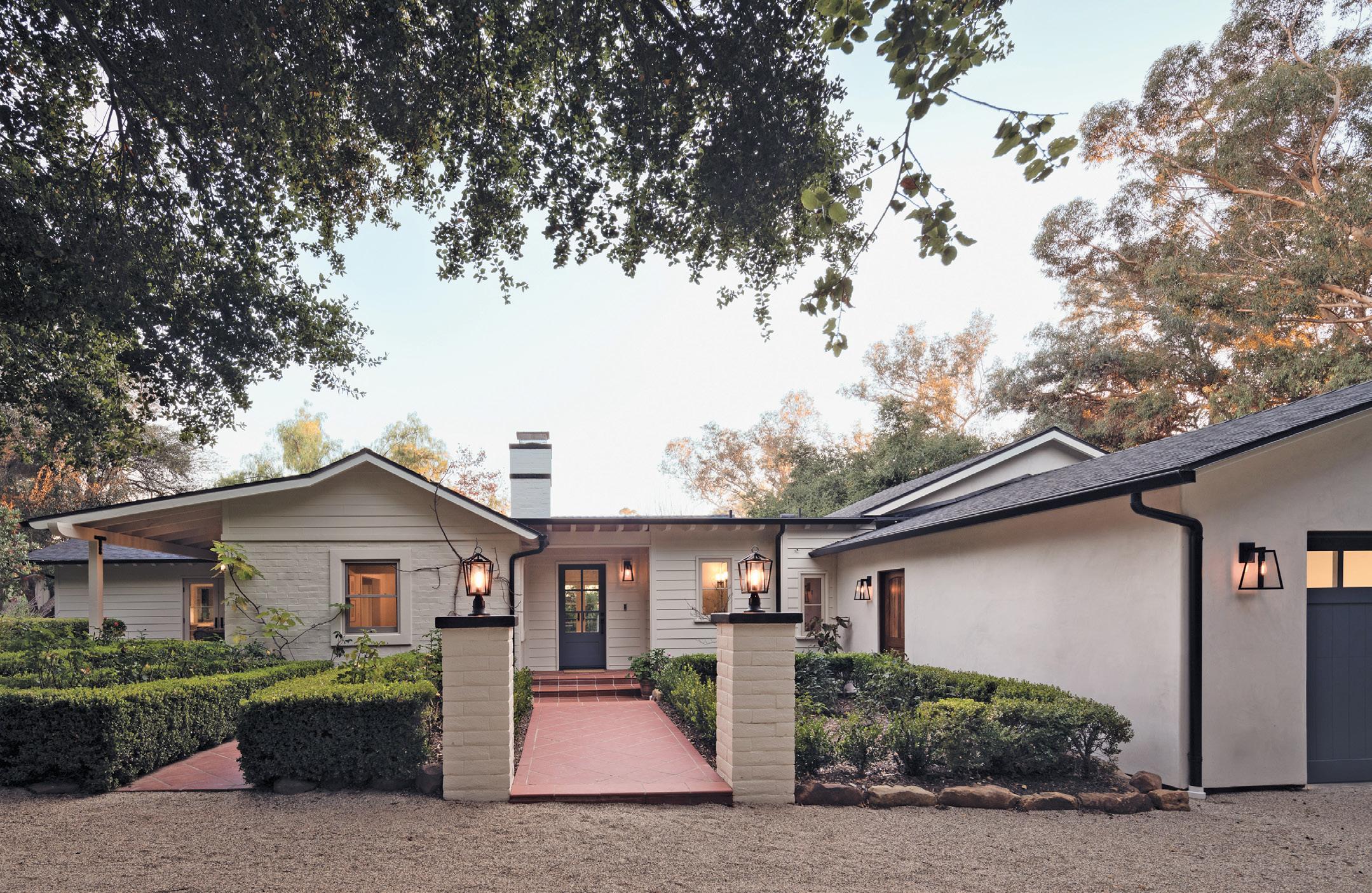

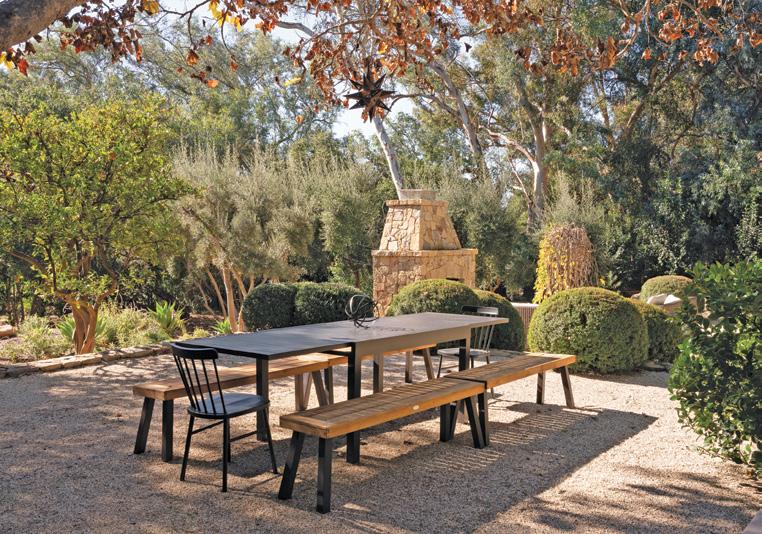
Behind the artistry of stone walls and elegant privacy gate in one of Ojai’s coveted historical neighborhoods, a canopy of mature oaks, pines and palms gives presence to a completely renovated luxurious estate property consisting of 5 structures, sparkling pool and spa amongst a lush terraced landscape designed for elaborate entertaining.
Retaining the heart of its 1940’s cottage origin and infusing the expansion with uncompromised quality and vision; the marriage of old-world aesthetic and luxury level resort-style living has evolved into an extraordinary one-of-a-kind compound where all the work has been done. And truly…. no detail has been spared.
Exquisitely landscaped for privacy and entertaining | Fully renovated, 5,200 combined sq ft.
3 Bedroom Main Residence | New 2 + 2.5 ADU | 1 Bedroom Cottage
Separate Gym | Writers Studio | Pool | Spa | Bocce Court
$9,950,000
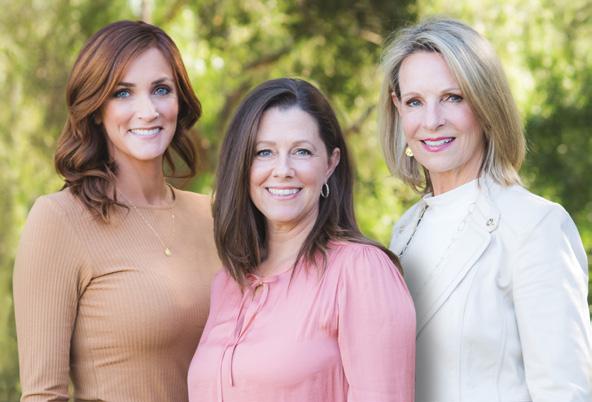
2 OJAI MAGAZINE | SPRING ‘24
•
•
www.MFWrealestate.com
mfwrealtors@gmail.com
805.669.9933

1501 ORCHARD DRIVE
TWO LOTS, 1940’s Cottage, 4 bay carport, workshop, second apartment space, untapped potential, various fruit trees. $1,285,000
312 E. MATILIJA STREET
Rare Work/Live opportunity | 2 offices | 2 car garage | upstairs
3 bed, 2 bath | Prime downtown property with Mixed Use zoning $1,300,000


535 DEL ORO DRIVE
Single Level | 4 bedroom ranch style
3 car garage | Detached workshop Oak studded Acre | Popular neighborhood $2,250,000 SOLD

1198 RAINS COURT
Entertainer’s dream, downtown Ojai, 4 bedrooms and 3 baths, private gated entrance, 1/3rd of an Acre, open oor plan, gourmet kitchen, new pool and spa. $2,100,000
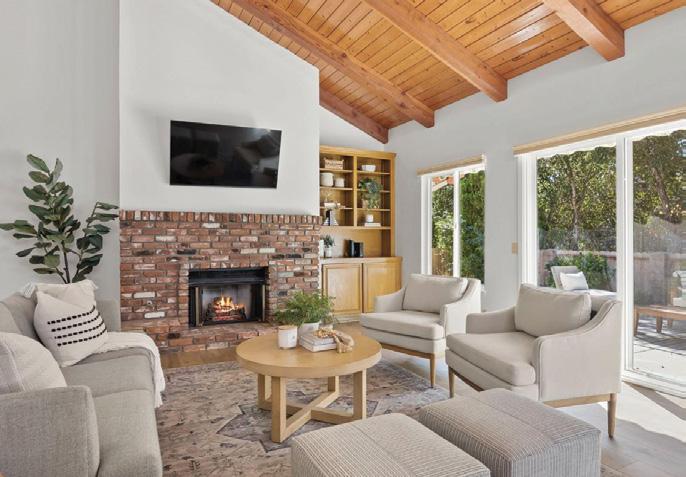
311 W. SUMMER STREET #C
New Flooring | Fresh Paint | Newer
Windows | Downstairs Primary Suite
Close to Town | End Unit with large yard $1,150,000

3 OJAI MAGAZINE | SPRING ‘24 DRE 00878649 | DRE 01708004 | DRE 01414001


5 OJAI MAGAZINE | SPRING ‘24


21-Acre Equestrian Estate with Main House + 8 Rentals, 7 Horse Barns, 20 Co vered Corrals, 4 Arenas, 2 Round Pens, Hay & Equipment Barns, Panel Walker, Entertainment Barn, Archery Range, Mountain Views & More. RanchoRoyaleOjai.com | $8,199,000
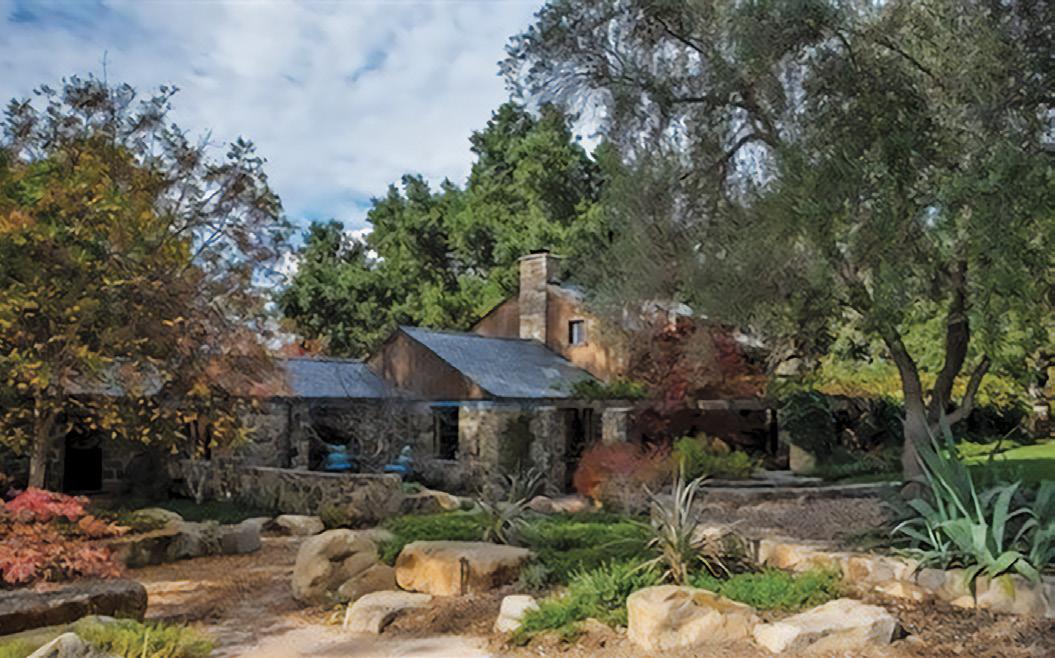
ARBOR HOUSE
Three-Bedroom Main House with Fireplace and Wood Floors on Three Acres in the East End with Separate O ce, One-Bedroom Guest House, Pool and Spa, Solar Panels, Bocce Court, Multiple Outdoor Living Areas | $3,790,000
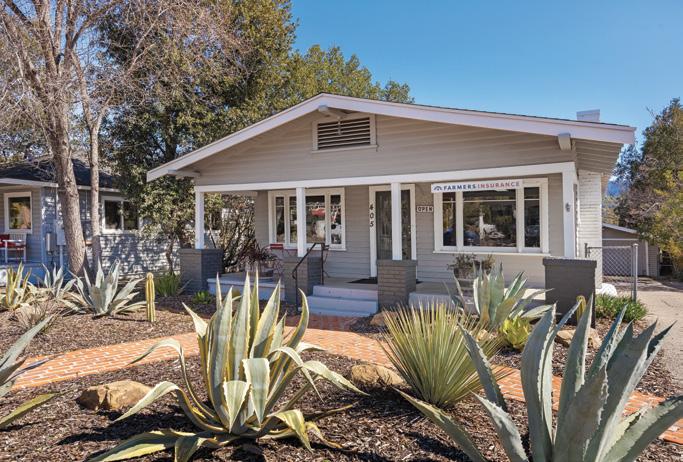
OJAI AVENUE COMMERCIAL PROPERTY
Commercial Property with Great Ojai Avenue Location, Private Parking Lot, Four Office Spaces, Kitchen, Two Bathrooms, Garage 405WestOjaiAvenue.com | $1,345,000

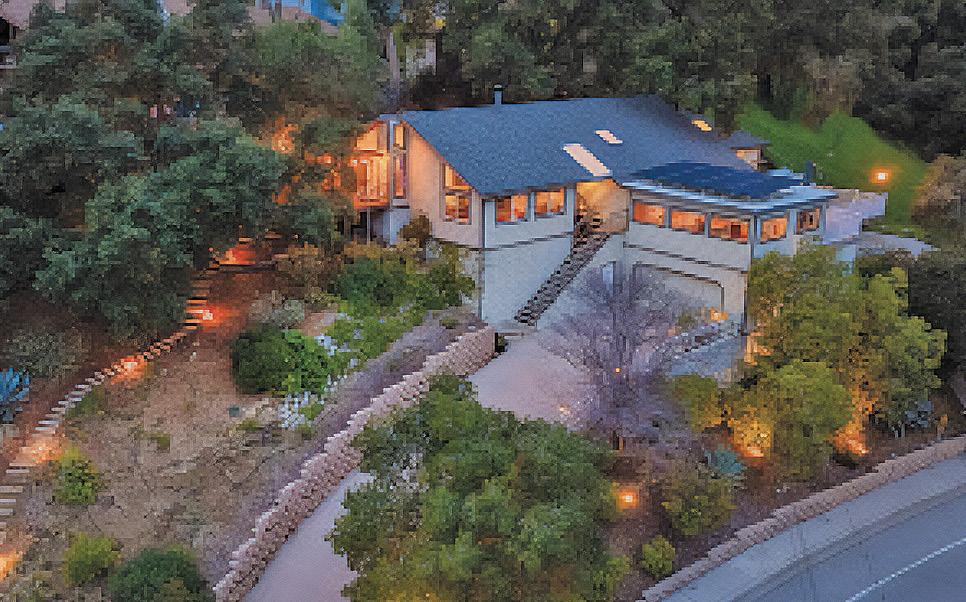
SKY VIEW TERRACE
Three Bedrooms + O ce with Fireplace, Wood Floors, Vaulted Ceilings, Breakfast Bar, Trex Decks, Wet Bar, Over-Sized Garage, Two Driveways, Fruit Trees, Solar Panels, Natural Light, and Mountain Views. | $959,000

BRYANT PLACE COMMERCIAL PROPERTY
Ojai Commercial Property with Parking Lot, Showroom, Workshop, Office, Breakroom or Storage Room, Two Bathrooms, and Great Location in Industrial Area Evolving into Hip Entertainment District 907BryantPlace.com | $1,785,000

UPPER OJAI LAND
Build your dream home on 1.25 acres in Upper Ojai with 20-25gpm well, water meter, Edison drop, and beautiful mountain views minutes from downtown Ojai. | $697,500
6 OJAI MAGAZINE | SPRING ‘24 Integrity, knowledge and experience you can trust
RANCHO ROYALE


Gated, Five-Acre Country Estate with Main House, Guest House, Workshop, Pool & Spa, Outdoor Kitchen, Sports Court, Two Fireplaces, Multiple Outdoor Living Areas, Orchard, Patio Fireplace, Solar Panels & Mountain Views. 705RiceRoad.com | $5,000,000

Fully Remodeled Five Bedroom, Five Bathroom Mid-Century Modern with Spanish Colonial In uence with Brazilian Wood Floors, Pool & Spa, Two Primary Suites, Guest Quarters, Media Room, Amazing Views 276RunningRidgeTrail.com | $3,499,000

ROSE VALLEY LAND
Create an off-grid, country retreat on 40 acres with mountain views, trails, and a natural spring in Rose Valley in the Los Padres National Forest.
$1,200,000

5 Bedrooms, Upscale Finishes Throughout, Media Room, Wine Cellar, Tasting Room, Gym/Massage Room, Pool & Spa, Putting Green, Well, Six-Car Garage, Bocce Court, Views, and So Much More RoyalOaksRanchOjai.com | PRICE UPON REQUEST

RIVERSIDE DRIVE
Two Bedroom, Two Bathroom Manufactured Home + Outbuildings on Flat, Usable, .81-Acre Horse Property Close to Lake Casitas and Oak View Shops & Restaurants

OAK VIEW RAMBLER
Three Bedrooms, 2.5 Bathrooms, Huge Family Room, Hardwood Floors, Over-Sized Soaking Tub, Lots of Closets, Breakfast Bar, and Mountain Views
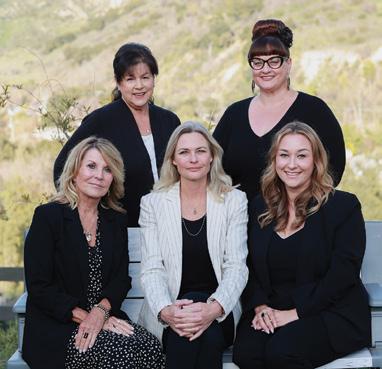
THE DAVIS GROUP
Nora Davis
805.207.6177
nora@ojaivalleyestates.com
www.ojaivalleyestates.com
727 Ojai Avenue, Ojai CA 93023
DRE 01046067
7 OJAI MAGAZINE | SPRING ‘24
Integrity, knowledge and experience you can trust
RUNNING RIDGE RETREAT
$899,000
$899,000
ROYAL OAKS RANCH
FROG RIVER RANCH



9 OJAI MAGAZINE | SPRING ‘24
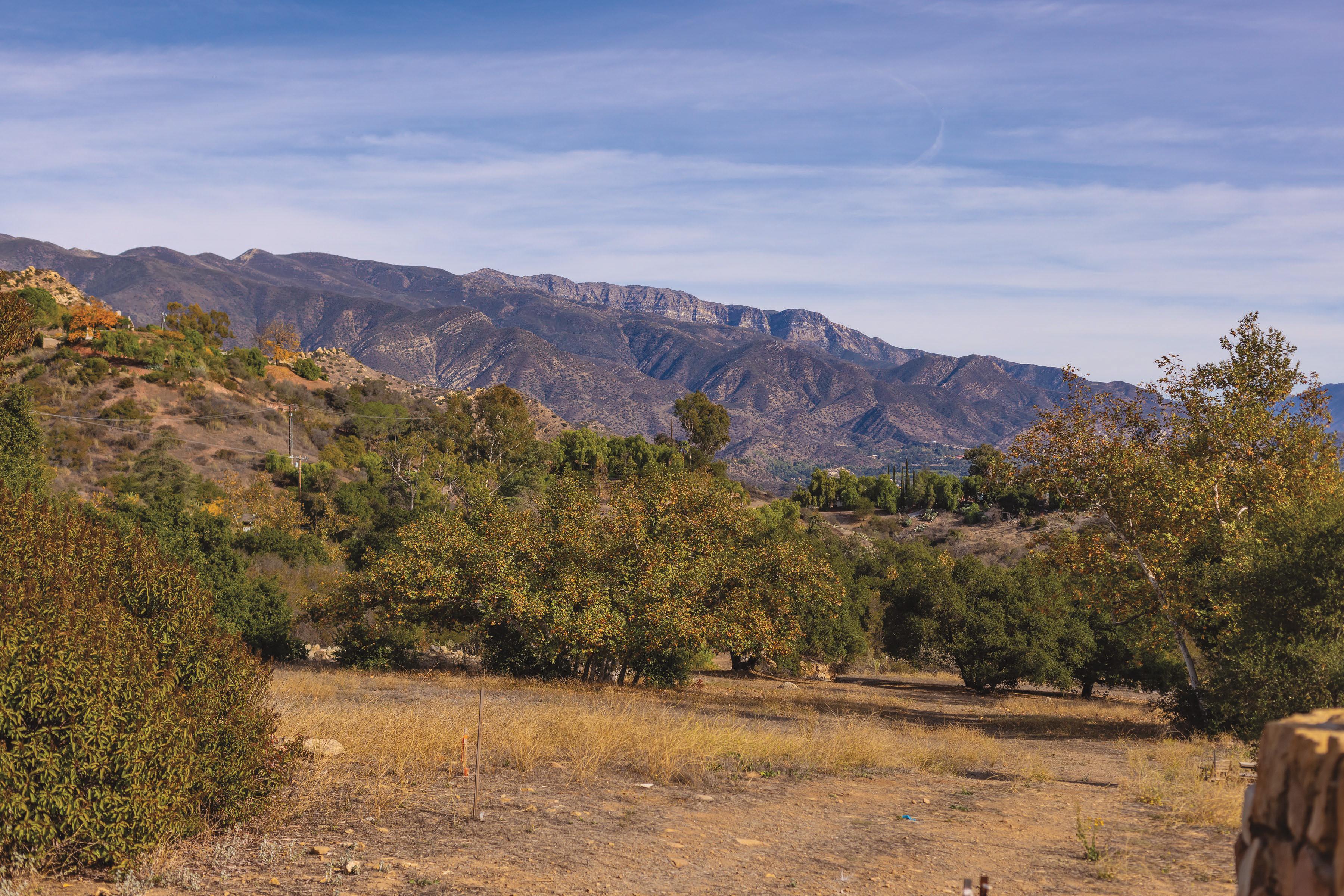


RARE DOWNTOWN VIEW LOT
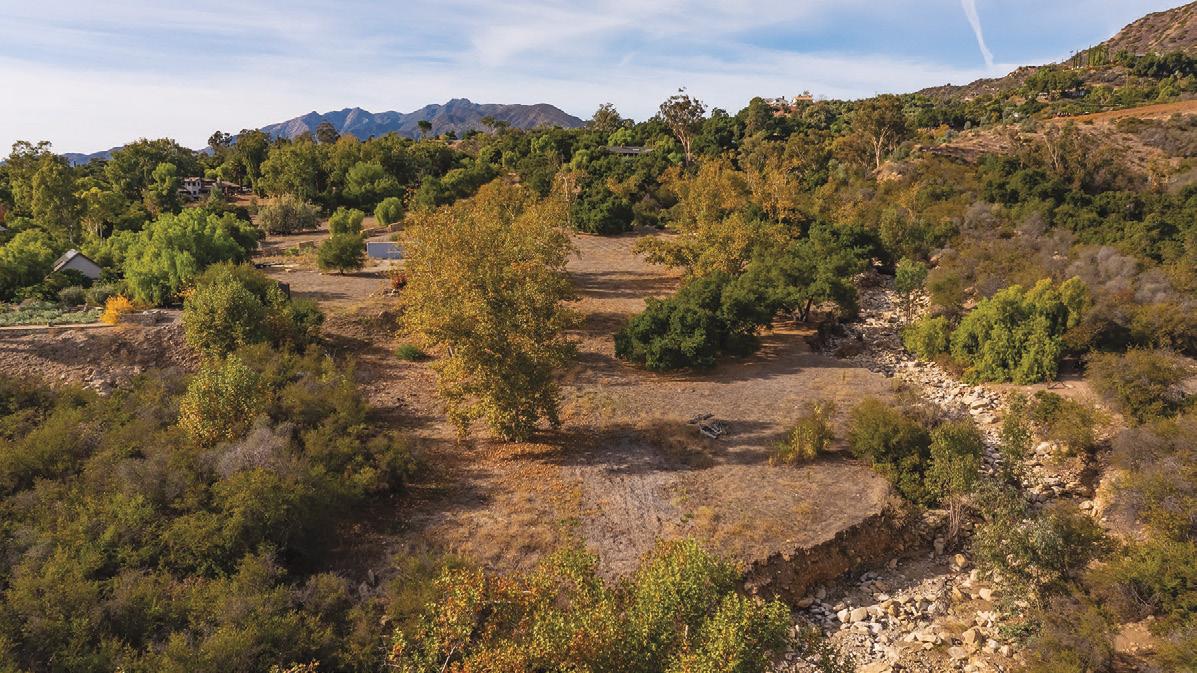
This gorgeous 5.25 acre property accessed by gated entry from Foothill Rd has meadows and ancient oaks decorating a unique expanse of usable land. Totally private and inviting, it is bordered by the undeveloped hillsides of Stewart Canyon and has easy access to the Pratt Trail and Shelf Road. Unobstructed views of the Topa Topas and surrounding mountains make this an ideal location for a fabulous home, a horse property, a large retreat compound or anything you can imagine. It is adjacent to two other available lots which could create a fabulous 22 acre lot.
1218FoothillRdOjai.com

Offered at $2,750,000
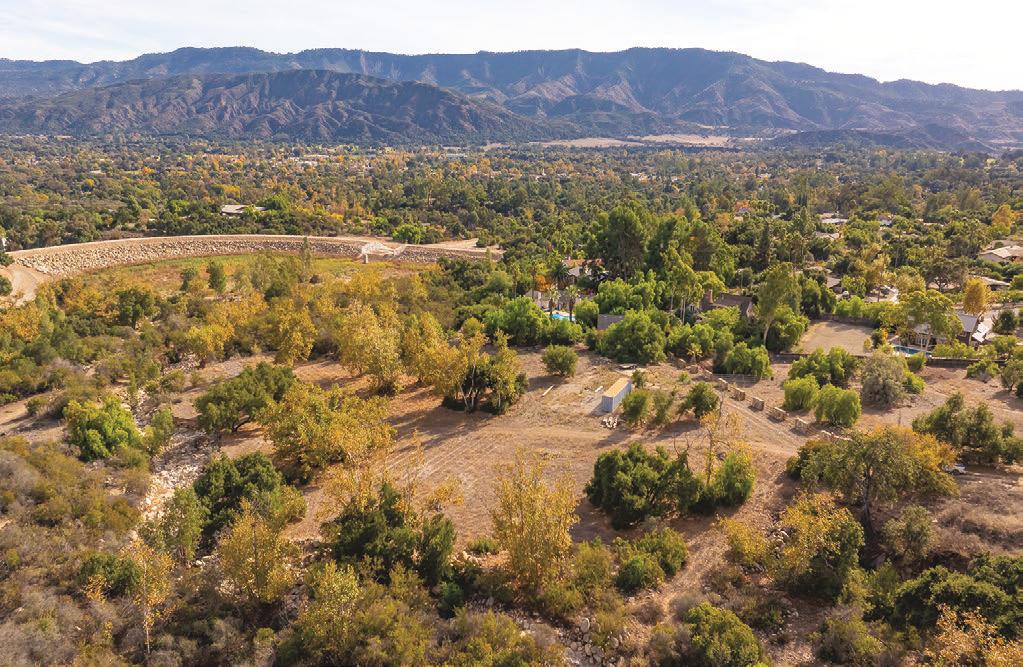
Over 25 years of experience matching people and property in the Ojai Valley © 2023 Berkshire Hathaway HomeServices California Properties (BHHSCP) is a member of the franchise system of BHH Affiliates LLC. BHHS and the BHHS symbol are registered service marks of Columbia Insurance Company, a Berkshire Hathaway affiliate. BHH Affiliates LLC and BHHSCP do not guarantee accuracy of all data including measurements, conditions, and features of property. Information is obtained from various sources and will not be verified by broker or MLS. Buyer is advised to independently verify the accuracy of that information. DRE# 01176473 (805) 340-3774
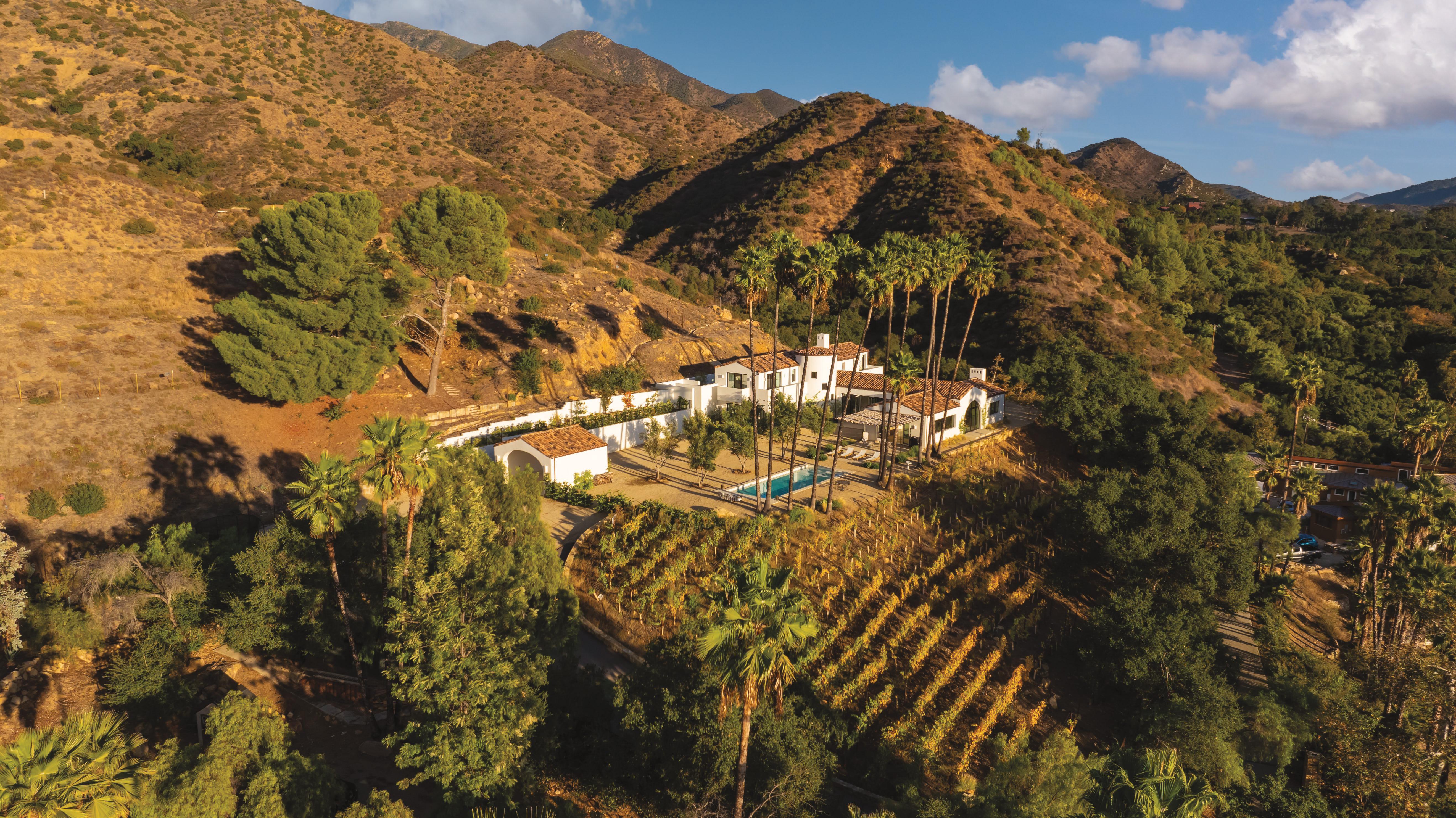
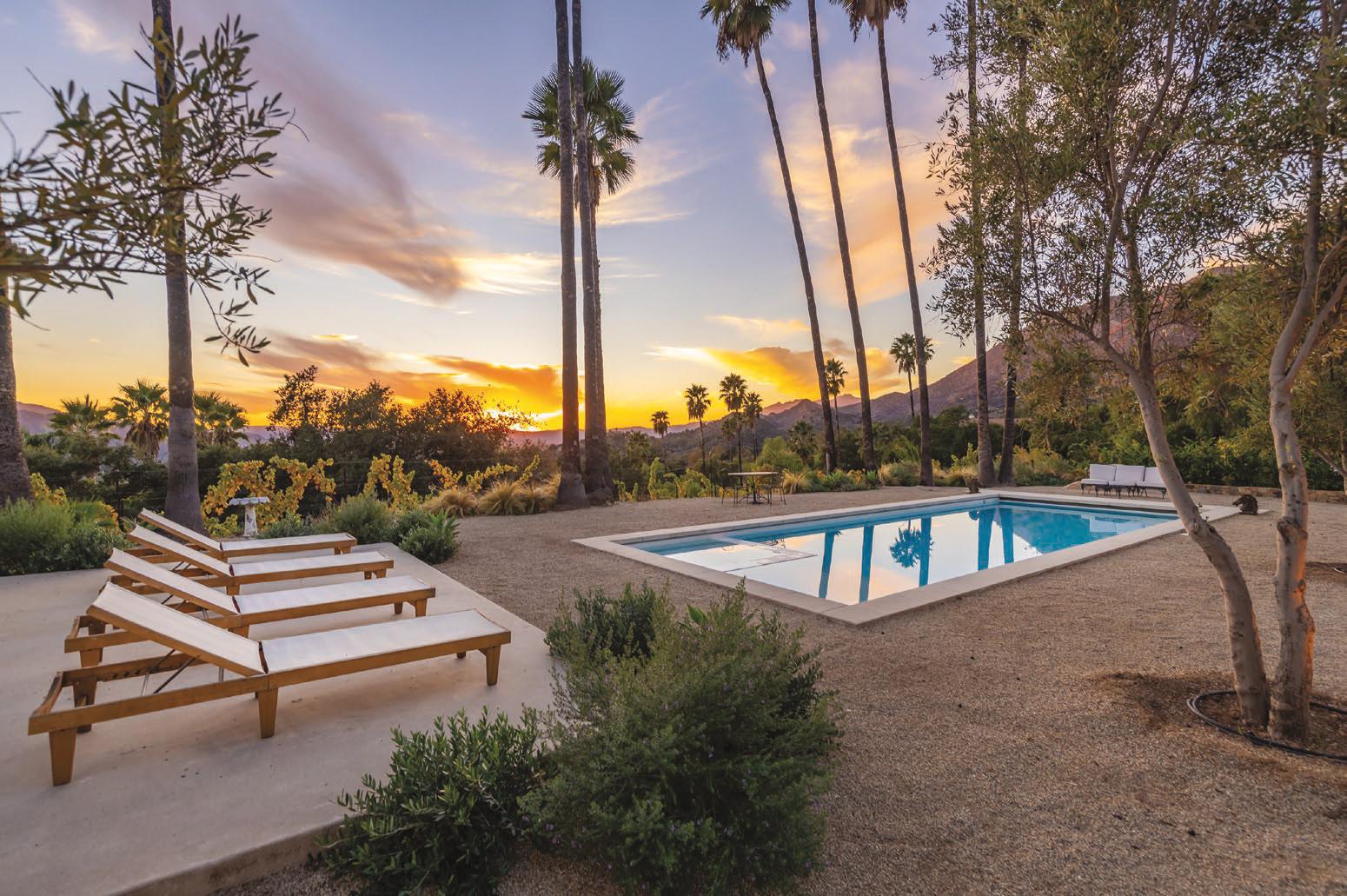

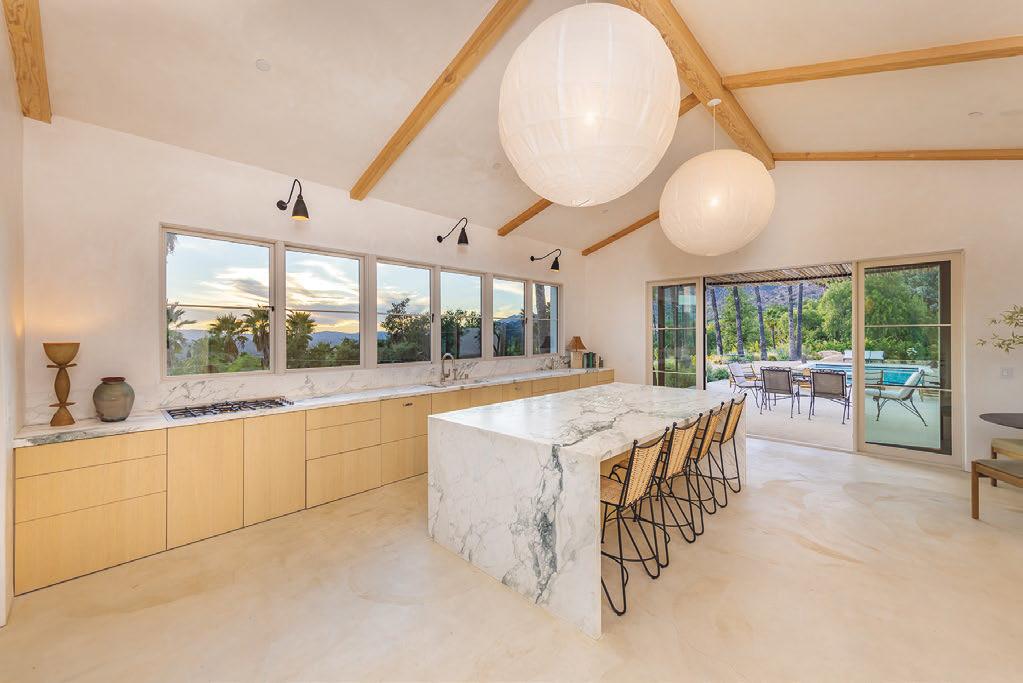
PINK MOMENT ESTATE
A luxury villa/vineyard estate providing the ultimate in architecture, design, craftmanship, and setting. Brand new construction of the 5100 sqft, 4br/5ba home is finished with the highest quality materials, appliances and fixtures. An H-shaped floorplan separates private sleeping areas from public social areas. The open living area includes a chef’s kitchen, a 2-sided fireplace, and a wine tasting room. The grounds feature a 100% organic vineyard, pool/spa with epic views, and multiple courtyards and verandas to take full advantage of the spectacular natural setting.
2259McNellRoadOjai.com


Offered at $10,725,000

www.pattywaltcher.com pattywaltcher@mac.com (805) 340-3774 DRE# 01176473 I will help you find the home that brings peace to your mind and heart © 2023 Berkshire Hathaway HomeServices California Properties (BHHSCP) is a member of the franchise system of BHH Affiliates LLC. BHHS and the BHHS symbol are registered service marks of Columbia Insurance Company, a Berkshire Hathaway affiliate. BHH Affiliates LLC and BHHSCP do not guarantee accuracy of all data including measurements, conditions, and features of property. Information is obtained from various sources and will not be verified by broker or MLS. Buyer is advised to independently verify the accuracy of that information.

12 OJAI MAGAZINE | SPRING ‘24

Volume 42 No.1
EDITOR’S NOTE - 22
COVER STORY:
Bryan Brothers at The Ojai Tournament - 28
BIG ISSUES
Common Ground movie - 34
RFK Jr. Stumps in Ojai - 44
Radioactive Rain, Santa Susana Field Lab - 60
LOOKING BACK
Bionic Duo from a Simpler Time - 52
Six Degrees of Krishnamurti - 84
EVENTS
Mitsuko Uchida at Ojai Music Festival - 72
Calendar - 80
ART & CULTURE
Jacey Clear, Renaissance Man - 94
Haunted Treasures? - 102
FARM
Totem Biodynamic Ranch - 110
FOOD & WINE
Farmer and the Cook’s Book - 118
Uncorking The Naturalist Organic Winery - 124



14 OJAI MAGAZINE | SPRING ‘24 28 44 118
84 72
94
52 SPRING 2024
805-646-1476 ojaivalleynews.com/magazine U B E SC R I B S



16 OJAI MAGAZINE | SPRING ‘24

17 OJAI MAGAZINE | SPRING ‘24

18 OJAI MAGAZINE | SPRING ‘24
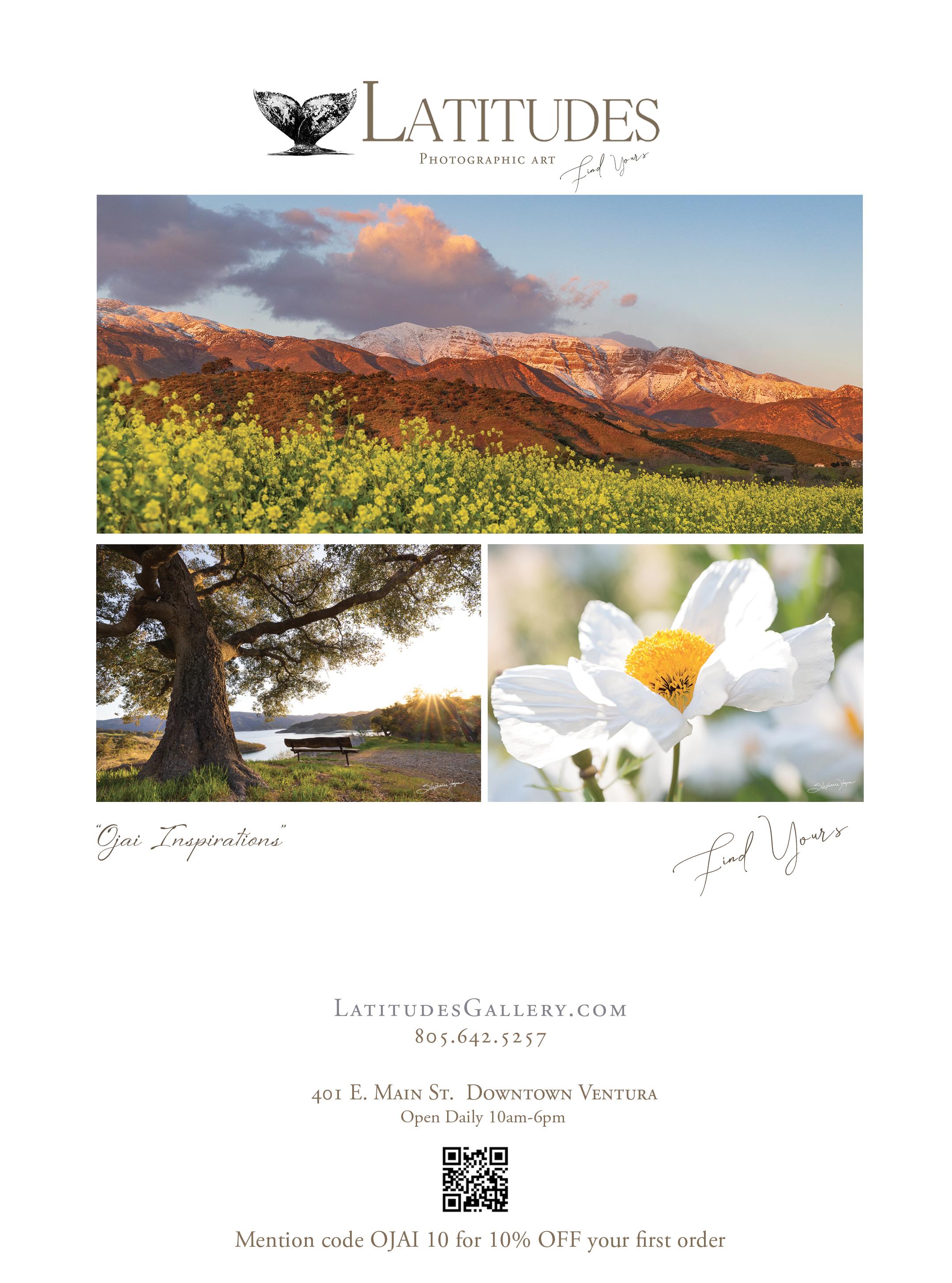
19 OJAI MAGAZINE | SPRING ‘24
Benvenuto

to 605 Country Club Drive



This Bill Mahan designed Tuscan style home is almost a mirror image of his other architectural masterpiece, the neighboring Ojai Valley Inn. This home is an entertainer’s delight with the Ojai Valley Inn almost as your backyard; go to the Spa, play a round of golf, eat at the best restaurants Ojai has to offer or just walk the beautiful grounds. Surrounded by incredible views with multiple outdoor dining spaces and a beautiful pool and jacuzzi, the property is completely enclosed for those who seek privacy, yet conveniently close to downtown Ojai, easily accessible by way of the nearby bike path. This private home of 3624 sq.ft. has 5 fireplaces, 4 bedrooms, 3 1/2 baths, a media/ family room, an eat-in kitchen with fireplace, a large pantry, a laundry room, and two separate garages. The marvelous, private primary suite includes a wonderful spa-like bathroom with a fireplace and large amounts of closet space. Offered at $4,250,000

SALES, RENTALS AND MANAGEMENT
Ojaipropertygroup@gmail.com
Ojaipropertygroup.com
Dave Lynn | 805.207.8122 | DRE #01962468
Kellye Lynn | 805.798.0322 | DRE #01962469

20 OJAI MAGAZINE | SPRING ‘24

21 OJAI MAGAZINE | SPRING ‘24
EDITOR’S NOTE: SPRING 2024
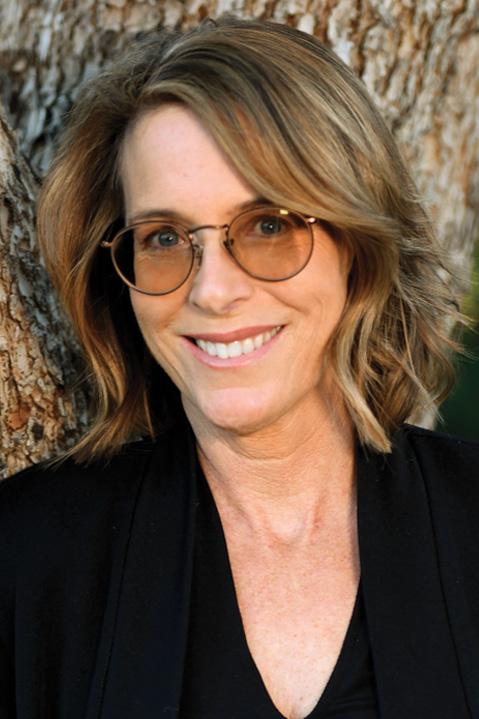
Ojai is having an identity crisis.
It’s complicated … Some see a quiet retired civic-centered community, with spiritual, nature-loving, hill-climbing, health-focused mindful progressives. Yet one can’t miss the truck-driving, straightshooting generational ranchers and townies holding tight to Ojai’s past “small-town character.” Are we rather a wealthy enclave of urban drop-outs and hipsters seeking their soul’s rest in the simple life. Or longtime residents struggling to maintain Ojai Valley housing and survive the cost-of-living-creep in a tourist town with a vulnerable economy. Others hang with a collection of artists, healers and life-coaches playing pickleball with post-radicals and progressive environmentalists. And there are those plugged into the discord over at City Hall — a riveting drama unfolding biweekly, and spilling ink on the front pages of newspapers near and far.
On the lips of these myriad cliques, clacks, and quacks are mutterings of the town’s cultural destruction — and the worst is feared. The reasons are diverse but always fearful, as an agitated mind grasping for disparate solutions.
Maybe Ojai will seek its next version rather than a permanent identity. All about town I meet and hear from people with energy, intention, and plans to create — a restaurant, a healing class, an apartment complex, a mural, a movie theater, a park, a bridge, a book, a greenhouse — all to make Ojai an exceptional place to live. As I listen to the personal stories of pain and sorrow and hear the dreams, values, and beliefs described by my neighbors, I catch onto their enthusiasm for life. I trust that Ojai will keep transforming.
Krishnamurti has taught me there is no right path. The Alexander Technique teaches that we never arrive, we only aim for balance on a moment to moment basis. Our goal to be happy, healthy, and with security, justice, and peace are common drivers. What if we realized we all are pulling in the same direction? It is for each of us to stay curious about the world and each other, to realize what we already have, then click our heels together and say, “there’s no place like Ojai.”
Read on, and be inspired by our Ojai Magazine Spring issue story-makers and the enormous power of their believing:
The regenerative way our planet may thrive into the future, and then the story of one farmer doing it: Common Ground the movie and Totem Biodynamic Ranch. Uncovering the toxic darkness of a past disaster, and the man who never gives up: Radioactive Rain, Santa Susana Field Lab. A voice for a di erent kind of leadership: RFK Jr. Stumps in Ojai. A pictorial memory of our heroes circa 1973: The Bionic Duo from a Simpler Time. Finding meaning through the threads of a personal journey of discovery: Six Degrees of Krishnamurti. A visit from world-class musician Mitsuko Uchida, and the local artist and Renaissance man, Jacey Clear, for whom “Every dream I ever had has come true.”
With affection,
Laura Rearwin Ward
MAGAZINE
Paul Stanton
Karen Lindell
Karen
David LaBelle
Erin LaBelle
Holly Roberts
Ti any Paige
Mimi Walker
Tori

©2024 Ojai Media LLC
EDITOR/PUBLISHER
Laura Rearwin Ward ART DIRECTOR
ASSISTANT EDITOR
WRITERS
Lindell Perry Van Houten Kit Stolz
Kerstin Kühn
Alula Alderson PRODUCTION SUPPORT
ADVERTISING
Behar, Mimi Walker Georgia Schreiner
director
Linda Snider,
of sales
CONTACT
Ally Mills, Kim Klester
magazine@ojaivalleynews.com advertising@ojaivalleynews.com
www.ojaivalleynews.com/magazine @ojaimag
Cynthia
Cover photo:
Lum @cynthia.photo
22 OJAI MAGAZINE | WINTER ‘23 22 OJAI MAGAZINE ‘23
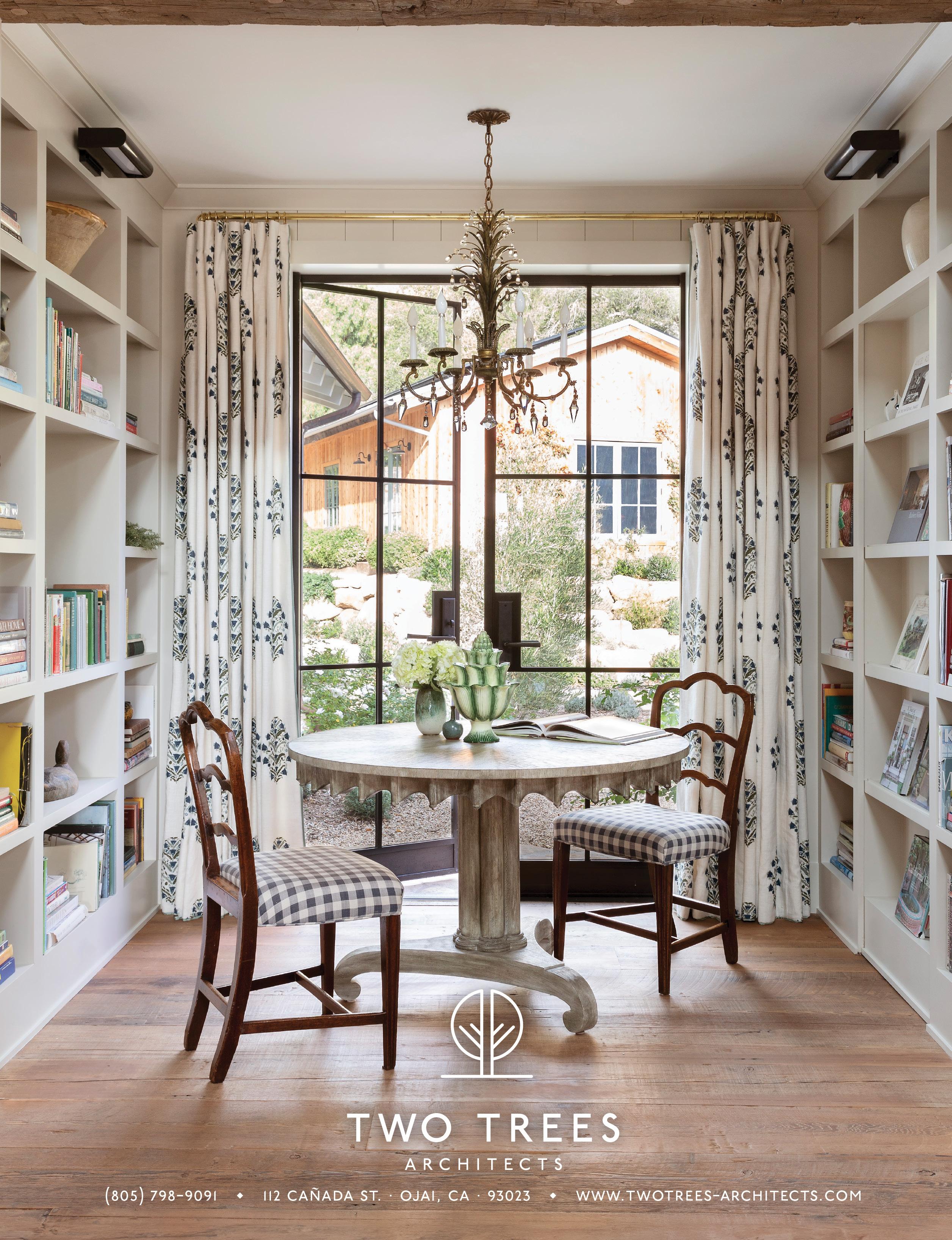
23


25 OJAI MAGAZINE | SPRING ‘24

26 OJAI MAGAZINE | SPRING ‘24


27 OJAI MAGAZINE | SPRING ‘24
As one of the oldest-running tennis tournaments in the nation, The Ojai has inspired young players to future successes, and in many cases, greatness took root under the oak-studded canopy of Ojai’s Libbey Park. To play in the tournament is to become part of the fabric of the 122-year history of The Ojai Tennis Tournament.
Initiated by William B. Thacher in 1896 for Ojai Valley tennis players to test their grit against players from nearby Ventura,
who traveled by horse, The Ojai grew in scope and size, crossing two century marks, to encompass five separate tournaments within one. Players from around the world compete in Juniors, CIF-SS, Community and Independent Colleges, the Pac-12 Championships (the final one will be in 2024), and the Open.
In this 122nd Ojai (April 24-28), the Ojai Valley Tennis Club (OVTC), a nonprofit formed to implement the annual tournament and support youth tennis programs, is honoring Mike and Bob
Bryan, a doubles team like no other in the history of tennis.
Beginning at age 5, The Bryan brothers came to Ojai from their home in Camarillo to watch their parents, Kathy and Wayne Bryan, compete in the Open Doubles division at The Ojai in the early 1980s.
“As little kids, what we loved most were the free and unlimited amount of cookies and orange juice (we got), and also trying to catch frogs down by the creek,” Bob Bryan said. “We just glanced at the tennis

e Bryan brothers

Above: Bob and Mike age 1 with parents, Kathy and Wayne Bryan
Right: 1990 Men’s Pac-10 Doubles Champions
 by HOLLY ROBERTS
Photo courtesy the Bryan family
by HOLLY ROBERTS
Photo courtesy the Bryan family
28 OJAI MAGAZINE | SPRING ‘24
Photo courtesy Ojai Valley Tennis Club
then, but it made a huge impression on us and inspired us to play more in hopes of someday being good enough to play in the tournament. Mike and I are very appreciative to be coming back to The Ojai in April.”
Mike and Bob Bryan won five championship titles at The Ojai in the 1990s, including the Boys 16s Division in 1993 and 1994, high school CIFSS in 1995 and 1996 with Rio Mesa High School, and the 1998 Pac-10
Championships with Stanford, before going pro.
The mirror twin brothers once held a 116 consecutive game-winning streak, until finally losing their first game in the second set of a quarterfinal match against Steve Seybold and Aaron Talarico from Laguna Beach High School in The 97th Ojai. They still won the match and took the CIF-SS Doubles title that year.
“The Ojai, of course, was so inspirational to all the young players in Ventura
County and across SoCal. We loved getting out of school, to not only compete in the tournament, but also to be able to watch, up close, the star players from USC, UCLA, Stanford, and Cal,” Mike Bryan said.
“The crowds were always large and enthusiastic, and the atmosphere at Libbey —with all the oaks and natural beauty —was just so unique. Bob and I are very happy and proud to be coming back to the tournament this year.”

honored at e 122nd Ojai
 At the 2011 Wimbledon Championships
At the 2011 Wimbledon Championships
29 OJAI MAGAZINE | SPRING ‘24
Photo courtesy Ojai Valley Tennis Club
Bob and Mike Bryan’s mother, Kathy Bryan, a former professional tennis player, talked about the impact of playing at The Ojai and introducing the tradition to her sons: “I loved The Ojai and had a wonderful time playing there in the Juniors and later in the Open division. I hoped Mike and Bob would someday want to play there and get to experience that very special atmosphere.
“It is truly a wonderful event and has a long and storied history. So, so many great champions have competed there and the traditions are so unique. It is played not only at Libbey, but at private courts, high schools, and clubs throughout Ventura County. It has a very family atmosphere.”
The Bryan brothers began competing at The Ojai by age 10 in the Boys 14s division. Their father and coach said the first goal he set for the boys was for them to be good enough to play at The Ojai, and the second goal was to try to win an Ojai title. “I have always said in my talks and writings that ‘Champions take it in through their eyes more than their ears,’” Wayne Bryan said. “‘You must see it before you can dream it, and you must be passionate about it before you can achieve it.’
“The jewel-like Ojai Tournament is just the perfect event to inspire young players. It was so, so motivational for Mike and Bob, and so many of the juniors that I have worked with through the years.”
After the Bryan brothers’ early successes at The Ojai, they went on to earn an unprecedented string of professional honors, breaking U.S. and world records as the winningest doubles team ever in the Open Era. Their astounding doubles team records include most Grand Slam titles (16), a record 119 match titles, and 1,107 match wins throughout their careers together. Mike Bryan tops the all-time doubles match win leaderboard since 1973 with 1,141, while Bob Bryan is second on that list with 1,100.
Bob and Mike Bryan have so many “most” and “only” records, it boggles the mind. To name just a few more of their “most” career records: most times year-end No. 1 doubles team (10); most weeks at No. 1 (Mike with 506; Bob with 439; John McEnroe is third with 270); most wins by
a U.S. Davis Cup doubles team (25); most ATP Masters 1000 doubles titles (39 Career Golden Masters); and most points ever amassed in The Race during a season by a singles player or doubles team (15,110 in 2013, while the second-place team had 7,640).
Mike and Bob Bryan are currently the “only” doubles team to attain records such as only team to win the Olympic Gold medal, plus four consecutive Grand Slam


titles (Bryan Golden Slam); only team to win every Grand Slam at least twice; only team to go undefeated (4-0) in a Davis Cup seasonx twice (2005 and 2007); only team to win a Grand Slam title for 10 consecutive years (2005-2014); only team or individual player to win at least five titles for 14 straight years; only team to win over 1,100 matches (“The Woodies,” Todd Woodbridge and Mark Woodforde, are second with 508); only team to win 60 matches in a season for 10 straight years; and only team to win at least one title for 20 straight years.
In the 2012-13 year alone, the Bryan brothers won the 2012 London Olympics and the 2012 US Open, then the Australian Open, the French Open, and
Wimbledon all in 2013. Retired in 2020, Mike and Bob Bryan are still active in the tennis world. Bob Bryan was named U.S. Davis Cup captain in 2023, and both brothers participate in occasional legends exhibitions, and the Bryan Brothers Foundation, a nonprofit that supports youth development. Both are musicians and enjoy playing in the Bryan Brothers Band.
Just as the Bryan brothers did, when the tender green grass shoots begin to grow after spring rains, and the creeks burble with Topatopa Mountains snow runo , hundreds of junior, collegiate, and professional tennis players will make the trek up the winding valley road to compete against the best tennis players around, continuing the Ojai tradition. The garden tea tent will house hand-poured tea and cookies; Ojai fresh-squeezed orange juice will be served by some of the more than 600 countywide volunteers who make the tournament happen; and the 14-year ATP World Tour Fan Favorite Award-winning Bryan brothers will be honored.
“I salute all the sta and volunteers that have created and kept these wonderful traditions through the years,” Wayne Bryan said. “These people are all so dedicated to the event and to our sport. They all have hearts of gold and create such a warm and hospitable environment for both the players and fans. The tournament is a celebration of tennis and life.
“Our entire family has loved the tournament and we have all enjoyed not only competing there, but also watching so many epic matches. I am so proud that Mike and Bob are coming back to support The Ojai this April. We look forward to seeing lots of our tennis friends and being able to thank the sta and volunteers in person.”
The 122nd Ojai Tennis Tournament will honor the Bryan brothers for their long association with the tournament and their incredible professional accomplishments on Friday, April 26, with an OVTC fundraising dinner at the Ojai Valley Museum. The event will feature guest speakers, as well as a performance by the Bryan Brothers Band. Visit theojai.net for more information.
The Bryans win at the US Open in 2014 — their 100th match title.
30 OJAI MAGAZINE | SPRING ‘24
Photo: Cynthia Lum

31 OJAI MAGAZINE | SPRING ‘24
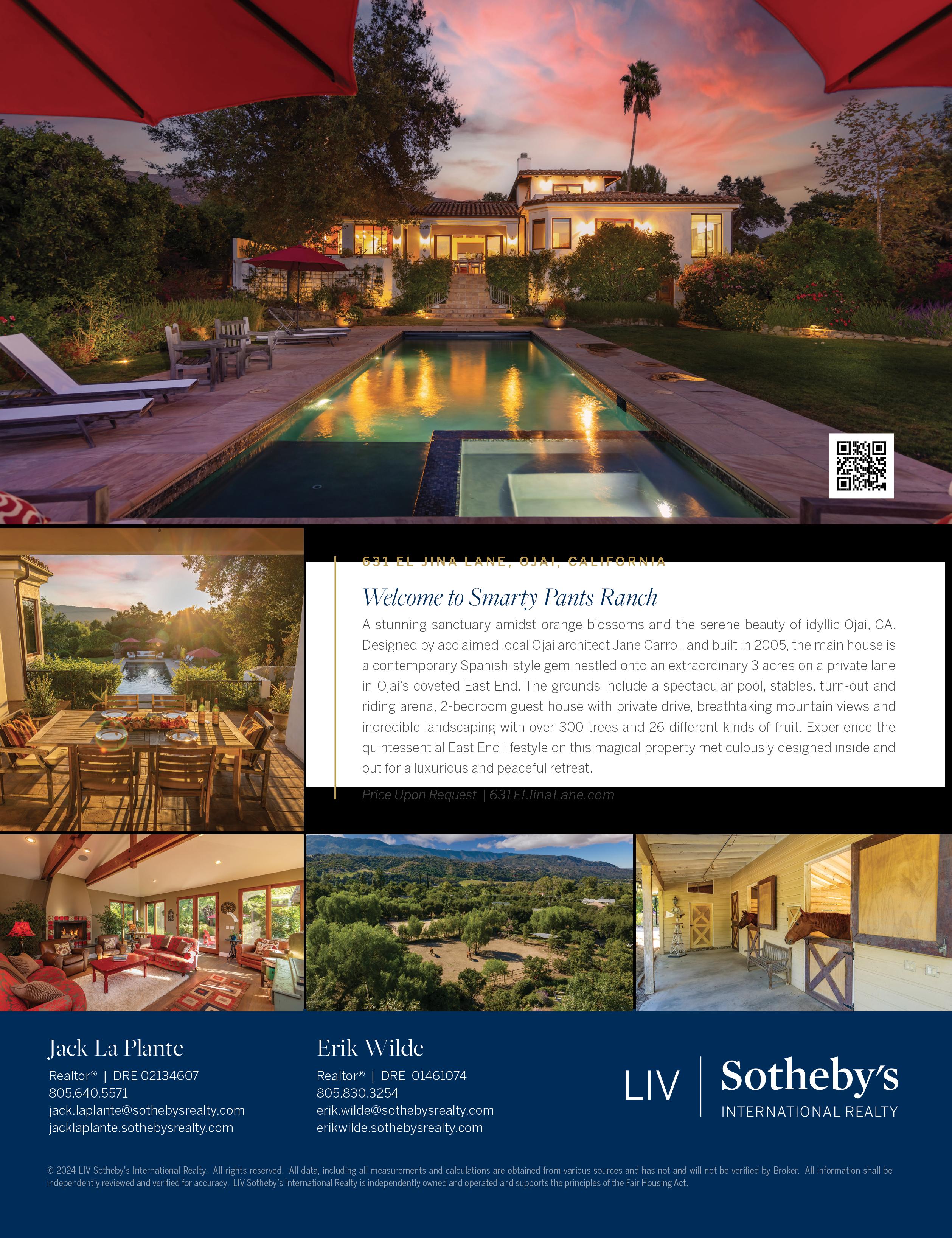
32 OJAI MAGAZINE | SPRING ‘24

33 OJAI MAGAZINE | SPRING ‘24
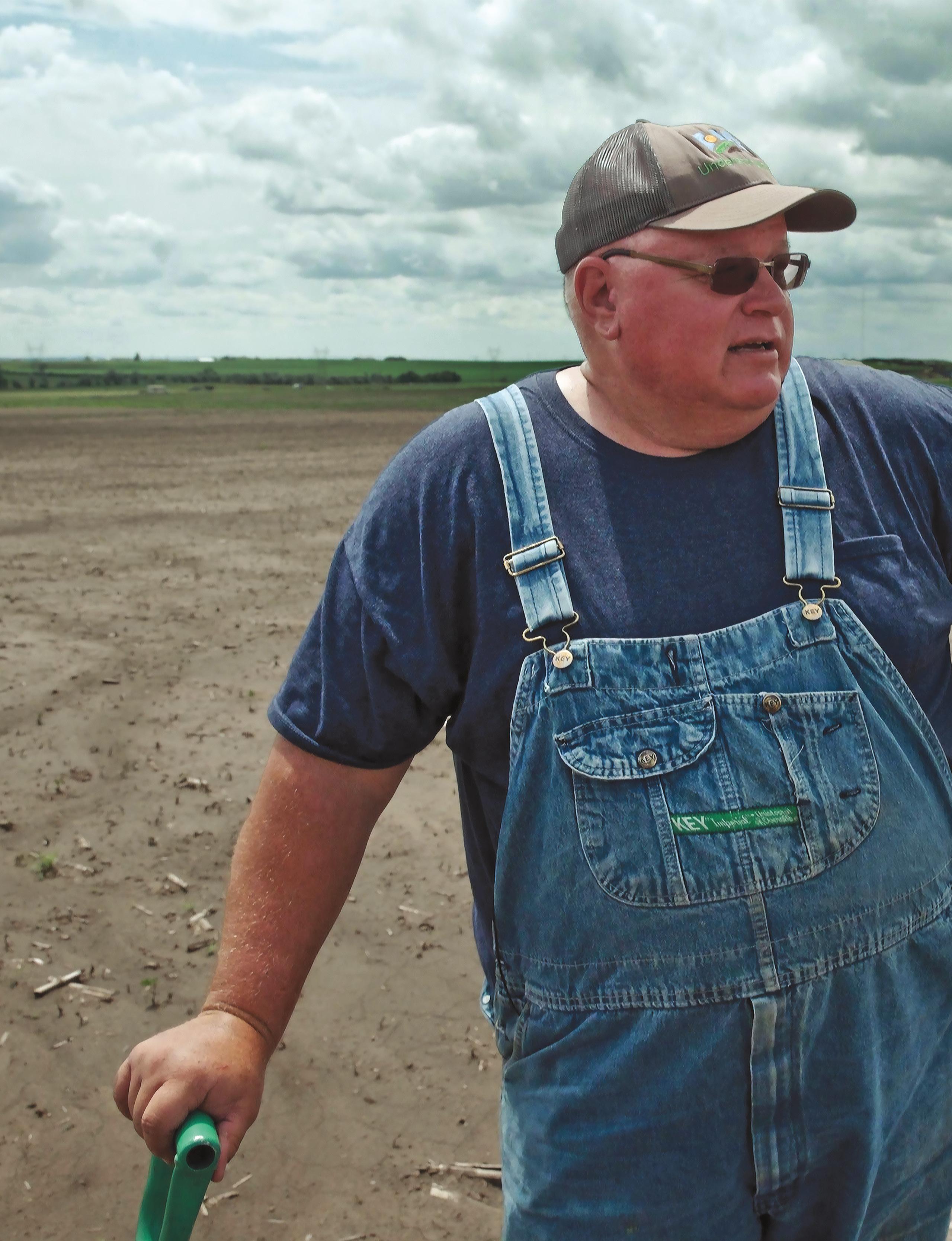
34 OJAI MAGAZINE | SPRING ‘24
Gabe Brown at his neighbor’s desertified ranch in North Dakota

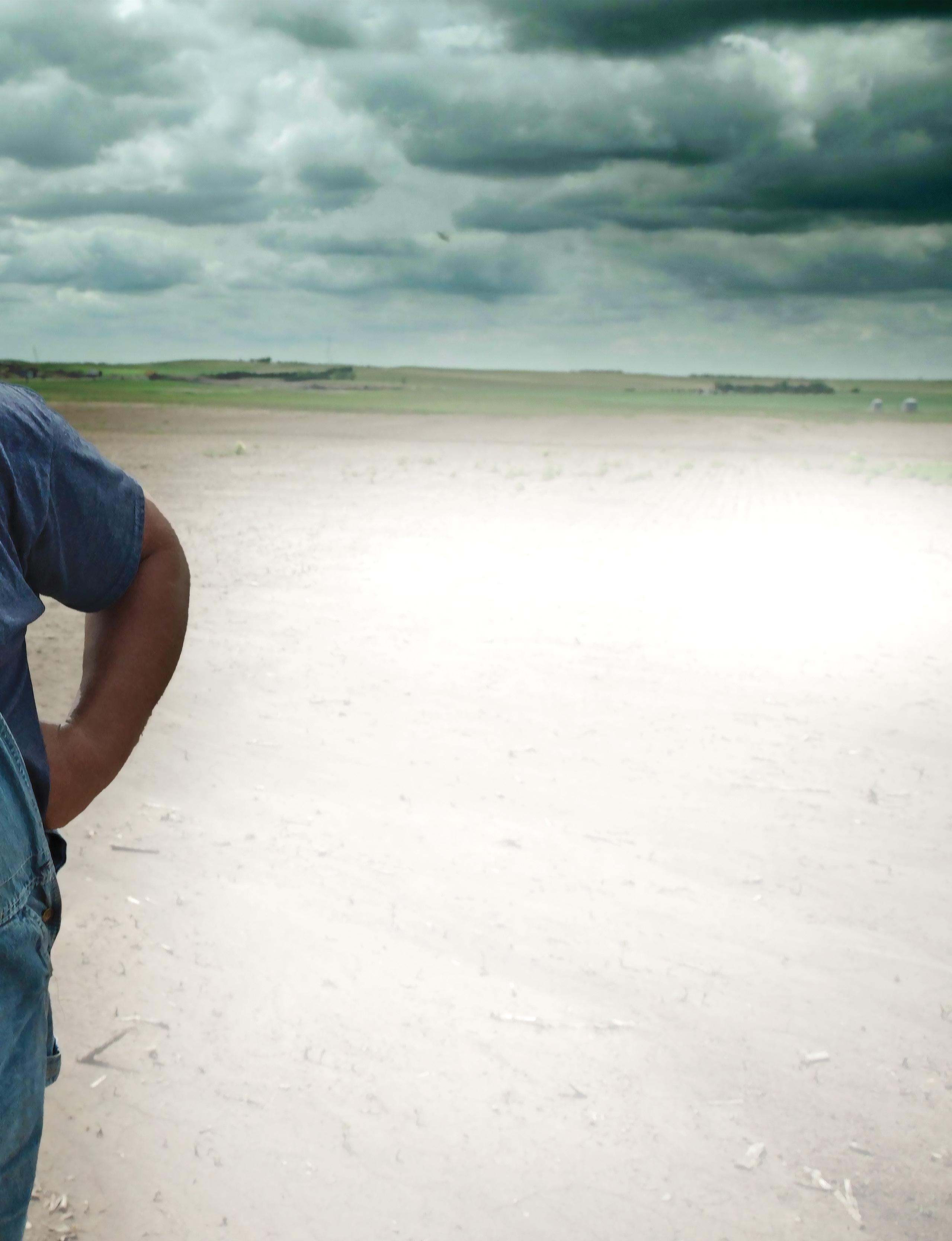
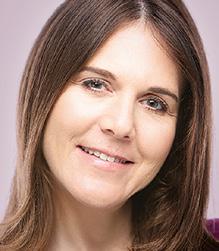 by KAREN LINDELL
by KAREN LINDELL
Ambassador FOR THE Common Ground GABE BROWN
Photos courtesy Big Picture Ranch
“My true passion is: How do we heal the land and heal people?”
– Gabe Brown
Gabe Brown’s film-premiere wardrobe never changes: bib overalls and a T-shirt. No red-carpet finery for this North Dakota farmer.
That includes the premiere of the documentary Common Ground, directed, written, and produced by Ojai’s Josh and Rebecca Tickell, at the Tribeca Film Festival in June 2023. Brown, who is featured prominently in the film, showed up alongside Jane Fonda (who donned a snazzy silk peach pantsuit) sporting his standard attire.
“Just me in my bibs, because that’s who I am,” Brown says. “I don’t put on appearances. I don’t own a suit. I don’t own a tie. I’m a simple rancher.”
True, but he’s a lot more complex than he lets on. And he’s arguably the “star”of Common Ground, which is saying a lot, because the film also features narration by Hollywood stars and activists Laura Dern, Rosario Dawson, Donald Glover, Woody Harrelson, Jason Momoa, and Ian Somerhalder. United States Senators Cory Booker of New Jersey and Mike Braun of Indiana are in the film as well, along with numerous farmers, ranchers, scientists, activists, and medical doctors who are experts on and equally passionate about the documentary’s subject: healthy soil and regenerative agriculture.
The “common ground” of the title is both Earth (the entire planet); and earth, the literal soil that is the source of life for the food we grow and eat, and that helps stabilize the climate.
“Common ground” is also a philosophical concept, calling us to support regenerative farmers like Brown, a pioneer in the regenerative movement, who employ agricultural practices that renew rather than raze our soil.
“This is a win for everybody,” Rebecca Tickell says. “It doesn’t matter what your politics are, where you’re from, what the color of your skin is. This is a universal coming together to shift the trajectory we’re on for future generations. That is our goal with Common Ground, as filmmakers, and as citizens of Ventura County.”
“We as a society need to find common ground for common good,” Brown says. “We all want clean air, clean water, and nutrient-dense food. Why don’t we stop fighting and focus on that?”
REGENERATION NATION
Brown and his wife, Shelly, own about 5,000 acres near Bismarck, North Dakota, focused on regenerative farming and ranching. That means they don’t use the tools of modern industrial agriculture such as synthetic fertilizers or pesticides. They plant cover crops (as part of their departure from “monocropping,” which refers to growing a single crop year after year on the same land), don’t till the soil, and raise animals out in the open rather than in factories. Once a “conventional” U.S. farmer, Brown now teaches and preaches to other farmers and ranchers, as well as politicians and business leaders, about regenerative methods.
35 OJAI MAGAZINE | SPRING ‘24

He’s thankful to the Tickells for giving him the opportunity to spread the word to the greater public, even though the last thing he wants is to be a screen star, especially after appearing in the couple’s first documentary on the same subject, Kiss the Ground, released in 2020.
“I specifically told them I do not want to be in this film,” Brown says. “This is much more important than Gabe Brown.”
But the Tickells, he says, have earned his trust, respect, and friendship. “I’ve had a lot of filmmakers from all over the world come to my ranch,” he says. “Most of them have preconceived notions and an agenda. I did not find that with Josh and Rebecca. The thing I like most about them is their open-mindedness. They are willing to listen to everything I have to say. I’ve been able to observe and watch them grow. And they’ve helped me grow and realize things, too.”
The Common Ground crew visited Brown’s farm several times, and he traveled to Ojai to discuss Common Ground with the Tickells and the film’s co-producer, Eric Dillon.
The celebrities who narrate the documentary frame their dialogue as “love letters” written to their children, promising to “fight like hell” to save their future. Brown doesn’t know much about the A-list stars, but does know they are fellow champions of regenerative agriculture, and appreciates the light they bring to the movement. “My true passion is: How do we heal the land and heal people?” he says. “Celebrities, with their Twitter and all those things I’m not on, reach a million or more people. Gabe Brown doesn’t have any of those. So if it brings a greater awareness to society and to consumers to change their buying habits, that’s a good thing, because that’ll drive change on the land.”
FUTURE FARMER
Brown grew up in Bismarck, where his main exposure to agriculture was through mowing suburban lawns.
That changed in ninth grade when he took a class in vocational agriculture and became “infatuated” with the subject, then joined Future Farmers of America.
“It was just the whole fact of working with life,” he says. “I enjoy all life, whether that be a plant, animal, or

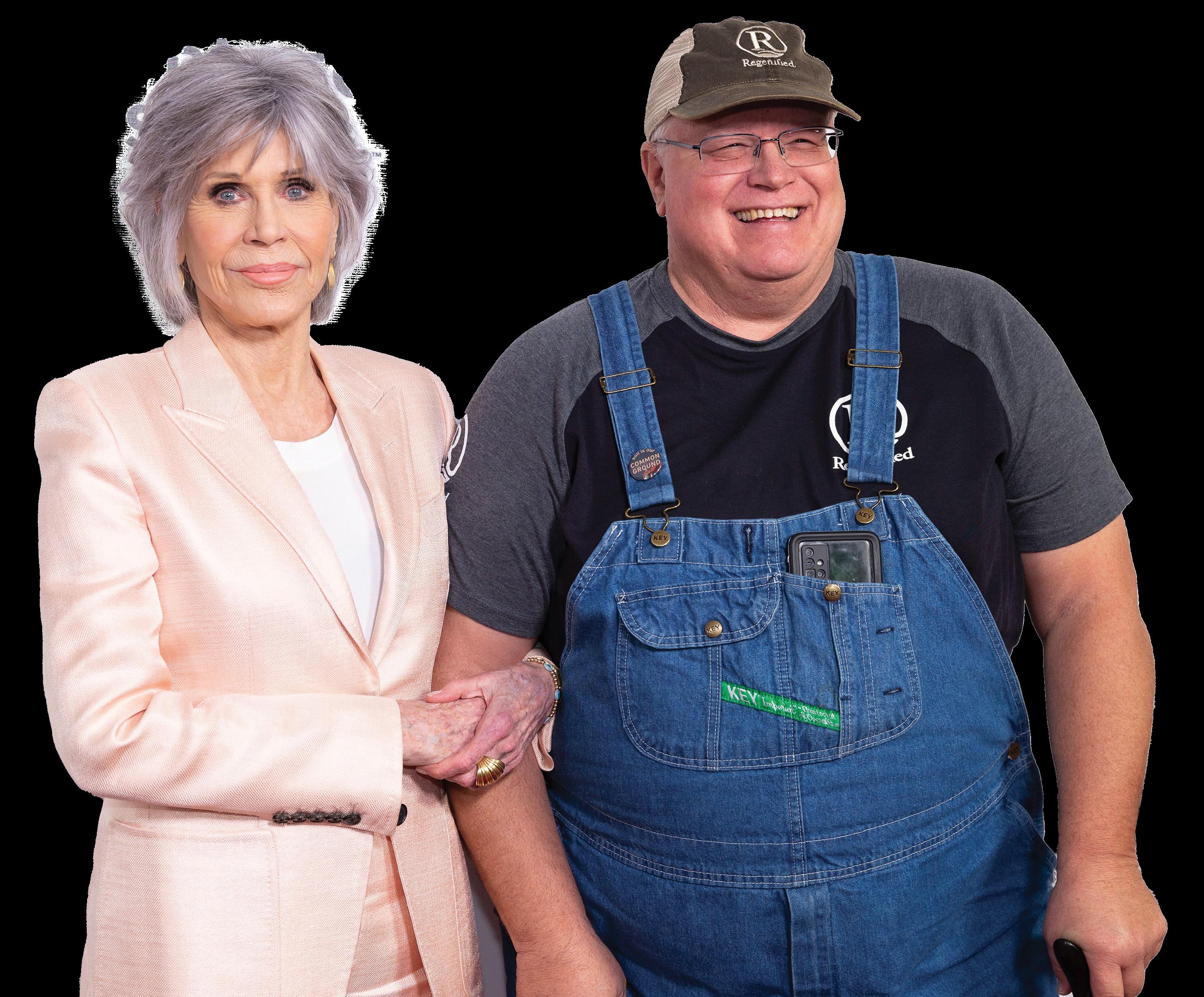
COMMON
Below: Common Ground theatrical film poster featuring regenerative farmer Gabe Brown
Bottom: Film supporter Jane Fonda and regenerative farmer Gabe Brown on the red carpet at the 2023 Tribeca Film Festival
36 OJAI MAGAZINE | SPRING ‘24
insect. So as my ag instructor was teaching us, I’m like, ‘Yeah, this is what I want to do.’” He began by picking rocks out of fields for local farmers, then ended up marrying the daughter of one of those farmers, and eventually they inherited farmland. Brown studied agricultural economics and animal science in college, and as a budding farmer incorporated conventional techniques, from using pesticides to driving diesel-fueled tractors.
In the 1990s, however, the Browns’ farm went through several years of hail, drought, and other natural calamities that destroyed the soil on their land. Seeking a way to replenish the soil, Brown read Thomas Jefferson’s journals to learn how
the former president grew food at his Virginia home, Monticello, without using chemicals. He discovered that Jefferson used cover crops like turnips and clover, and started experimenting himself using the same methods. He was surprised and delighted to learn that not only did his crops grow better, but the soil was healthier, and he actually made more money.
The film includes striking images of Brown’s cropland, a sea of green on one side, next to his neighbor’s, a soybean field turned to dust, on the other. Brown describes in the film how erosion from wind, water, and overtilling moved his neighbor’s powder-fine soil off the field — a scenario playing out around the world. We are headed, he says, to “Dust Bowl
version 2.0.”
SEQUEL TO KISS THE GROUND
The Tickells are determined to prevent that Dust Bowl from happening. Kiss the Ground, also produced by their Big Picture Ranch film studio, was a hit with viewers, seen by more than 1 billion worldwide, and three years later, has had “dramatic impacts,” Josh Tickell says. “It spurred the change from a handful of acres of regenerative agriculture in the U.S. to 30 million acres,” and the USDA has since “committed $20 billion to soil health and climate-smart agriculture.”
But the problem isn’t solved, he says. “The climate is still in free fall. We’re sicker as a nation.” Farmers who go into debt are dying by suicide. “Obviously, the issue wasn’t fixed, and a second film was needed.”

Josh and Rebecca, who live on a farm of their own in Ojai, say they have a moral imperative “as parents, as people who live in an agricultural community, as environmentalists, and as people who straddle the worlds of farming and Hollywood, to not let this issue go until it’s solidly in the mainstream conversation.”
Common Ground, which won the Human/ Nature Award at the Tribeca Film Festival, “really lays out a clear path for how we can do that,” Rebecca says.
The film takes on U.S. farming policy, politics and politicians, and agricultural companies and their lobbyists. Common Ground also points a finger at Beyond Meat and other meat “alternatives” that the film argues are better for the climate than a factory cow, but are still made from

GR OUND
COMMON
Above: Opening credits with Ojai locals on screen, Jedi Tickell and Gabriella Castro.
37 OJAI MAGAZINE | SPRING ‘24
Inset: Filmmakers Rebecca and Josh Tickell with regenerative farmer Gabe Brown and narrator/EP Laura Dern


plants like corn and soybeans that not only are monocrops, but also are treated with caustic chemicals, filtered, heated, and processed in a factory, leaving their nutritional value in question.
Common Ground also includes segments that describe how regenerative agriculture has been practiced for generations by Indigenous people; and highlights the contributions of Black people and communities to regenerative agriculture, from enslaved people, to Dr. George Washington Carver, to farmers and gardeners today.
Neither Brown nor the Tickells, nor any of the experts interviewed in the film, blame farmers for failing to implement what they do not know.
“No farmer or rancher wants to destroy the land or have a negative impact on the land,” Brown says. “But they’re not educated in any other way.” The film, for example, describes how universities that teach farmers are funded by large agri-businesses.
The Tickells have been invited to screen Common Ground at the White House in spring, and after the film finishes its theatrical run in the U.S. and Canada, it will air on streaming platforms.
HOW’S THE GROUND IN OJAI?
Rebecca says Ventura County and the Ojai Valley are “in the frontlines of everything we’re talking about in Common Ground. It’s
the epitome of some of the best agriculture we highlight, but also of practices that are creating desertification.” The Farm Bureau, she says, is o ering soil health classes to farmers, and the Tickells have partnered with a group of over 2,000 people in a group called Regenerate Ventura County to sign a petition requesting notification from local and state governments about events of planned pesticide spraying.
The Tickells hope the film’s influence will continue to spread far beyond California. Within three years of the release of Common Ground, Josh says, “we’re expecting to inspire 100 million acres of regenerative agriculture” (for more information on this initiative, visit 100MillionAcres.org). The demand for the film in theaters is more than Big Picture Ranch can supply. A form on the film’s website allows people to request a local screening. “It’s grown to 1,000 requests a week,” Josh says.
A SURPRISE DIAGNOSIS
Toward the end of Common Ground, viewers learn that Gabe Brown has been diagnosed with amyotrophic lateral sclerosis, or ALS, also known as Lou Gehrig’s disease. A progressive disease without a cure, ALS attacks nerve cells that control muscles. The causes aren’t clear, but exposure to pesticides has been linked to ALS.
Brown says he’s “feeling good,” even after a hip replacement. He’s planning to take time
to concentrate on his health, but slowing down for him means traveling around the country only 100 days a year instead of his usual 280-plus. He’ll also spend more hours talking to CEOs and politicians and less time mucking up his overalls on the ground. The poster for Common Ground is an image of Brown on his farm, wearing overalls, of course, but also a digitally added, billowing red cape that turns him into … a superhero? Brown says no one asked him about the red cape; (the Tickells confirmed it is “100% photoshopped.”)
“Anyone who knows me knows there’s no way I would agree to that,” Brown says. “I
 Josh and Rebecca Tickell with their creative team (producer Eric Dillon, writer Johnny O’Hara, production supervisor Jason Martinez) and documentary film subjects, regenerative farmers Gabe Brown and Ray Archuleta, having a pre-protection creative brainstorming meeting.
Josh, Rebecca, Athena and Jedi Tickell at Big Picture Ranch in Ojai.
Photo: Mariana Schulze
Josh and Rebecca Tickell with their creative team (producer Eric Dillon, writer Johnny O’Hara, production supervisor Jason Martinez) and documentary film subjects, regenerative farmers Gabe Brown and Ray Archuleta, having a pre-protection creative brainstorming meeting.
Josh, Rebecca, Athena and Jedi Tickell at Big Picture Ranch in Ojai.
Photo: Mariana Schulze
don’t look at myself as a superhero.” He found out from the Tickells that co-producer Dillon told them Brown agreed to the red-cape look. “So we all had a laugh about it,” Brown says.
Brown also wasn’t aware until he saw a preview version of the film that news of his ALS diagnosis had been included. “I waited six months to tell my own family, so very few people knew about it,” he says.
Brown eventually agreed to let the revelation stay, he says, because “if one person out there stops using chemicals because of seeing that in the film, it’s worth it. I in no way want people to feel sorry for me.” The film is dedicated to Brown.
“We couldn’t not include it as part of the story because he’s such a beloved person,” Rebecca says. “This man has changed countless lives. He’s certainly changed ours for the better.”
For more information about Common Ground, visit commongroundfilm.org



39 OJAI MAGAZINE | SPRING ‘24
Above: Rebecca and Josh Tickell reuniting with Woody Harrelson for his contribution in Common Ground. Below: Donald Glover filming on his on-camera narration for Common Ground at Big Picture Ranch in Ojai.
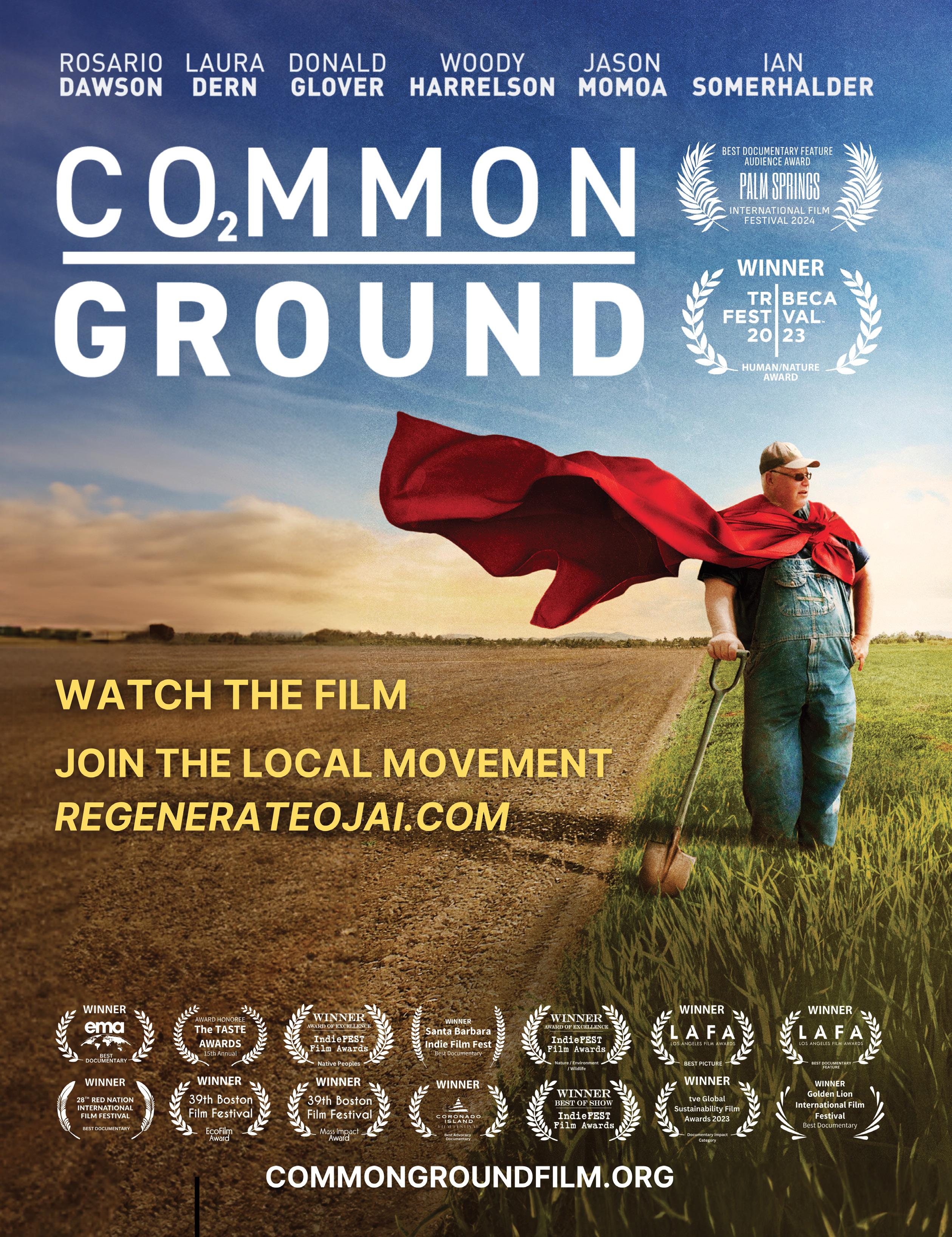
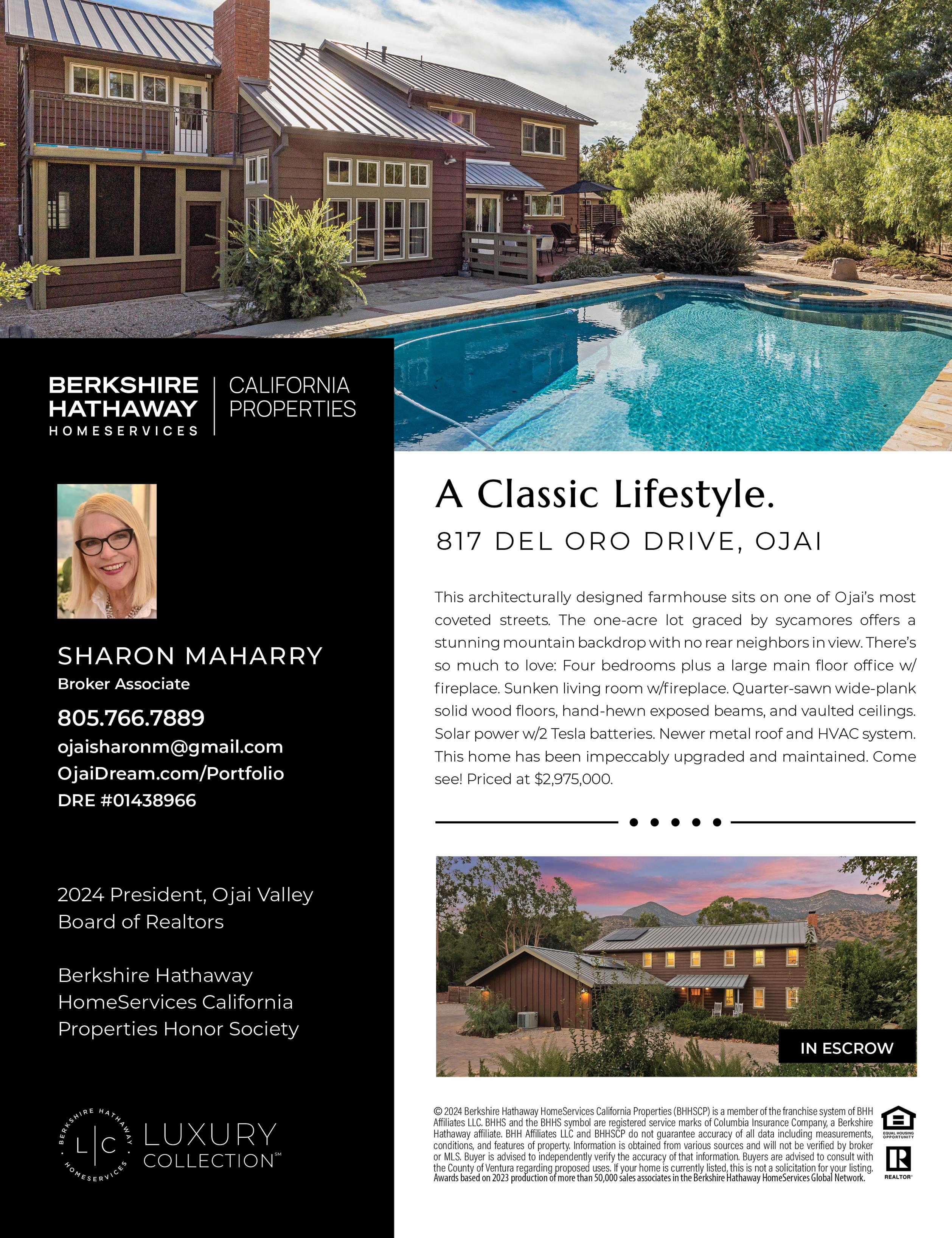
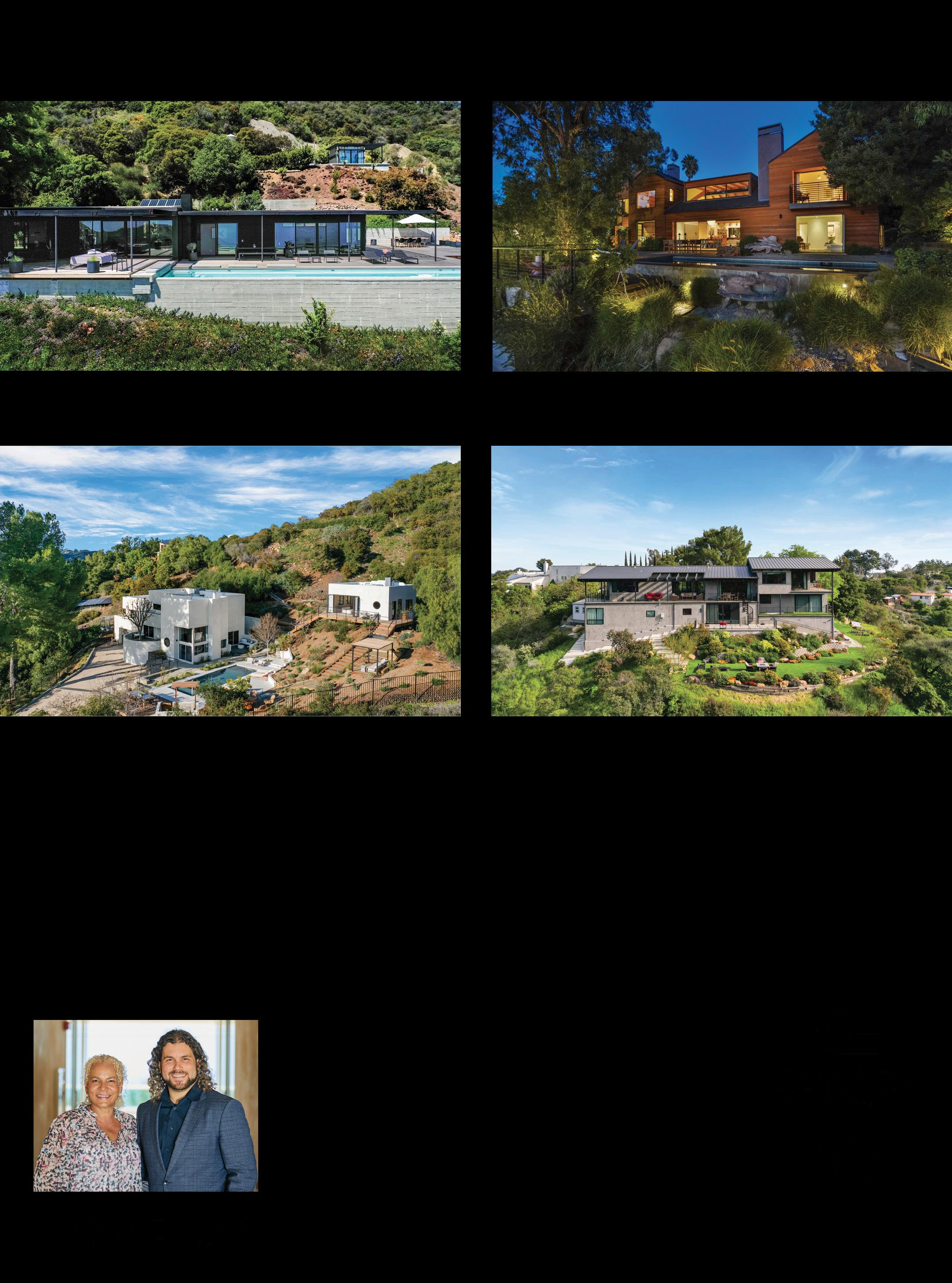
42 OJAI MAGAZINE | SPRING ‘24

Robert F. Kennedy Jr., an environmental lawyer running as an una liated independent candidate for president in the 2024 election, spoke last November as part of a campaignfundraising event at a private residence in Ojai.
One of the hosts, Ojai resident and local business owner Bill Moses, told us about what had motivated him to support the event: “I wanted to hear for myself, live and unedited, RFK Jr. speak. I wanted Ojai to get a deeper, personal view of a presidential candidate whether they supported them or not.”
Kennedy spoke outdoors under a coast oak tree at the Casa Barranca property. He touched on his polling numbers, the uncertain future of the next generation, housing, inflation, national and consumer debt, regulatory agency capture by corporations, the costs of war and pollution, health, and the environment. He discussed the upward shift of wealth, his legal achievements and personal philosophy of life.
He said: “When my uncle was president, the U.S. owned half the wealth in the world. We made everything and everybody wanted it. ...We were the richest nation in history. This is the first generation in history that is going to be worse o than their parents and they know it.”
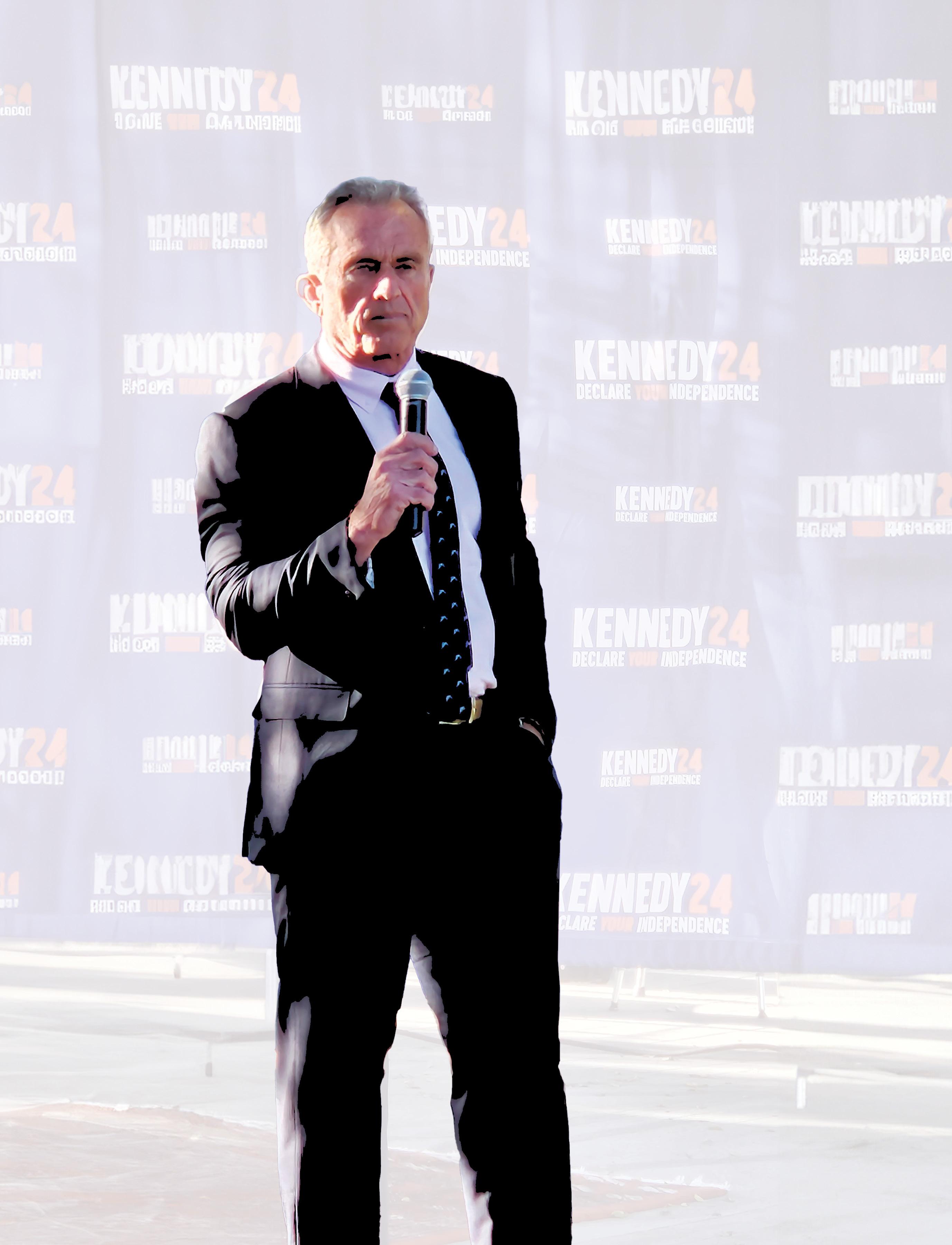
IN Ojai RFK JR.
LEGAL RECORD
“Regulatory agencies are the sock puppets for the industries they are supposed to regulate,” Kennedy said. He told the gathering of donors that he had sued the U.S. Department of Agriculture because it does the opposite of what it is supposed to do, which is “preserve farmers and the food supply.”
Longtime Ojai organic farmer Robert “BD” Dautch, who attended the event, said: “When RFK Jr. announced his intention to come to Ojai, I looked forward to hearing him address our community. I’ve always been appreciative of RFK Jr.’s work on the NRDC (National Resource Defense Council).
“I really started listening further as he exposed the influence of Big Pharma, the agricultural chemical giants, and the war machine on national and international affairs. His knowledge of the history of what led to the Ukraine war led me to believe if he had been president, it could have been avoided. My impression is that he is interested in becoming president for all the right reasons.”
HOMELESSNESS AND HOUSING
On the topic of homelessness, Kennedy shared what he believes are common misconceptions about the causes: “There are 550,000 homeless people in this country; half of them are in California.” He said that homelessness is almost solely an effect of housing prices.
44 OJAI MAGAZINE | SPRING ‘24 WINTER ‘23

stumps
 photos and story by
LAURA REARWIN WARD
photos and story by
LAURA REARWIN WARD
“It is possible to limit corporate in uence.”
“Why are home prices going up?” he asked. “Mainly because there are three giant companies — BlackRock, State Street and Vanguard. … Now they have decided to buy all the residential housing and all the farmland. We are going from a nation of owners to a nation of renters and that’s what our kids are going to grow up with.
That’s going from citizens to subjects.”
CREDIT CARD DEBT
“We hit a milestone a month ago — a trillion dollars in private credit card debt and increasing $100 million per year,” Kennedy said. “They are putting it on Wells Fargo, Chase, Bank of America, Citibank. Those companies are charging as high as 22% to 37% interest.
“If the mafia did that, it would be called loan-sharking and they’d go to prison, but it’s business as usual for those companies. Who do you think owns every one of those companies? BlackRock, State Street and Vanguard. BlackRock alone is three times larger than California and is the thirdlargest economy in the world.”
THE COVID SHUTDOWN AND AMAZON
“We shut down 3.3 million businesses in this country. … But Amazon was kept open. Using Amazon is seductive, but there is a cost to it. The cost is that that local retailer is now gone, the guy who gave our kids a summer job, or local Boy Scout troop, or paid for Little League uniforms and paid local taxes.” Kennedy said Amazon doesn’t pay local or federal taxes: “Last year — zero. So they’re doing it right in front of us. They are stripmining the wealth and the equity from the American middle class and they are dooming this generation of kids.”
PERSONAL PHILOSOPHY
Kennedy, whose father and uncle were murdered and whose second wife died from suicide, spoke of his battle with addiction 40 years ago and of his philosophy of life. He said, “I like to wear life like a loose coat,” and “learning to endure pain is a path to wisdom.” Of his campaign, he said, “My mission over the next 12 months of the campaign is to end the anger and the vitriol and lead everybody over the wall”.

45 OJAI MAGAZINE | SPRING ‘24
RFK Jr. speaks at an Ojai fundraiser, Nov. 19, 2023
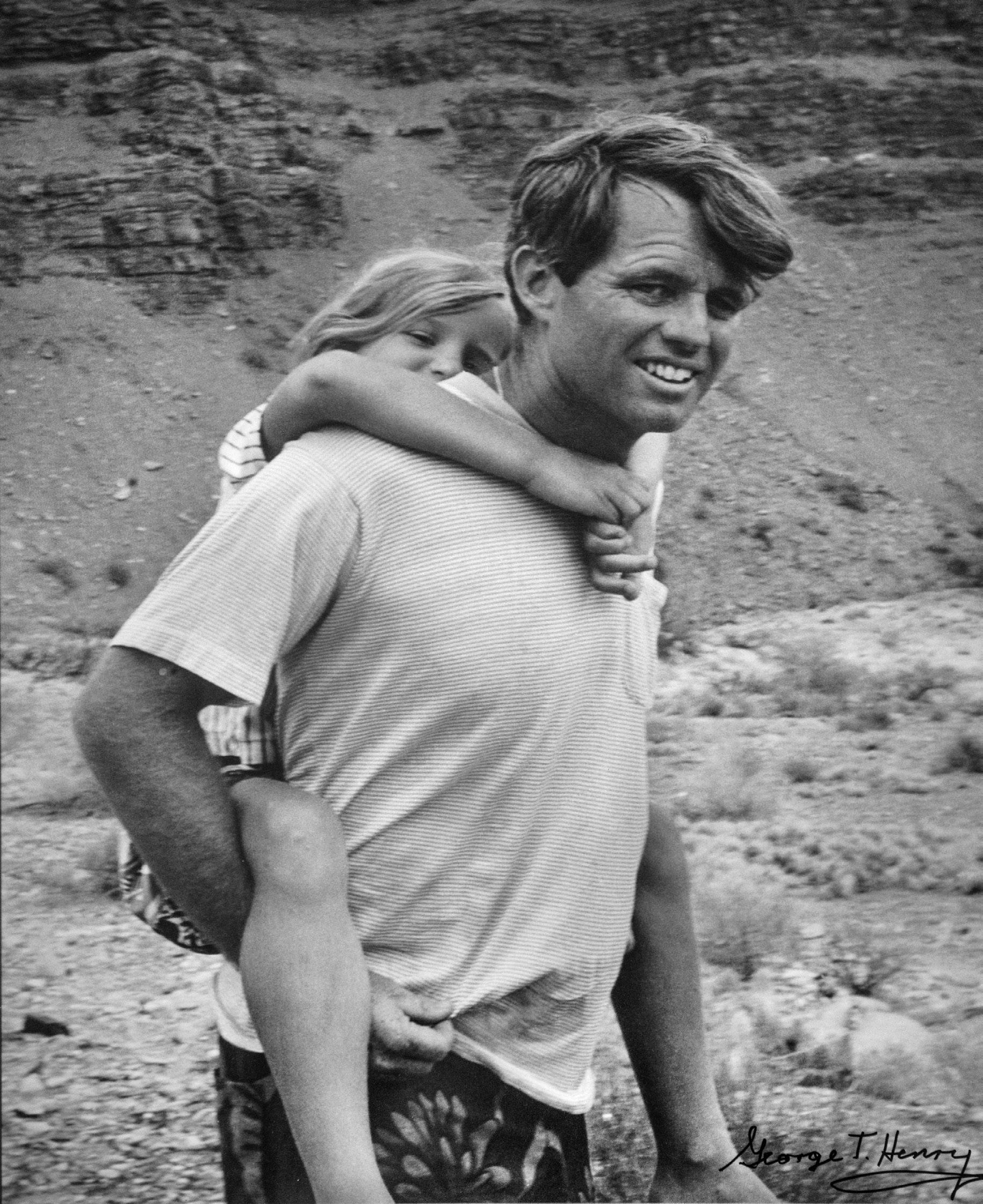
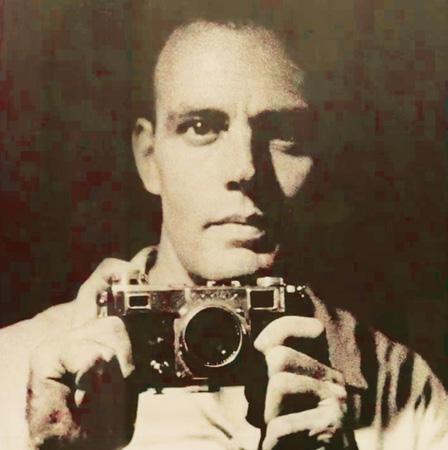
In January 2024, we caught up with RFK Jr. for a brief follow up. When asked about his connection to Ojai, Mr. Kennedy told Ojai Magazine that he had friends in Ojai and always loved coming to Ojai for organizational retreats, to visit the Turtle Conservancy and “taking his kids to lacrosse games.”
Ojai Magazine is a product of Ojai’s local independent community newspaper, Ojai Valley News; we asked RFK Jr: For 35 years presidents on both sides of the aisle have done damage to journalism and the First Amendment in the name of protection. Media consolidation and the rise of big tech has gutted local independent newspapers and resulted in huge losses in local reporting coverage for our communities. How do you see the relationship of the Fourth Estate in our democracy, and what might you do to restore sustainability and freedom of the press?
Mr. Kennedy’s response:
“My first day in o ce, I’m going to pardon Julian Assange and Edward Snowden for the sake of justice and as a civics lesson to our country. I’m also going to issue an executive order forbidding all U.S. government o cials from colluding with media and social media sites to censor political speech. I’m gonna go to work changing the RICO [ Racketeer Influenced and Corrupt Organizations] law to make censorship a predicate o ense. Free speech and a vibrant, independent and skeptical press are the foundation of American democracy.”
46 OJAI MAGAZINE | SPRING ‘24
Above: Robert Kennedy carries his 8 year-old daughter Mary Kerry Kennedy during a trip on the Colorado River in the Grand Canyon in 1967, about a year before he was assassinated in 1968. The photograph was taken by George T. Henry, a celebrated Iowa photographer who was also a white water river guide.
Read the original article published in the Ojai Valley News Nov. 22, 2023: https://bit.ly/3UEugmZ
Photo: George T. Henry


www.bartsbooksojai.com WINNERS 11 YEARS IN A ROW! An Ojai tradition for over 50 years 302 W. Matilija Street (805)646-3755 10am-6pm daily 2023

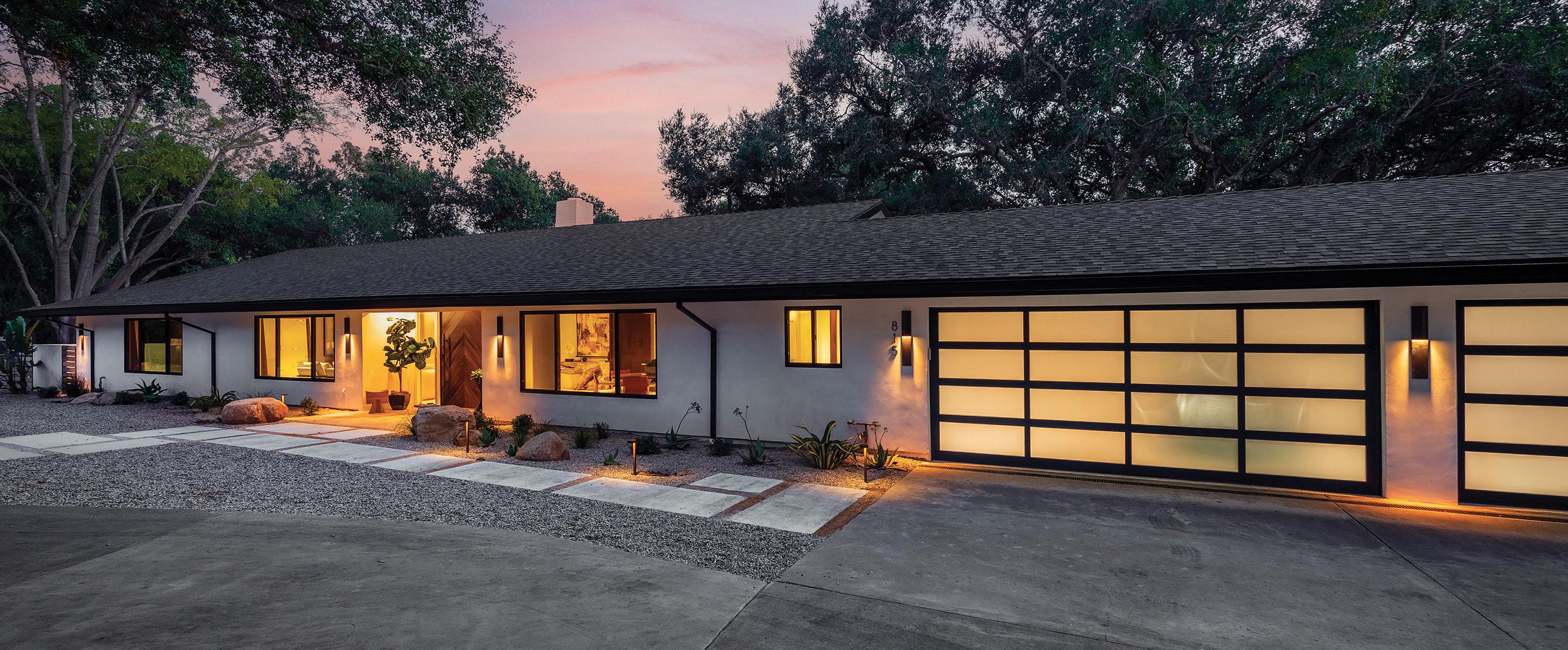
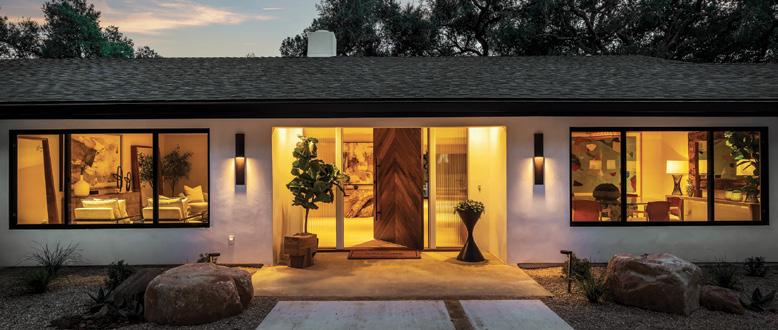



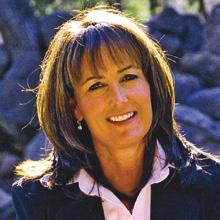
Cathy Titus DRE 01173283 805.798.0960 ctitus@livsothebysrealty.com © 2024 LIV Sotheby’s International Realty. All rights reserved. All data, including all measurements and calculations are obtained from various sources and has not and will not be veri ed by Broker. All information shall be independently reviewed and veri ed for accuracy. LIV Sotheby’s International Realty is independently owned and operated and supports the principles of the Fair Housing Act. 48 OJAI MAGAZINE | SPRING ‘24
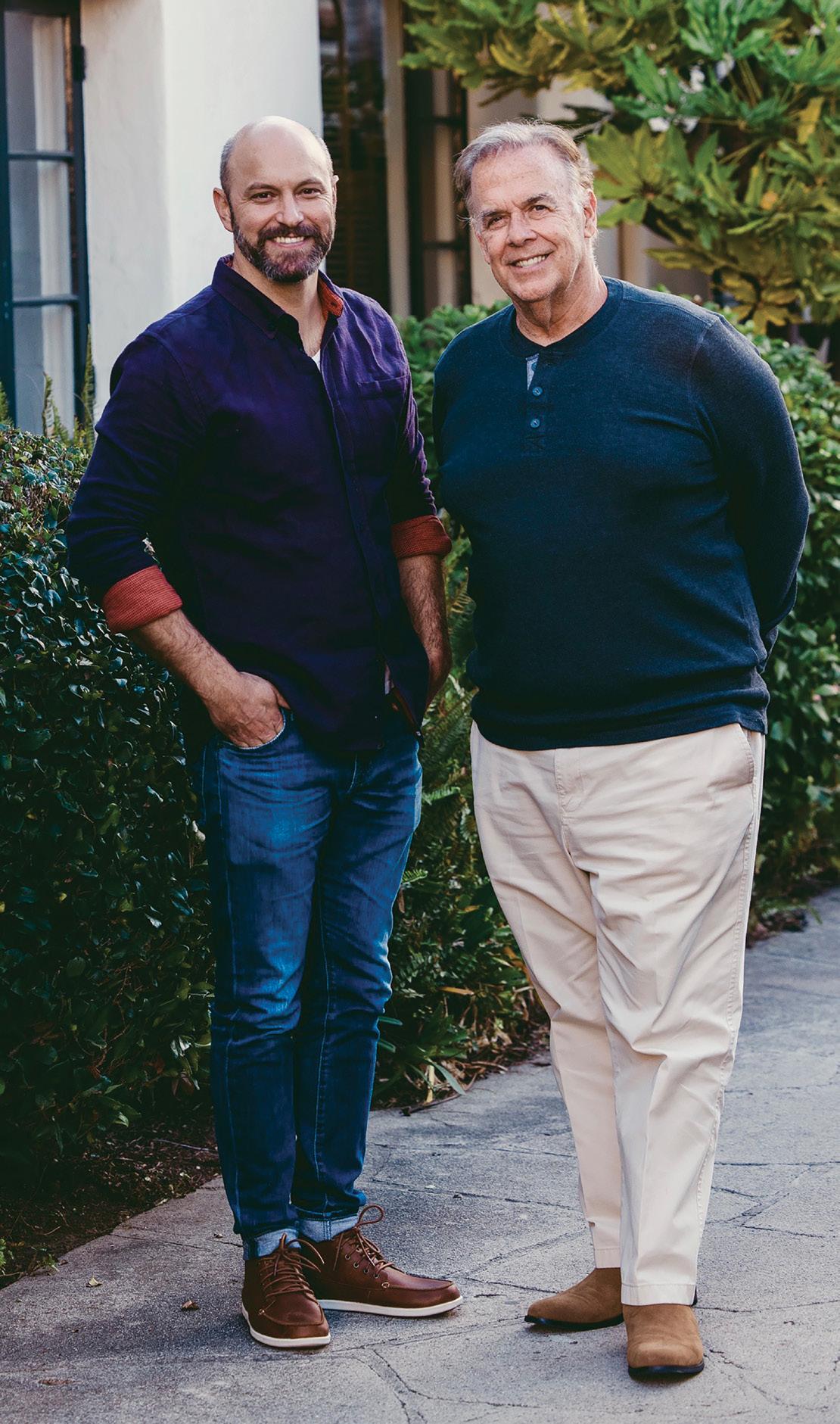

49 Beautiful Smiles, Naturally. Cosmetic and Biological Dentists 1511 State Street, Santa Barbara CA 93101 805-899-3600 | santabarbaradds.com Lance Grant, DMD | Mark Weiser, DDS

50 OJAI MAGAZINE | SPRING ‘24
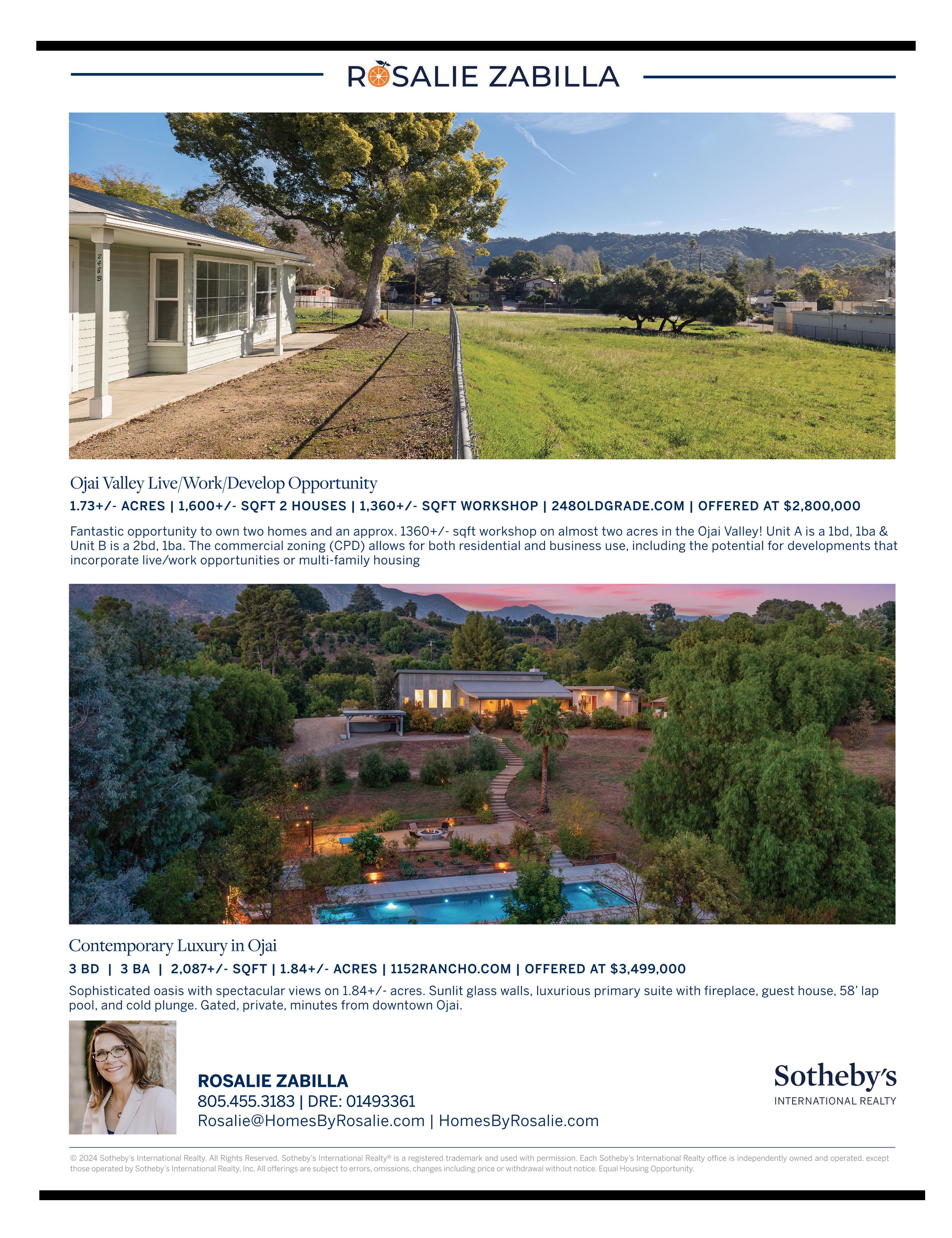
51 OJAI MAGAZINE | SPRING ‘24
Scenes from a simpler time
 story and photos by DAVID LABELLE
story and photos by DAVID LABELLE
I had already worked for several California newspapers by 1975 when I decided to spend most of the year back home in the Ojai Valley. Ojai Valley News editor and publisher Fred Volz, as he often did when I was between newspapers, offered me a job as photographer, which I accepted before moving to Anchorage, Alaska, in 1976.
It wasn’t uncommon in 1975 to see celebrities walking the streets of Ojai, but an unusual buzz surrounded the filming of an episode of The Six Million Dollar Man, starring the handsome and popular Lee Majors and his television fiancée, Lindsay Wagner, The Bionic Woman.
e Six Million Dollar Man and e Bionic Woman


52 OJAI MAGAZINE | SPRING ‘24
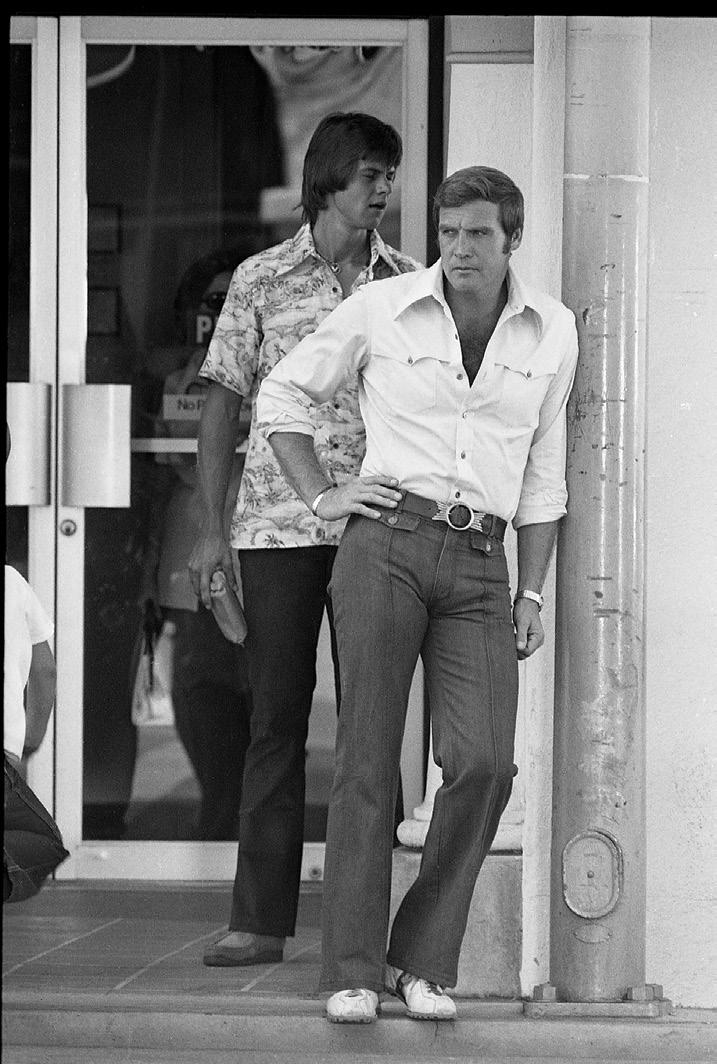

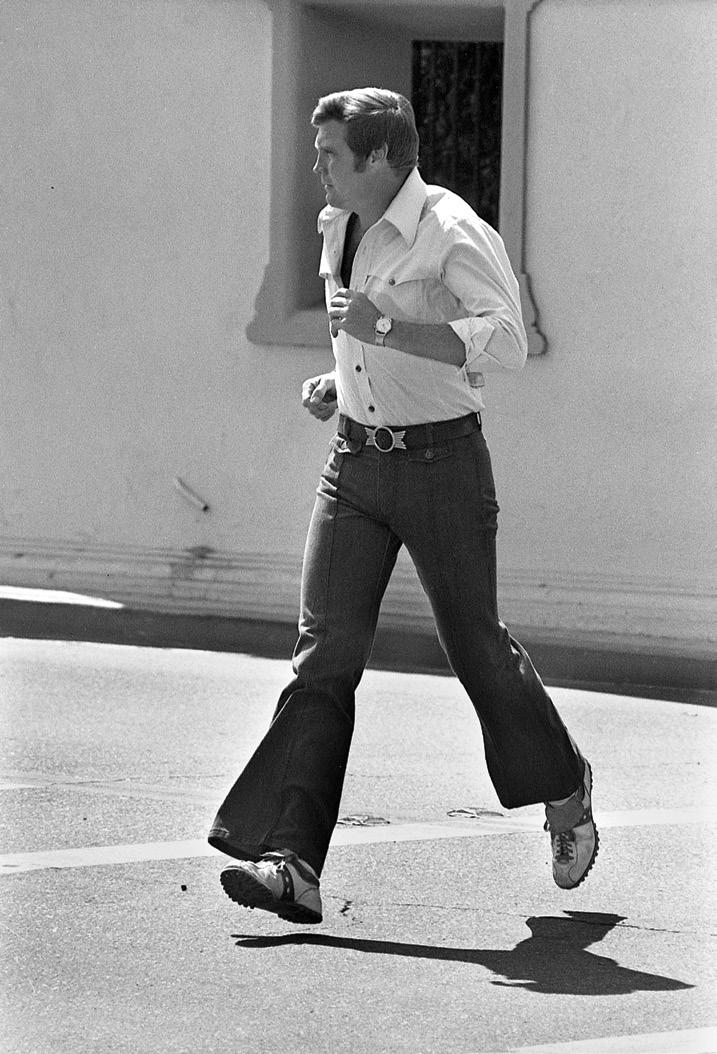
After all, Ojai was Steve Austin’s and Jaime Sommers’ hometown. A marker was even made for the show that read: “Welcome to Ojai, Home of American Astronaut Steven Austin.”
Though the storyline
found Austin rekindling an old flame with now tennis star Summers, in real life Majors was married to Farrah Fawcett, an American heartthrob and one of the stars of the television series Charlie’s Angels. (I think every male from 15 to 50 had
the iconic swimsuit poster of Fawcett.)
That Fawcett showed up in town during the filming was no small delight to fans and brought her own herd of onlookers hoping to get a look at the blond beauty.

53 OJAI MAGAZINE | SPRING ‘24

I photographed Wagner and Majors several times, mostly during filming in and near Libbey Park. I believe these images are from The Six Million Dollar Man episode “The Return of the Bionic Woman: Part 2.”
Looking back 49 years, I think it was a simpler time, when my world was mostly in black and white.

54 OJAI MAGAZINE | SPRING ‘24



55 OJAI MAGAZINE | SPRING ‘24

56 OJAI MAGAZINE | SPRING ‘24




Beatrice Wood Center For the Arts Topa Mountain Winery The Ojai Playhouse VENTURA ROOFING COMPANY INC. 805-646-ROOF | www.venturaroofingco.com Voted Ojai’s Best Roofer 13 years in a row! Request a bid at venturarfg@gmail.com 2023 License#440157 | Serving Ventura County for over 40 years

58 OJAI MAGAZINE | SPRING ‘24

59 OJAI MAGAZINE | SPRING ‘24


60 OJAI MAGAZINE | SPRING ‘24
Radioactive
‘Woody Guthrie used to say that some men will rob you with a six-gun, and some with a fountain pen. The killing today at SSFL is done by burying contaminant numbers in a table that you need a magnifying glass to read. And then lying about it.’
— Dan Hirsch
Imagine a vast but unseen menace, an invisible rain of infinitesimal particles — as likely to cause cancer in people as any substance — falling on a mountain ridge in northeast Ventura County, then moving over Simi Valley, Canoga Park, the San Fernando Valley and into Los Angeles.
Imagine companies with government contracts responsible for this rain of ghostly mutagens working with government o cials to keep this mortal threat a secret from the public.
Imagine the executives responsible for the unseen downpour not only refusing to reveal it, but when confronted with indisputable films and records of its occurrence, flatly denying it.
This was an era — the 1950s and ’60s — before environmental review. Almost the only notice taken in the newspapers of a massive nuclear and rocketry facility in the mountains over Simi Valley called the Santa Susana Field Lab were the want ads that attracted thousands of workers. Mostly those hired were blue-collar workers paid well to work in aerospace.
But tens of thousands of rocket tests, and decades of nuclear waste in Ventura and Los Angeles counties, left behind radioactive particles, toxic chemicals, and radioactive metal in industrial recycling centers in Ventura, and as well in the waters o Santa Cruz Island.
Rain
 by KIT STOLZ
by KIT STOLZ
e partial nuclear meltdown that still haunts Ventura County

 A young John Pace sitting at the reactor console before the accident.
Photo: John Pace
A young John Pace sitting at the reactor console before the accident.
Photo: John Pace
61 OJAI MAGAZINE | SPRING ‘24

In all these places remain some of the most toxic substances known to humankind, and in some cases, in massive quantities deposited there with little or no public notice or remediation.
Now imagine one University of California nuclear expert, volunteering for years of organizing and investigation, uninterested in personal fame, relying on a tiny circle of fellow activists and the support they inspire from student researchers, stepping forward and breaking that story’s tomb-like silence.
To this day, Dan Hirsch, even in retirement, while living near UC Santa Cruz, remains at the heart of the long battle between the owners of the facility — which permanently closed in 2006 — and the activists demanding a complete cleanup of its toxicity, both radiological and chemical.
This is the story of the Santa Susana Field Lab. It has been a source of fierce contention and countless lawsuits and scientific studies for decades, but might never have come to light if UCLA nuclear policy lecturer Hirsch, working with fellow anti-nuclear activists,
student investigators and the press, had not revealed the truth of the partial nuclear meltdown in 1979.
THE MELTDOWN
“This is my first opportunity to tell what happened in 35 years,” said John Pace, who was 20 when he started working as a reactor operator trainee at the console of the Sodium Reactor Experiment (SRE) at the SSFL. “I was not supposed to say a word.”
Pace returned to Southern California from retirement in Idaho in 2014 to speak at an event hosted by Hirsch’s community SSFL Work Group in Simi Valley. After holding a decades-long silence about the accident, as ordered in 1959, Pace was overcome with emotion and apologized to the crowd while telling his story. The crowd included other former SSFL workers, some of whom — like Pace — had had health problems since their work tenure.
Pace told reporters he was sterile for seven years after a few years of work at the SSFL, and later developed lung problems and skin

cancer, which he attributed to his time working in the reactor building.
The reactor at which Pace worked in his youth — the SRE — was the largest in Southern California at the time. But at 20,200 kilowatts, it was small by modern standards and primitive in design. The SRE lacked any sort of concrete containment dome, which now is a design standard in reactors, to prevent any release of radioactivity from inside the structure to the atmosphere.
Pace was a trainee reactor operator, but had been on the job only a few months. He admitted to being intimidated by older, more experienced o cials at the plant. When he arrived for his shift on July 12, 1959, he was shocked to hear what the reactor o cials said.
“There were men all lined up around the console, and they started discussing what happened with the accident,” he said. “As
The Sodium Reactor Experiment building
Photo: John Pace
Broken fuel rods inside the reactor
Photo: John Pace

I stood there and listened, they scared me to death with what they were talking about, because a ‘power excursion’ is the worst thing that can happen in a reactor.”
For reasons the operators didn’t understand at the time, the nuclear reaction — and internal temperatures — in the uranium core escalated uncontrollably in a fraction of a second. During this “power excursion” and over the following 13 days, nearly one-third of the radioactive fuel rods melted, and dozens of fuel rods broke inside the reactor chamber.
“I heard about how they had barely shut the reactor down after it had run away on them,” Pace said. “The reactor had an automatic shutdown, but that didn’t work and then they finally did it mechanically, powering the control rods down. All this went on for quite a while, and the storage tanks filled with radiation, and they realized they couldn’t do anything about it. I was there to listen as they said that if we don’t shut this down, it’s going to blow up. And so they had to release the radiation straight out of the reactor into the atmosphere. This has not been talked about, but the winds were blowing in the direction of the San Fernando Valley.”
The reactor o cials, puzzled by what went wrong, restarted the reactor two hours later. Some radiation monitors went “o scale,” according to Atomic Energy Commission records, and an on-site health-monitoring
official later reported that radiation inside the reactor building had reached 300 times safe levels.
Pace said a fellow employee asked the company’s top executive, Marvin J. Fox, if they could tell their wives about the radiation then “over their heads” in nearby towns such as Chatsworth, Canoga Park and Simi Valley. After a moment’s consultation with aides, Fox came back with a stern warning.
“They said no, you cannot — we don’t want anybody saying a word about it,” the director said. “We’ll report what happened to the public in our own due time.”
The reactor workers were subsequently sworn to silence. Other SSFL workers spoke of being threatened with legal action, and of having dosimeter badges (which measure employees’ work exposure to radiation) confiscated. Because of the threats, which Pace said had a military tone, for decades SSFL workers loyally stayed silent, even at the risk to their own health and their families.
Two hours after the partial nuclear meltdown, officials restarted the badly malfunctioning reactor.

“It was a very foolish thing,” Pace said. “It scared us to death, but for two weeks, every 24 hours,

they would shut down the reactor and then restart it until they figured out for sure that the sodium pump was the cause. Every time they shut down the reactor, more radiation was released out into the atmosphere. It could have been toward Simi Valley, or Topanga Canyon. I can’t tell you which way it went.”
For Hirsch, it’s no mystery why the reactor operators ignored safety precautions.
“Is it really hard to understand?” he asked. “No, not at all. They were up on a hill. No one could see them. It was before the days of any regulation. The EPA didn’t exist. And they were nuclear cowboys.”
Weeks after the partial meltdown, Atomics International — on the letterhead of the Atomic Energy Commission in Washington, D.C. — released on a Saturday morning in Canoga Park a brief statement saying that a single “parted fuel element” had been observed at the reactor.
“The fuel element damage is not an indication of unsafe reactor conditions,” according to the statement. “No release of radioactive materials to the plant or its environs occurred and operating personnel were not exposed to harmful conditions.”
No reporter followed up on the press release. Although the Santa Susana Field Lab (and supporting facilities in the San Fernando Valley) employed thousands of workers for decades in dangerous conditions, with injuries and a few deadly accidents, still nothing of the meltdown was reported for 20 years until Hirsch — working with UCLA students in the 1970s — began requesting documents from the Atomic Energy Commission under the Freedom of Information Act (FOIA).
OPPOSING VOICES
Today, Hirsch and his many allies in Ventura County and around the state, most prominently Melissa Bumstead and Jeni Knack, co-founders of the Parents Against SSFL activist group in Simi Valley, believe that unless legal action is soon taken against the powers that be at the site — Boeing and the state Department of Toxic Substances Control — the alleged collusion will succeed, allowing Boeing to avoid the costs of a fullscale cleanup, expected to cost hundreds of millions of dollars, leaving residents below the site in Simi Valley and West Hills at risk.
63 OJAI MAGAZINE SPRING ‘24
John Pace working on the broken sodium pump.
Photo: John Pace
John working atop the reactor.
Photo: John Pace
Without Hirsch’s leadership — detractors and supporters such as Bumstead agree — the fate of the Santa Susana Field Lab over the last 60 years would have played out very differently.
Phil Rutherford, a Boeing consultant and nuclear expert who worked at the SSFL as senior manager of Radiation Safety for 25 years, overseeing 10 employees, argues*1 that no contamination has been found beyond the boundaries of the 2,850-acre site. He said that any cancer among residents in Simi Valley was not caused by the SSFL, and has questioned the need for a “cleanup to background.” Although he makes clear he does not speak now for Boeing — which limits its engagement with the press to corporate statements — in his detailed analysis, he blames Hirsch for prolonging the struggle over the cleanup.
Rutherford commented*2 last year: “With the exception of Boeing’s successful SB 990 lawsuit against the state, all lawsuits have been initiated by Dan Hirsch and other activist organizations against the California Department of Public Health, DTSC itself, the Department of Energy, and Boeing. Since Dan Hirsch was not a party in the mediation and not a signatory to the [2022] Settlement Agreement, there is no guarantee that future lawsuits will not occur if things do not go as he wants.”
This stance ignores the substantial evidence of elevated rates of cancer found among the people of Simi Valley, among other towns near the SSFL. In 2007, a federally funded study*3 by a University of Michigan epidemiologist found that specific cancer incidence rates were 60% higher for residents living within two miles of the site, compared to five miles away.
Bumstead of Parents Against SSFL said that the state agency refuses to take these numbers into account.
“The DTSC won’t recognize outside reports, even when they’re federally funded, like the 60% higher incidence rate,” Bumstead said. She speaks with a weary familiarity of cancer. Her daughter Grace’s cancer was diagnosed when Grace was 4 years old. The second diagnosis — well after her daughter’s first recovery — came when Bumstead and her husband had for a time hoped to move the family away, out of state, away from the SSFL, only to realize they could not support
their sick child without their local families’ help.
In the course of her family’s long trial by sickness, Bumstead said she has met in oncologists’ offices dozens of other local families with kids with cancer. In meetings and demonstrations, she displays a bulletin board with pictures of local children in cancer treatment. It’s one reason she speaks harshly of the DTSC and Boeing and what she calls their attempt “to kick the can down the road for a thousand years.”
In an attempt to resolve the controversy, Gov. Gavin Newsom, Jared Blumenfeld, secretary of the California Environmental Protection Agency, and Meredith Williams, director of the DTSC, announced a new plan, based on a legal settlement reached behind closed doors between Boeing and the DTSC in May 2022, that they say will at last decontaminate the SSFL.
“Santa Susana Field Lab is one of our nation’s most high-profile and contentious toxic cleanup sites,” said Newsom in a press statement. “For decades there have been too many disputes and not enough cleanup. Today’s settlement prioritizes human health and the environment and holds Boeing to account for its cleanup.”
But Hirsch and his long-term allies, including Parents Against SSFL, Physicians for Social Responsibility, and the Natural Resources Defense Council, believe the settlement gives Boeing license to avoid the vast majority of the cleanup — up to 94%. Although the clock is running, the advocates — possibly with the county of Ventura and other local governments — want to sue.
On Jan. 12 of this year, the Ventura County Board of Supervisors announced a “tolling agreement” between Boeing, DTSC, and nearby local governments — the cities of Los Angeles and Simi Valley, as well as Los Angeles and Ventura counties.
The agreement removed the need for the local governments — or other entities — to file suit by Jan. 15, 2024, against Boeing and the DTSC, under the California Environmental Quality Act.
The concern is that the agreement could narrow lawsuits over the cleanup to individual “Cleanup Plans” for smaller portions of the site, 10% or less, which advocates say will greatly limit the extent of
the cleanup to measures limited numerically in the Settlement Agreement of 2022.
“Woody Guthrie used to say that some men will rob you with a six-gun, and some with a fountain pen,” Hirsch said. “The killing today at SSFL is done by burying contaminant numbers in a table that you need a magnifying glass to read. And then lying about it.”
Hirsch is a singular figure — a hardworking and largely unpaid Gandhi-inspired idealist. As an undergrad at Harvard in 1970, Hirsch helped lead protests against the Nixon administration’s assault on Cambodia, ultimately closing the campus to allow students to go home to organize against the war. Hirsch returned to his hometown of Los Angeles in 1972 and — after finding work as a lecturer at UCLA in nonviolence and energy policy — launched a campus Committee to Bridge the Gap (CBG) to peacefully end the war in Vietnam.
After the war ended in 1975, Hirsch, with CBG, turned his focus to nuclear weapons and policy, discovering, to his shock, at the UCLA campus near his office a working nuclear reactor emitting radioactive gasses. This stunner motivated students on campus to volunteer to join CBG’s investigatory work. Besides the reactor on campus, they soon found records of an unlicensed and unmarked nuclear-waste dump on the grounds of the nearby Veterans Administration.
These nuclear discoveries made headlines, and the CBG was ultimately able to challenge the relicensing of the campus reactor and win its removal. At his modest log cabin home in the redwood forest not far from UC Santa Cruz, where he led a nuclear policy center for decades after his time at UCLA, Hirsch keeps a part of the reactor console given to him as a sort of prize in the end by UCLA officials. It is kept in one of several storage sheds full of decades of files.
BREAKING THE SECRET MELTDOWN STORY
In 1979, just two weeks after a partial meltdown of the Unit 2 reactor at Three Mile Island caused a near panic in Pennsylvania, and about a month after the unwittingly well-timed release of the nuclear-reactor disaster film The China Syndrome, Warren Olney on his popular nightly NBC Channel 4 newscast shocked
64 OJAI MAGAZINE | SPRING ‘24
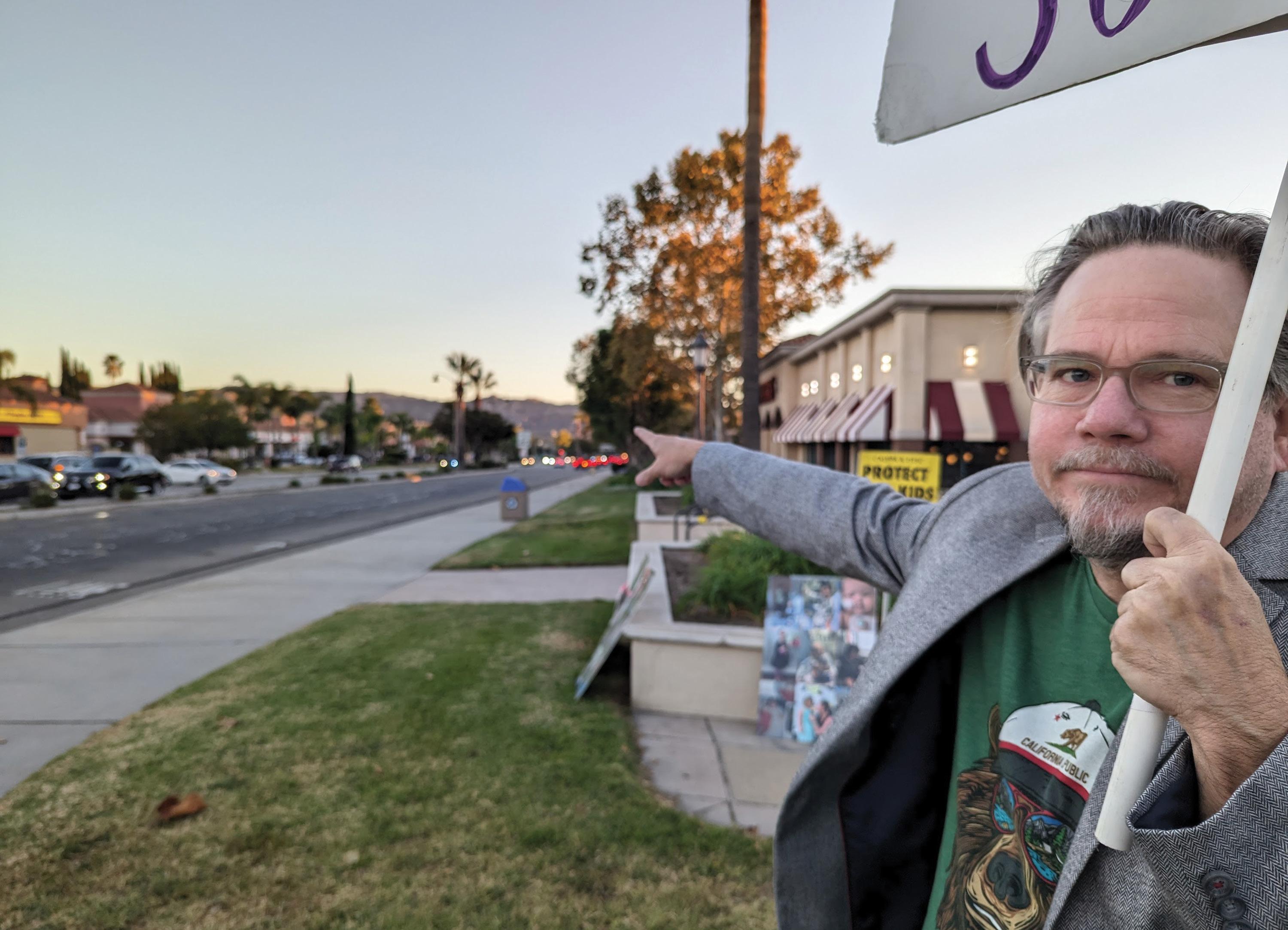
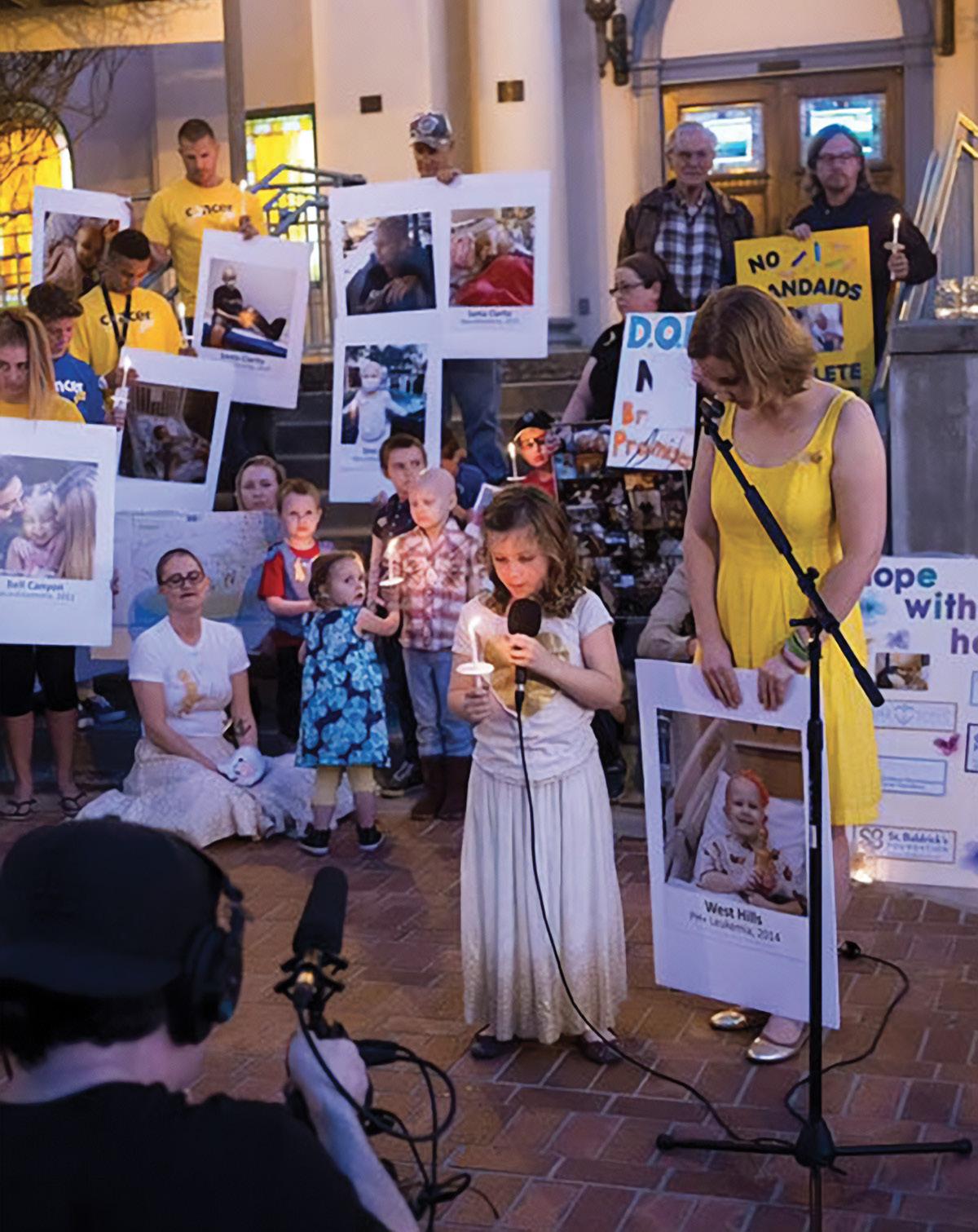
Los Angeles with news of a partial nuclearreactor meltdown above Simi Valley in 1959.
“In 1979, when we discovered the partial meltdown, I brought the story to Warren and he did a five-part series during ‘sweeps week’ for the ratings,” Hirsch said. “They took out a half-page ad in the LA Times and really promoted the series.”
This brief summation dramatically understates the investigatory work that Hirsch and a mentee, Michael Rose, did in the AEC archives at UCLA, and with FOIA requests to pry documents, images, and
even films loose from the nuclear repository in Oak Ridge, Tennessee.
“I think he deserves a lot of credit, and he has been willing to take the heat for it,” Olney said in an interview in the fall. “It’s remarkable. The video images showing the fuel rods broken inside the reactor were just incredible. He always gives credit to a student documentarian he worked with, Michael Rose, for the images, but they were a gold mine. He and his team got these videos from the NRC (Nuclear Regulatory Commission). I’m sure you can never get anything like that anymore.”
Olney adds that despite abundant evidence of a catastrophic meltdown at the SRE — including the fact that it took millions of dollars, the design of a new system of cameras and grappling tools to work inside the reactor chamber, and 14 months of unprecedented work to remove the broken core and repair the malfunctioning cooling system — Atomics International executives said nothing much had gone wrong.
“It did not appear to be a hazard to the public or to our employees, and in retrospect it wasn’t a hazard to the public or our employees, and we put that plant back online,” said Atomics International Assistant General Manager Wayne Myers to Olney in the NBC series.
That statement was as false and misleading as the original press release. This past fall, a nationally recognized expert in nuclear reactors, Arnie Gundersen, who has conducted radiological studies at the SSFL, said that the partial nuclear-reactor meltdown released many more radioactive particles than the much-better-known partial meltdown at a reactor on Three Mile Island in 1979.
“I would say the release [of radioactivity] from Santa Susana was definitely the worst meltdown up until Three Mile Island,” Gundersen said. “And there were actually more radioactive particles, such as cesium and strontium, that got out of Santa Susana than got out of Three Mile Island. Three Mile
William Bowling, at a Simi Valley intersection, points to the Ridgetop SSFL site.
Photo: Kit Stolz
Melissa Bumstead sitting with her daughter, Grace, with Jeni Knack, co-founder with Bumstead of Parents Against SSFL, at a demonstration in Simi Valley last November.
Photo by Parents Against SSFL
Island released a lot of noble gasses, such as xenon and krypton, at much higher rates, but the stuff that’s on the ground at Santa Susana, even now, is much worse than the stuff on the ground in and around Three Mile Island.”
For his part — when not organizing around Diablo Canyon and other nuclear facilities in California — Hirsch has devoted 45 years of his life to cleaning up Santa Susana. It’s one of few places in the world to have suffered fallout from a partial nuclearreactor meltdown, he points out, and it’s also a site where tens of thousands of rocket tests were performed from the 1950s to the 1980s, resulting in the dumping of hundreds of thousands of gallons of carcinogens onto the ridgetop site, including hydrazine, perchlorate, and trichlorethylene.
“On the last day [of the NBC series], Warren got a call from a woman in Newbury Park, who was the mother of a child with childhood leukemia,” Hirsch said. “She said she had found eight other families in the neighborhood with kids with cancer. She asked Warren for help, and he said, ‘I’m a reporter — call Hirsch.’ So she called me to ask for help. And I promised to help her. I never thought it would take so long.”
DID THE STATE MISLEAD VENTURA COUNTY ADVOCATES AND OFFICIALS?
Hirsch and many of his longtime allies believe they have been misled and — in Hirsch’s case — personally betrayed by California officials, including former Cal EPA Secretary Jared Blumenfeld. He’s angry about it.
“We were played,” Hirsch said bitterly.
For decades Hirsch and allies have pushed for a “cleanup to background,” which means removing the radionuclides from the site, removing soil in massive volumes
if necessary, and it means removing “Contaminants of Concern” from aquifers and keeping them out of stormwater.
For Hirsch and his many local allies, the painful part is that, first, in 2007, and then again in 2010, they believed they had won that prize — the cleanup to background — in a pair of binding legal agreements, known as the Administrative Orders of Consent (AOC). The cleanup was expected to be complete by 2017.
“There was literally dancing in the streets when we heard that we had gotten an agreement for a full cleanup,” Hirsch said. “We really thought that by 2017, we would be home free. And I can tell you about the depression people who live near the site felt — people who’d seen their kids grow up without a cleanup, and now are seeing their grandchildren grow up without a cleanup.” Despite Hirsch’s unofficial position, his grasp of the complex radiological issues and the clarity of his presentations have repeatedly put him at the center of SSFL controversy. Often, he has found himself in negotiations over technical cleanup standards with state
and federal officials, including more than one Cal EPA secretary, as well as DTSC Director Meredith Williams.
Hirsch said that when Blumenfeld was first appointed head of California’s EPA agency by Gov. Newsom in 2019, he searched out Hirsch regarding the SSFL, worked with him for months, even asking him to prepare “an action memoranda” regarding negotiations. Blumenfeld promised to retain the standardized risk assessment — which controls the extent of the cleanup — and said that he would defend the AOC agreements.
“This is what Jared had promised to me, and had boasted to me,” Hirsch said. “He said he told Boeing, ‘We ain’t going to do it.’ He also told the public and Sen. Padilla and numerous mayors and supervisors that we’re not going to touch the risk assessment, we’re not going to weaken it and, well, that’s exactly what they ended up doing.”


66 OJAI MAGAZINE | SPRING ‘24
A recent Simi Valley protest against SSFL Photo by Parents Against SSFL
CAL EPA OFFICIAL ALLEGEDLY MISLEADS SIMI VALLEY CLEANUP ADVOCATES
In 2020, after extensive work with Hirsch, Blumenfeld came to Simi Valley to give a talk,*4 in which he specifically thanked Hirsch and Bumstead and then-Ventura County Supervisor Linda Parks, among others, for their work attempting to hold regulators to account.
“What we have in front of us are agreements,” he said, speaking of the 2007 and 2010 legal agreements to clean up the Santa Susana Field Lab lands and water to a pristine state before the rocket tests and nuclear reactor accidents.
“We’re not really here to negotiate, this is not negotiation,” Blumenfeld said. “This is about implementation.”
That was in 2020, and at the time, Blumenfeld’s remarks — fulsome in their
praise for Hirsch and other advocates — were warmly applauded by a receptive Simi Valley crowd.
But in 2021, the same DTSC that Blumenfeld chided for dragging its feet on the cleanup went into closed-door negotiations with Boeing, emerging nine months later with a Settlement Agreement in 2022 that Hirsch and Ojai water-quality expert Larry Yee, among others, say means that most of the toxins at Santa Susana will remain.
counties and the city of Simi Valley — are contemplating filing a lawsuit against the decades-long cleanup plan released by the Department of Toxic Substances Control in June 2023.
Ventura County Supervisor Matt LaVere, whose district includes Ojai and Ventura, said the Simi Valley City Council and Board of Supervisors for both Ventura and Los Angeles counties have agreed jointly to hire the Meyers Nave law firm and environmental assessment firm Formation Environmental LLC to look at the DTSC’s environmental review.

Yee, who served from 2012 to May 2022 on the Los Angeles Regional Water Quality Control Board, which regulates stormwater and toxic waste runoff from Santa Susana, expressed serious concerns at the time about the closed-door negotiations leading to the 2022 Settlement Agreement between Boeing and the DTSC. As a consequence, Yee said he believes he was forced to resign from the water board on a legal pretext created by Cal EPA officials before a crucial vote by the water board upholding the disputed Settlement Agreement. Like Hirsch, Yee feels personally wronged by Blumenfeld and the Newsom administration, but he calls for a lawsuit for the sake of the people downhill from the SSFL.

He joined with Hirsch and other advocates pressing Ventura County to file suit because, he said, “Without a complete cleanup, people continue to lie in harm’s way.”
“This is a divide-and-conquer strategy by Boeing and the DTSC,” Yee said. “Unlike the AOC agreements, which called for a full cleanup to background, the Settlement Agreement focuses on certain areas within the larger site — no more than 10% of the total.”
Hirsch agrees. “Jared Blumenfeld made 1,000 pledges and broke every one of them,” Hirsch said. “And he did it on behalf of the polluter. And his actions, if not overturned, will result in a bunch of cancers. The system doesn’t work the way it’s supposed to. The agencies that are supposed to protect us are actually working with the polluters they’re supposed to be regulating.”
Today, local area governments — including Ventura and Los Angeles
“I’m still fully committed to holding Boeing and the Department of Energy accountable,” LaVere said. “If our lawyers and consultants come back and tell us this is not a good agreement, that it’s not a full cleanup, if we think there’s some kind of sweetheart deal, then we will challenge it, because I absolutely believe, and my colleagues also believe, that there needs to be a full and exhaustive cleanup of this site. And if it takes filing a lawsuit to get that, we will.”
Hirsch for his part said he remains committed to the struggle to decontaminate Santa Susana, and is working with allies to file a lawsuit to challenge the Settlement Agreement between DTSC and Boeing, arguing that they are “begging to be sued.”
“The arc of the moral universe curves toward justice,” he said, referencing a famous saying of Martin Luther King Jr., but not accepting its passivity.
“The arc of the moral universe doesn’t curve on its own,” he said. “The arc of the moral universe curves toward justice, but sometimes it curves away. People have to work hard to curve the arc of the moral universe toward justice.”
FOOTNOTES:
*1 https://www.philrutherford.com/SSFL/ O site_Impact_of_SSFL.pdf
*2 https://www.philrutherford.com/SSFL/ Settlement_Agreement/DTSC-Boeing_ Settlement_Agreement.pdf
*3 https://www.ssflworkgroup.org/files/UofMRocketdyne-Epidemiologic-Study-Feb-2007release.pdf
*4 https://www.youtube.com/watch?v=_ EvP2JIEdI0
67 OJAI MAGAZINE SPRING ‘24
Dan Hirsch
Photo: Kit Stolz




‘Music is alive’ with Mitsuko Uchida
 by KAREN LINDELL
by KAREN LINDELL
Some listen with brains … some with the soul
How hot was it in Ojai on Sunday, June 2, 1996?
This is not a joke.
It was so hot — 98 degrees Fahrenheit — that the L.A. Philharmonic musicians at the outdoor Ojai Music Festival wore shorts, T-shirts, and sandals, and conductor Pierre Boulez tossed aside his jacket and tie, then rolled up his sleeves.
Solo pianist Mitsuko Uchida, meanwhile, playing Ravel’s Piano Concerto in G major, was unfazed, even as a sunshade set up at Libbey Bowl became useless when a harsh streak of sunlight landed on her face.
“She was not going to be deterred by it,” says Ara Guzelimian, the festival’s artistic and executive director. “That’s the
intensity of her concentration. She just willed the heat away.”
Piercing solar rays are less likely to be a problem when Uchida returns to the festival in 2024, this time as the music director. The festival has made changes to its schedule since 1996, shifting afternoon concerts to the morning.
What hasn’t changed, however, is Uchida’s intense devotion to music. Uchida, in addition to choosing the musicians and concert programs for the festival with Guzelimian, will also perform and conduct during concerts and other events June 6-9 at Libbey Bowl and other Ojai locations.
“She is one of the most profound and deeply probing artists in the world today,” Guzelimian says. “She is an extraordinarily

rare musician [who] lives deeply in the music she plays.”
Uchida says she doesn’t have an agenda for the festival other than openness: “I don’t ever plan. You want listening to music to be as open as possible, and as honest as possible. I am not playing to do something to people. Some listen with brains … some with the soul. But somehow if people can just get that live music is alive and something totally different from recorded music.”
Below: The Mahler Chamber Orchestra
72 OJAI MAGAZINE | SPRING ‘24
Photo courtesy Mahler Chamber Orchestra

 Mitsuko Uchida
Mitsuko Uchida
73 OJAI MAGAZINE SPRING ‘24
Photo: Justin Pumfrey
PASSION FOR THE NEW
A different music director is selected for the festival each year, although some have returned, including Uchida, who was the co-music director in 1998, with conductor David Zinman.
In keeping with the festival’s focus on both the known and unknown, Uchida herself is devoted to the music of Mozart, Beethoven, Schubert, and Schumann, as well as modern composers whose names you might not be as familiar with. All will be highlighted at the 2024 festival.
The composers are people Uchida has been closest to, including György Kurtág of Hungary; Sofia Gubaidulina of Russia; Jörg Widmann of Germany; and Kaija Saariaho of Finland, who died in June 2023.
Uchida is also a champion of 20th century Austrian-American composer Arnold Schoenberg, and the festival will celebrate the 150th anniversary of his birth.
“I do love his passion for discovering something new, and he sticks to it,” Uchida says of Schoenberg.
Uchida developed her own passion for music early on across a wide geographical swath. Born in 1948 in Atami, Japan, a seaside town south of Tokyo, she started playing piano at age 3, then moved to Vienna in 1961 at age 12 when her father was named Japan’s ambassador to Austria. She studied at the Vienna Academy of Music (now the University of Music and Performing Arts Vienna) with Richard Hauser, and played her first concert at age 14. After winning honors at prestigious piano competitions, including first prize at the International Beethoven Piano Competition, and second prize at the Chopin Competition in Warsaw, she moved to London, and in 1975 won second prize at the Leeds International Piano Competition.
Instead of a conventional career as a concert pianist, she spent many years studying Mozart, and in the 1980s performed all of his piano sonatas in a series of recitals, then recorded them.
Over the years, Uchida, Musical America’s Artist of the Year in 2022, and a Carnegie Hall Perspectives artist from 2022-25, has worked with renowned conductors and orchestras around the world. As a
pianist she has won two Grammy Awards, including for a recording of Mozart’s piano concertos, and been nominated for seven, most recently in 2023 for Best Classical Instrumental Solo for her recording of Beethoven’s “Diabelli Variations.”
COLLABORATIVE SPIRIT
Key to each Ojai Music Festival are the guest artists selected by the music director each year. All the 2024 artists are musicians Uchida has worked with as co-artistic director, with pianist Jonathan Biss of the famed Marlboro Music festival in Vermont, founded in 1951 to focus on chamber music.
They include soprano Lucy Fitz Gibbon, a student of 2011 Ojai Festival music director Dawn Upshaw; violinist Alexi Kenney, known for juxtaposing compositions by Bach with modern music by younger composers; cellist Jay Campbell of the JACK quartet, which performed in 2018 at the Festival; clarinetist Anthony McGill; and the Brentano String Quartet.
The Mahler Chamber Orchestra, which will also play at this year’s festival, appeared at the 2018 Ojai festival with music director Patricia Kopatchinskaja,
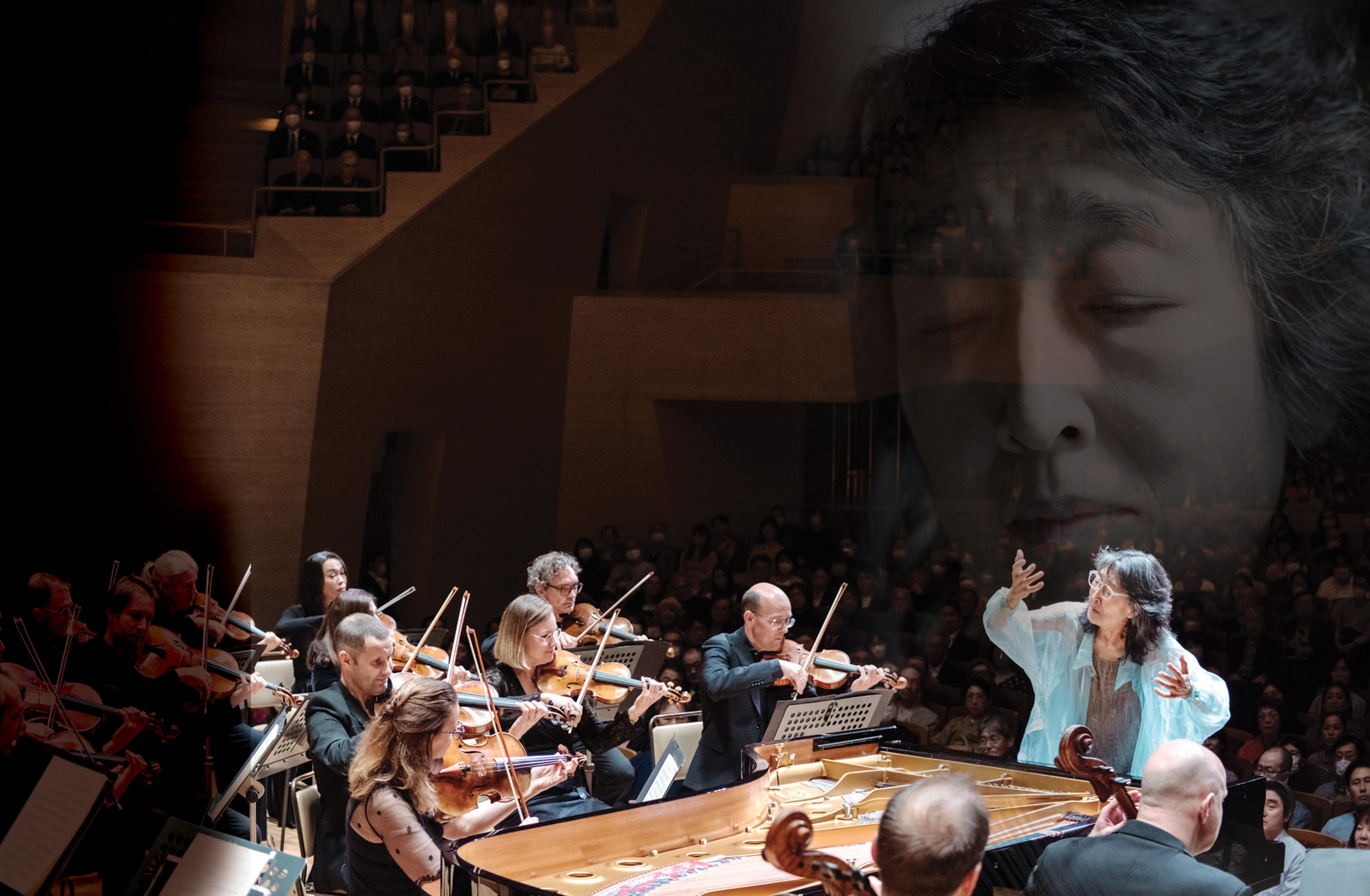
and is a particularly close Uchida collaborator. The international ensemble, comprising musicians from 20 countries, “comes together to do very specific handpicked projects; it’s not an orchestra that works year-round,” Guzelimian says. “So there’s a collaborative spirit that’s very unusual among orchestral cultures.”
Because the musicians in the chamber group have such varied backgrounds, Guzelimian says, “the intensity of listening is very charged. I call it deep listening, and it’s almost the diametric opposite of routine, which also defines Mitsuko. There’s a kind of immediacy in her sense of exploring even the most familiar music. It’s like having the paint on an old master painting cleaned for the first time, and you see the vibrancy of the colors, or the connection among the images in a way you never saw before.”
Uchida is scheduled to play three of Mozart’s piano concertos at the 2024 festival while also conducting the orchestra — similar to how the composer himself presented the pieces. She said in an interview with Classic FM that this dual approach fits “with Mozart’s idea of how the concerto form works. From Beethoven onwards, composers saw the concerto as
74 OJAI MAGAZINE | SPRING ‘24

a kind of contest between the soloist and the orchestra. But with Mozart, they’re very much partners. The music is like an ongoing conversation between the piano and the orchestra.”
Uchida has revisited Mozart’s piano concertos many times throughout her career, most recently with the Mahler Chamber Orchestra in performances around the world, but her interpretation of the composer’s keyboard masterpieces is anything but a familiar retread.
“This was the music that brought her to international fame,” Guzelimian says. “She’s revisiting it with a lifetime of wisdom, knowledge, and experience — and without ever having lost her sense of wonder.”
Uchida, who is refreshingly frank in an interview, says she keeps returning to Mozart “because I’m stupid. You forget what you did yesterday. Today, you are a different person.”
Guzelimian says all the artists and composers have very different musical vocabularies and styles, but they share “an intensity of craft, a deep seriousness of purpose, and core expressive power.”
75 OJAI MAGAZINE SPRING ‘24
Mitsuko Uchida conducts at the Suntory Hall in Tokyo. Photo: Geo roy Schied





Performing at this year’s festival:
Top left: The Brentano Quartet
Photo: Jürgen Frank
Below left: Sae Hashimoto
Photo: Ralf Brunner
Top right: Alexi Kenney
Photo: Yang Bao
Below right: Ljubinka Kulisic
Photo: Supplied
Left: Jay Campbell
Photo: Mike Grittani
ATONAL EXPRESSIVITY
Uchida is also devoted to the works of Schoenberg, who somewhat narrowly and unfairly has been deemed responsible for atonality in modern music. The 2024 festival’s opening night concert will feature works by composers of the Second Viennese School — the name for Schoenberg and his students, including Alban Berg and Anton Webern.
Schoenberg’s music has been stereotyped as severe and foreboding. But Uchida, Guzelimian says, ”doesn’t see him as the boogeyman. She finds the expressive power in Schoenberg and sees it as an outgrowth of very late Romantic music.”
Uchida was a teen when she first encountered Schoenberg. After her piano teacher told her to learn his “Opus 11 (Three Piano Pieces) over the summer holidays,” she says in an Arnold Schönberg Center interview, “I went and got the music, and came home and looked at it and said, ‘Oh god, the guy is mad.’”
Still, she found Schoenberg’s works easier to learn than Debussy’s, Mozart’s, or Schubert’s, and later began to juxtapose Schubert’s works with Schoenberg’s to demonstrate their connections.
The Ojai opening-night concert will include Schoenberg’s “String Quartet No. 2,” groundbreaking for its atonal composition. When the piece was first performed in Vienna in 1908, the audience booed, especially during the final two movements featuring a soprano added to the standard two violins, viola, and cello. The uneasy, fragmented sound was cacophony to audiences used to more melodic harmonies.
The third and fourth movements feature the poetry of German writer Stefan George set to music. The fourth, titled “Entrückung” (“Rapture”), begins with the line “Ich fühle luft von anderem planeten,” or in English, “I feel air from another planet.”
How very Ojai, and perhaps even more so, how very Mitsuko Uchida.
For tickets and more information about the 2024 Ojai Music Festival, June 6-9 at Libbey Bowl, Ojai Valley School’s Greenberg Center, and other Ojai locations, visit ojaifestival.org or call 805-646-2053.
76 OJAI MAGAZINE | SPRING ‘24

77 OJAI MAGAZINE SPRING ‘24




78 OJAI MAGAZINE | SPRING ‘24 From and to: Ojai, Meiners Oaks and Mira Monte For Just $1.50! The Ojai Trolley Service Continues to Run Serving the Needs of the Ojai Valley ADA, Medicare Card Holders, and Seniors 65-74 are 1/2 price. Seniors 75 and over, children under 45” tall and all students are FREE riders on the Trolley We’ll get you there! We’ll get you there! e Ojai Trolley Service, established in 1989, is owned and operated by the City of Ojai. e Trolley provides daily xed-route transportation to approximately 9,000 riders per month throughout Ojai, Meiners Oaks and Mira Monte. e Trolley is a well-known feature in the Ojai Valley, and in addition to the daily xed-route services, participates in many local community events, fund raising activities, community service, and educational functions. 408 South Signal Street, Ojai, CA 93024 Phone (805) 272 3883 • E-mail: transit@ojai.ca.gov • www.ojaitrolley.com 2023
A concert recreation of the Grammy award winning artist and band

March 8th 2024
The Canyon - Montclair

May 31st 2024
The Canyon -Agoura Hills

www.intheairtonightband.com
Get Tickets Here Get Tickets Here
Come celebrate the music of Phil Collins and Genesis …because there is something in the air tonight
to
Two Simply Fabulous Shows Coming
Southern California
CA L E N D AR C AL EN D A R
MARCH
“Digital Pop: Moving Lightly” Art Exhibit
Through April 7
Ojai Valley Museum
130 W. Ojai Ave.
ojaivalleymuseum.org
Group show featuring Ojai Artists
Ojai Historical Walking Tours
March 2, 10:30 a.m.
Ojai Valley Museum
130 W. Ojai Ave.
Tickets: ojaivalleymuseum.org.
Learn about Ojai’s unique history on a 90-minute tour led by docent Cricket Twichell.
Canvas and Paper
Paintings: Jean Metzinger
March 7 – April 28
311 N. Montgomery St.
Open: Thursday – Sunday
noon – 5:00 p.m.
Free admission canvasandpaper.org
Foraging & Firemaking with Christopher Nyerges
March 9, 10 a.m. - 3:30 p.m.
Euterpe Farms
587 S. Rice Rd.
$85
Register at herbwalks.com 805-646-6281

Jon Keenan: Recent Ceramics Exhibit
March 16 - May 4
Beato Gallery
Beatrice Wood Center for the Arts
8585 Ojai-Santa Paula Rd. beatricewood.com
“Fearless Women of Song”
Vocalists Sherry Shaoling and Shirley Xiao-Ling Wang with Pianist Hui Wu
March 24, 3 p.m.
Beatrice Wood Center for the Arts
8585 Ojai-Santa Paula Rd.
Tickets: beatricewood.com
March Full Moon Sunset
Nature Hike with Lanny Kaufer
March 24, 5:30-8 p.m.
$35
Register at herbwalks.com
805-646-6281
“Deer” at Ojai Art Center Theater
March 29 - April 21
113 S. Montgomery St.
Tickets and showtimes: ojaiact.org
Ojai Wild Food Experience with Lanny and Rondia Kaufer
March 30, 10 a.m. - 3 p.m.
$55
Register at herbwalks.com 805-646-6281
APRIL
Chamber On The Mountain
Presents: Dominic Cheli, Pianist: a Solo Piano Performance
April 14, 3 p.m.
Beatrice Wood Center for the Arts
8585 Ojai-Santa Paula Rd.
Tickets: beatricewood.com
Ventura Music Festival
Presents: Ukulele Orchestra of Great Britain
April 18, 7:30-9:30 p.m.
Libbey Bowl
210 S. Signal St.
Tickets: venturamusicfestival.org
122nd Ojai Tennis Tournament
April 24-28
Tickets and schedule: theojai.net
MAY
The Missing and the Found:
The Art of Ray Gabaldon & Tona Wakefield
May 4 - June 30
Logan Gallery
Beatrice Wood Center for the Arts 8585 Ojai-Santa Paula Rd. beatricewood.com
American Ceramic Society
Southern California Chapter Presidents’ Show
May 4 - July 6
Beato Gallery
Beatrice Wood Center for the Arts 8585 Ojai-Santa Paula Rd. beatricewood.com
SPRING ’24
Singer and Songwriter Donna De Lory in Concert
May 19, 3 p.m.
Beatrice Wood Center for the Arts 8585 Ojai-Santa Paula Rd. Tickets: beatricewood.com
47th Annual Art in the Park
May 25-26, 10 a.m. - 5 p.m.
Libbey Park
210 S. Signal St. ojaiartcenter.org/artinthepark
JUNE
Téka & Friends Brazilian Jazz Concert
June 2, 3 p.m.
Beatrice Wood Center for the Arts 8585 Ojai-Santa Paula Rd.
Tickets: beatricewood.com
78th Ojai Music Festival
June 6-9
Libbey Bowl
210 S. Signal St.
For ticket info. visit: ojaifestival.org email: boxoffice@ojaifestival.org or call: 805-646-2053
Ojai Talks
Presented by Ojai Music Festival
June 6, 3 p.m.
Greenberg Activity Center at Ojai Valley School 723 El Paseo Rd.
For ticket info. visit: ojaifestival.org email: boxoffice@ojaifestival.org or call: 805-646-2053
Ukulele Orchestra of Great Britain at Libbey Bowl
Photo: Wikimedia CC By-SA 4.0
80 OJAI MAGAZINE | SPRING ‘24


81 OJAI MAGAZINE SPRING ‘24


82 OJAI MAGAZINE | SPRING ‘24
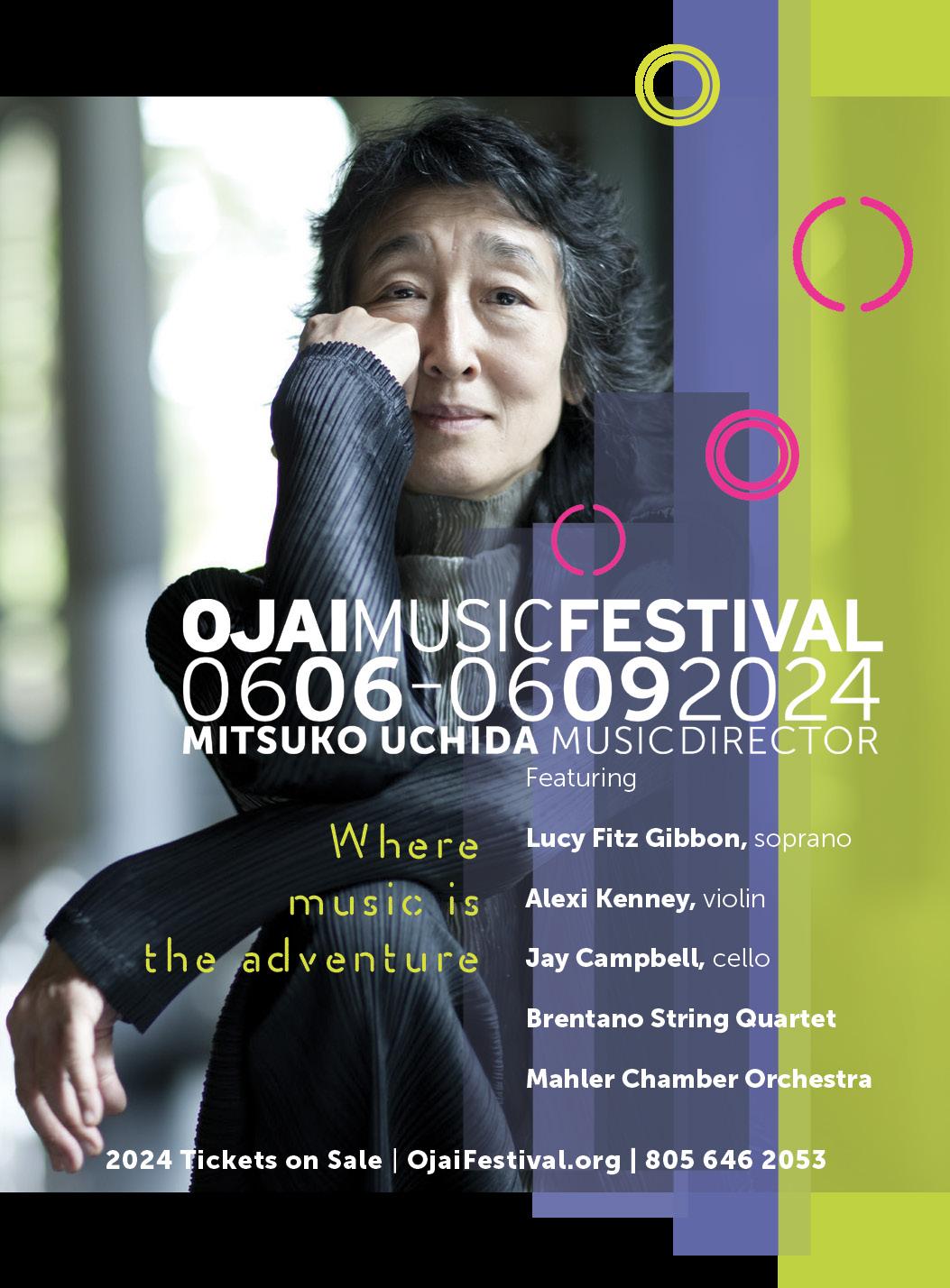


83 OJAI MAGAZINE | SPRING ‘24
 by ERIN LABELLE
by ERIN LABELLE

After looking at life through a camera for 28 years, I nd my memories are often stored as photographs, with each being a key to the door of past experience. emes emerge and the images connect. Like a photo series telling of perfectly timed synchronicities and chance encounters, they resemble prints strung clotheslinestyle on the wall of a cafe. One is titled “Six Degrees of Krishnamurti,” because the man and eosophy keep showing up in the most unexpected ways.
In the fall of 2019, my husband surprised me with an 11-day Italian adventure, and I began adding memory images to my Krishnamurti collection again. His invitation came at a busy time, encouraging me to step away from the nonprofit where I worked in Appalachian Ohio. Although Florence and Rome were on our itinerary, I eagerly anticipated time in Assisi, the land of St. Francis and St. Clare. We rented a farmhouse apartment outside the walled city and spent a few
days high above a fertile valley surrounded by orange and olive groves. The landscape and energy reminded us of Ojai.
On our second morning, I wanted to follow a meditative tour, while David opted for a photo walk to study light and shadow dancing among people and medieval architecture. Ruth Davis, of Assisi Retreats, generously shared “The Meditative Guide to Sacred Assisi,” after I’d emailed to inquire if she might be leading a group in the area.
Six Degrees
84 OJAI MAGAZINE | SPRING ‘24

of Krishnamurti
85 OJAI MAGAZINE | SPRING ‘24

Our paths didn’t cross, but their guide equipped me with information and meditations as I visited several significant sites.
The guide begins with an introduction by Rob Stucky, who describes Assisi as one of many places people are drawn to for the unusually uplifting atmosphere, referring to it as a spiritual power spot. As I walked through the arched doorway and entered San Francesco Piccolino, known as the birthplace of St. Francis, tears began to stream down my cheeks for a reason unknown to my conscious mind. Originally used as a stall for the family’s animals, the chapel is tucked away on a quiet side street with little foot traffic. Dark wooden benches line the stone walls, with an altar at the opposite end.
As I reviewed the meditation, my heart felt eager to begin: “As you find yourself slowing down and being, you begin to find the gift of simplicity — the essence and secret of Francis’ and Clare’s practice.” I chose a seat and closed my eyes, intending to sit for the suggested 20 minutes.
Tears started again, and I let them flow, feeling grateful to be alone. Less than five minutes had passed when I heard footsteps. As I attempted to stay with meditation, the sound multiplied. I opened my eyes to find an Asian Catholic tour group led by a priest and several nuns. They squeezed onto the benches, and I shifted to a space on the floor. The group began a call-and-response prayer while I continued to observe in silence, hearing the name Jesus interspersed with indistinguishable sounds. To witness the unlikely merging of East and West in the birthplace of Italy’s patron saint was profound.
The group soon flowed back onto the street, leaving me in the sacred energy they’d created to finish my meditation. Afterward, I walked through Assisi searching for a decent cup of tea or a vegetarian restaurant, quite the challenge in a country so proud of its coffee and meat. When I found the Italian version of an English tearoom, it was time to meet David for lunch. I raced up the hill to our agreed-upon spot, and talked him into walking back down the hill to the Monnalisa Caffe Bistrot.
The lunch crowd was beginning to thin as we entered the colorful cafe, where an entertaining man had been pulled out of the kitchen to wait tables for the day. The regular waitress broke her arm, and he’d been recruited to replace her by the owner, his high school friend. The two filled the space with creative chaos and joy, and we were able to converse with our limited Italian and their equally limited English. It felt like we’d stumbled onto the set of a magical movie, whimsical like Willy Wonka and Alice in Wonderland combined. In no time, the restaurant had emptied, and there was only one other couple across the room. Thrilled to overhear them speaking English, I asked where they were from, after sharing Ohio was our current home. They suggested their small, spiritual California community was most likely a place unfamiliar to us, but I informed them David grew up in California and we’d lived there for six years. As soon as I heard the word Ojai, I knew this was no ordinary moment.
What followed was a brief conversation about Ojai, Krishnamurti, Chumash shamans, the energy of Assisi, and their work. I was beyond stunned. We learned Veronica Krestow became a transformational coach after writing The Diamond Process to share a path she discovered during her own healing journey. She and her partner, Jason Frahm, focused on helping others see their triggers as opportunities to awaken. This was a breadcrumb on my path, but I wouldn’t realize it until we emerged from

After Kathy Bick moved to Ohio, Beato continued their friendship and conversation through letters, often including handmade art and newspaper clippings about her life.
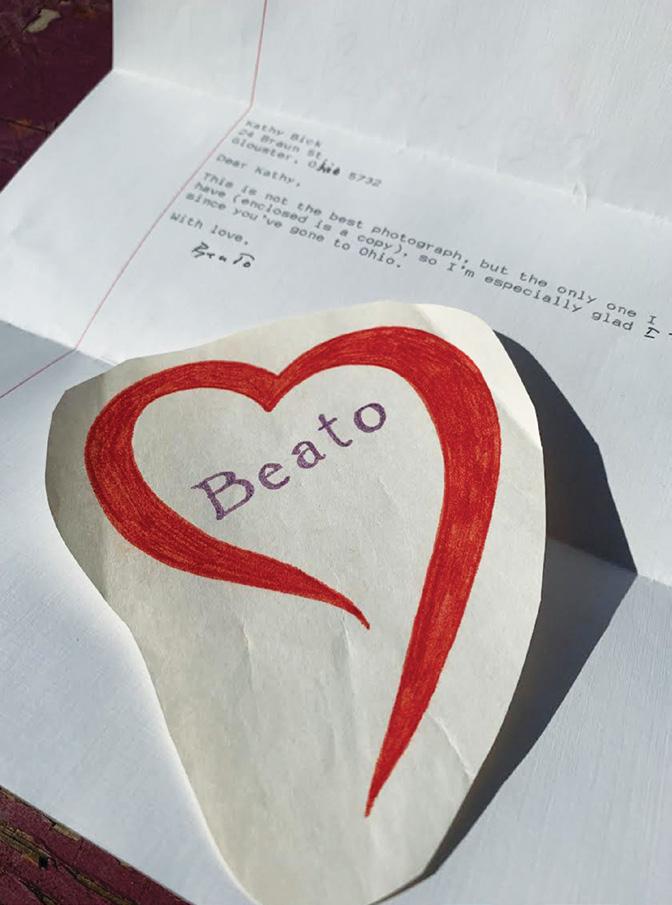 Marcel Duchamp, Francis Picabia, and Beatrice Wood at the Broadway Photo Shop, NYC, 1917
Photo: Creative Commons
Marcel Duchamp, Francis Picabia, and Beatrice Wood at the Broadway Photo Shop, NYC, 1917
Photo: Creative Commons
86 OJAI MAGAZINE | SPRING ‘24
Photo: Erin LaBelle
the pandemic and I stepped away from my work in mental-health recovery to become a writer and psychospiritual coach. Not long after returning to Ohio, we were making Thanksgiving plans. It was the first time our two sons would be away, and we were new in town, plus I was a raw vegan at the time. It made no sense to cook a traditional turkey dinner for one. Little did I know, my next memory image in the “Six Degrees of Krishnamurti” collection was about to happen when my intuition guided us to a community meal at a nearby Italian restaurant.
We joined a friend’s group at a long table, engaging in instant conversation. As the family-style meal was served, a woman entered the crowded dining area and claimed the seat next to me. Rather mysterious, with a weathered look and large, intense eyes, she quickly dove into our discussion. We learned she once taught visual communication at UCLA, and the inheritance of her uncle’s home had prompted the move to Ohio. Our new friend was thrilled to find we were photojournalists, and even happier to learn David had also taught

visual communication for years at several universities. Already smiling at the coincidence, her eyes almost shot out of her head in excitement when she learned he’d grown up in Ojai.
This animated, intelligent woman’s speech accelerated. It was as if we’d opened a compartment in her mind that hadn’t been visited for ages. When she asked if we’d heard of Krishnamurti, Annie Besant, or Beatrice “Beato” Wood, I recognized this as another one of those moments. The energy at our table continued to elevate as David talked of photographing Beato beginning in the ’70s, and included the part about how she was still quite the diva at almost 100. When our new friend began to go deeper into her story, I couldn’t believe we’d collided at an obscure Italian restaurant on Thanksgiving in Appalachia, just a few weeks after having a similar experience in Assisi.
When Kathy Bick was teaching at UCLA, she went with a friend to meet Beatrice Wood in Ojai. They hit it off immediately, and she visited on several other occasions, forming a friendship that continued even after Kathy moved to Ohio. Uncertain
why Beato embraced her so fully, she felt extremely fortunate. Kathy told us of their correspondences and mentioned the old Annie Besant book sent to her as a gift, complete with Beato’s annotations. We went home that night feeling grateful for the magic of the day and watched Mama of Dada and a documentary on Krishnamurti, reawakening a part of me I’d nearly forgotten.
A short time later, I was talking with my friend Lisa Monzon, who lives in Mira Monte, as I walked in our hilltop neighborhood. After I filled her in on the recent synchronicities, she spoke of her research on the history of their home. Lisa had found a few papers written by the original homeowner, a Theosophist named Ferdinand Mirus. She texted me his writing on Krishnamurti’s concept of “Choiceless Awareness,” and I sat at the bottom of a long set of wooden stairs, once again feeling a deep resonance. I recognized this moment as yet another “Six Degrees of Krishnamurti” photo memory.
87 OJAI MAGAZINE | SPRING ‘24
Several weeks passed and Kathy surprised me at work. She presented a large bag of books, letters, and newspaper articles, suggesting I take them home for a while. It’s surreal to contemplate how a Theosophical mini-archive found me in Ohio, right before the world shut down and right before I turned 50. Kathy ended up leaving her collection with me throughout the pandemic, and Beato was the ideal guide and inspiration for that moment in my life. One of my favorite clippings proclaimed: “Critics have said unkind things about Wood’s fascination with Theosophy and Krishnamurti and her rather simplistic views on world peace and other weighty issues. But others realize that she is a miracle; a woman who has earned the world’s respect on her own terms, a person who seems not to know that old age is supposed to be a curse.”
There was also an invitation to a 100th birthday and the premiere of Mama of Dada, the playbill from the Torch in the Sky
premiere, a red heart made by Beato, and several letters typed on Happy Valley letterhead. In one dated Oct. 30, 1992, Beato included a copy of a photograph made the last time Kathy was in Ojai. “I’m especially glad I have it, since you’ve gone to Ohio,” she said. Another, dated Feb. 5, 1987, describes a favorite Annie Besant book purchased by Beato in 1923: “I tried to get a new copy for you but was told it was out of print. Therefore, as a loving link between us, I hope you know that I have loved this book in spite of some of its pages being loose. Because we individually respond to different concepts, if this book does not have meaningful thoughts for you, then return it.” Beato closed with, “Yours, for a trip in the sky,” before signing her name.
When we emerged from social isolation, Kathy met me at a park close to our home where she shared more of her Ojai adventures. Revisiting this chapter of her life from decades earlier seemed to energize both of us, and she agreed to hold Man’s Life in This and Other Worlds by Annie Besant for a photograph.
The synchronicities that began in late 2019 led me to a ninemonth Psychosynthesis Life Coach and Leadership program with the Psychospiritual Institute


in 2022. Psychosynthesis, a spiritual psychology combining Eastern wisdom with Western knowledge, was founded in 1911 by Italian psychiatrist Dr. Roberto Assagioli, who, according to his niece, was also a Theosophist. Many years earlier, I’d received dream guidance nudging me toward spirit science, but the end goal of the directive wasn’t clear, nor was the path to get there. With the illumination of hindsight, I can now see clearly that Theosophy, Krishnamurti, and Beatrice Wood kept showing up to move me one step closer. For that, I am eternally grateful.
Sri J. Krishnamurti with Dr. Annie Besant
Photo: Wikimedia CC
88 OJAI MAGAZINE | SPRING ‘24
In 1987 Beato sent Kathy Bick the Annie Besant book she’d originally purchased in 1923.




90 OJAI MAGAZINE | SPRING ‘24



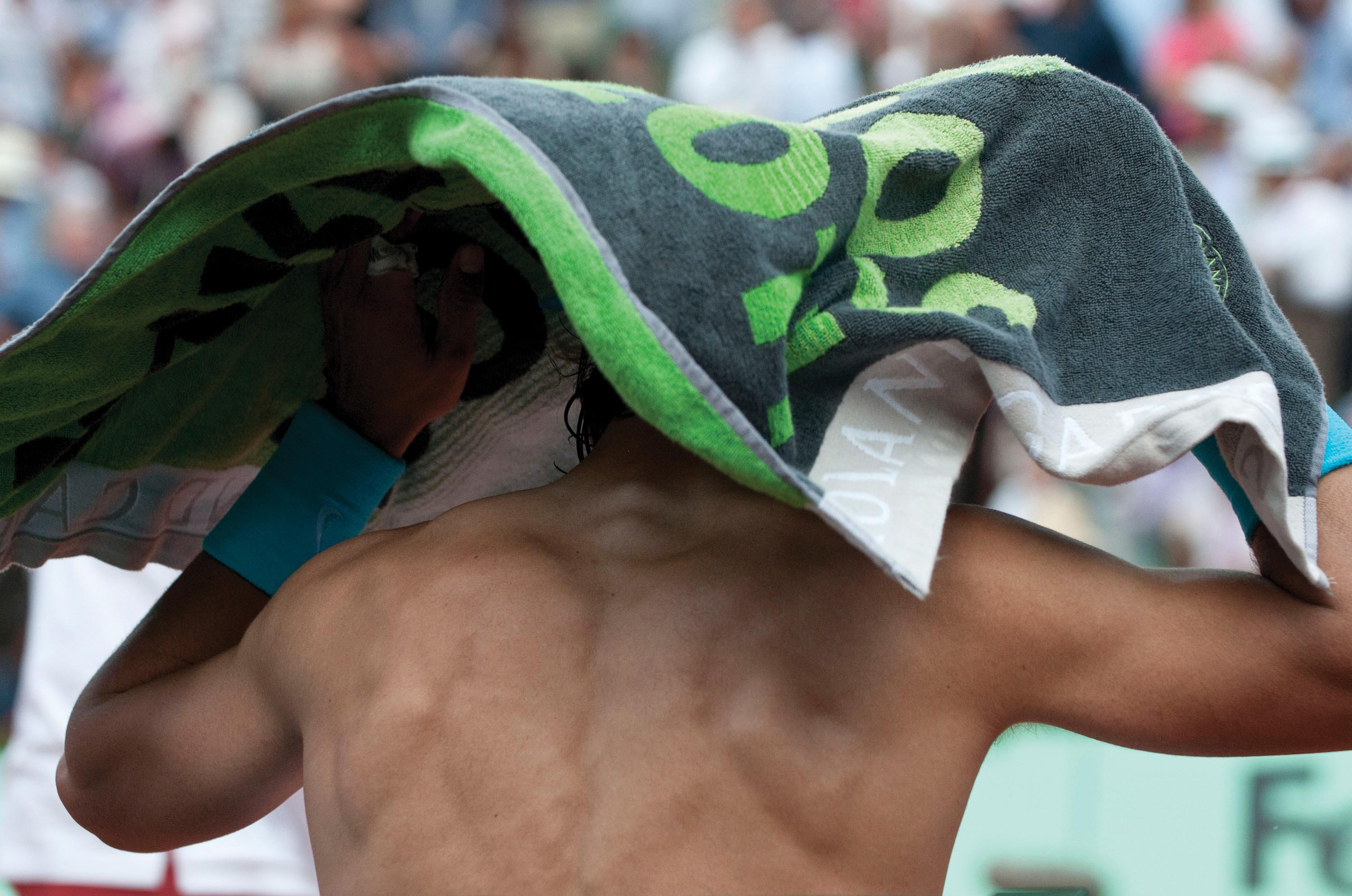
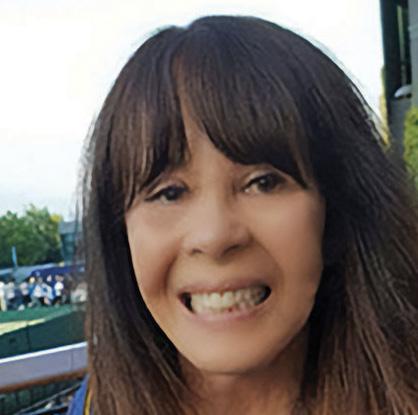

[ web:CynthiaLum.photo ] [ Instagram:Cynthia.photo ] [ CynthiaLum.photo@gmail ] [ +1310 780 2905 ] 91 OJAI MAGAZINE | SPRING ‘24
CYNTHIA LUM PHOTO



92 OJAI MAGAZINE | SPRING ‘24


93 OJAI MAGAZINE | SPRING ‘24
 by PERRY VAN HOUTEN
by PERRY VAN HOUTEN
Jacey Clear
As an artist, Jacey Clear has worn many hats, and to describe him as a “Renaissance man” would be accurate, but maybe a little too highbrow for his liking.
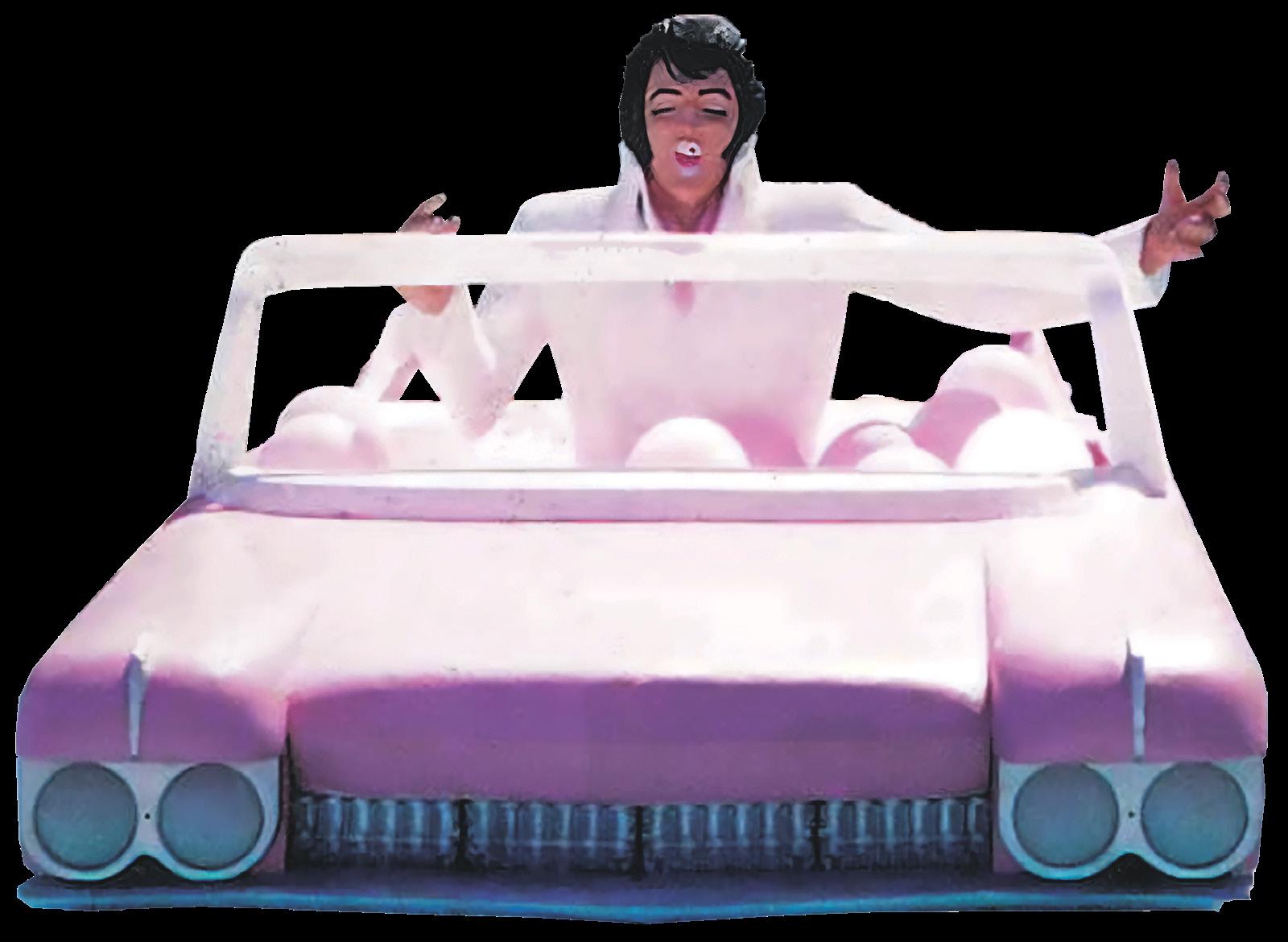
RENAISSANCE MAN

Instead, he prefers self-labels like “Retro Man” and “Captain Observo.”
“I pay attention to everything on the planet and I register it,” says the 73-year-old painter, sculptor, set designer, playwright, poet, and singer-songwriter. “I have that kind of cognitive framework.”
Right at home in an artistic community like Ojai, Clear resides in an old, renovated barn in the Arbolada where every corner of every room is a reflection of his art.
Born in 1950 in St. Paul, Clear spent his early childhood in Upsala, in Morrison County, Minnesota. “If you draw an ‘X’ through the state it’s in the center,” he says. “The name of the town is right there on the water tower.”
In those days, Upsala consisted of widely scattered farmhouses and a small downtown area. “This is Mayberry, where I’m from,” says Clear. The town itself was smaller than Meiners Oaks, and when he left the population was 425. “So it’s 424 now, I guess.”
Clear was one of four kids, and his family alternated between Upsala on weekends and the suburbs of Minneapolis during the school week. Dad was a blacksmith and a welder. One thing his son learned early on was that “the city people weren’t like the country people.”
In school, Clear excelled in track and gymnastics. “I liked Burt Lancaster and all The Crimson Pirate movies,” he says. “I could do
back-handsprings and backflips and high bar and all that jazz.”
After high school he worked 12-hour days at Pillsbury shoveling grain in a grain elevator for $4.50 an hour, and in his free time drew caricatures of his co-workers.
Because she didn’t want his artistic talents to be wasted, a girlfriend coaxed Clear into getting a formal college education, leading to a diploma from North Hennepin Community College in Brooklyn Park, Minnesota.
After college, he worked as an illustrator for catalogs such as Banana Republic and Jandd Mountaineering. One of the first things Clear built was a jukebox, constructed from flat acrylic stock that he bent into curves in his mother’s oven. Years ago, he sold the jukebox, outfitted with an 8-track tape player and a full array of lights, for $1,200.
Musical influences can be found throughout Clear’s home workshop, where in the loft he has re-created Rosa’s Cantina from the 1959 Marty Robbins song “El Paso.” In the living room is an old player piano that doubles as a piano bar.
In one corner of the barn is an east-facing window painted by Clear that shows the view you’d see if it actually were a window. He’s currently in the process of building his “Pirate Room,” which will be decorated like the inside of a ship captain’s quarters.
In 1978, Clear came to California for three
94 OJAI MAGAZINE | SPRING ‘24
A life-size Elvis in a pink Cadillac convertible, all made of styrofoam.

‘Every dream I ever had has come true’
— Jacey Clear, in a 2009 interview
95 OJAI MAGAZINE | SPRING ‘24
Painting a reproduction of “The School of Athens,” a 16th century fresco by Italian artist Raphael.


96 OJAI MAGAZINE | SPRING ‘24
Above: Laying down vocals at SNM Recording Studio in Santa Barbara.
Below: The Rolling Stones immortalized in Clear’s fantasy Mount Rushmore. Photo: Sean Hendrick

Enjoy Yourself
There’s no real struggles and no real strife
We’re born to this world
all blessed with life
Our stories unfold
In mysterious ways
From the inside out in the membership of your days
Still the only real calling and purpose of the poem
Is to feel our own existence
Then finally bring us home
We ask ourselves what’s really true
Your part is you
Nothing left to do
Enjoy yourself
To laugh
To cry smile or frown
From the inside out
Choose up or down
Enjoy yourself

“Enjoy Yourself” by Jacey Clear months, then moved here permanently (or so he thought) in 1980, settling for a time in Santa Barbara while working at Kinko’s in Goleta. He rented a house from Caitlyn Jenner in Isla Vista, the home Jenner lived in when she was training for the Olympics. Clear says he always saw California in soft drink commercials but didn’t know it actually existed until he moved here.
While in Santa Barbara, Clear recorded four songs he wrote and performed, including one that got airplay on the Dr. Demento radio program, and another, “Hey Now,” which Clear sang Elvis Presley-style and pitched to Sesame Street. He even designed an Elvis Muppet to sing the song, but a television performance never materialized. Two other songs, “We Survived the Fire” (inspired by
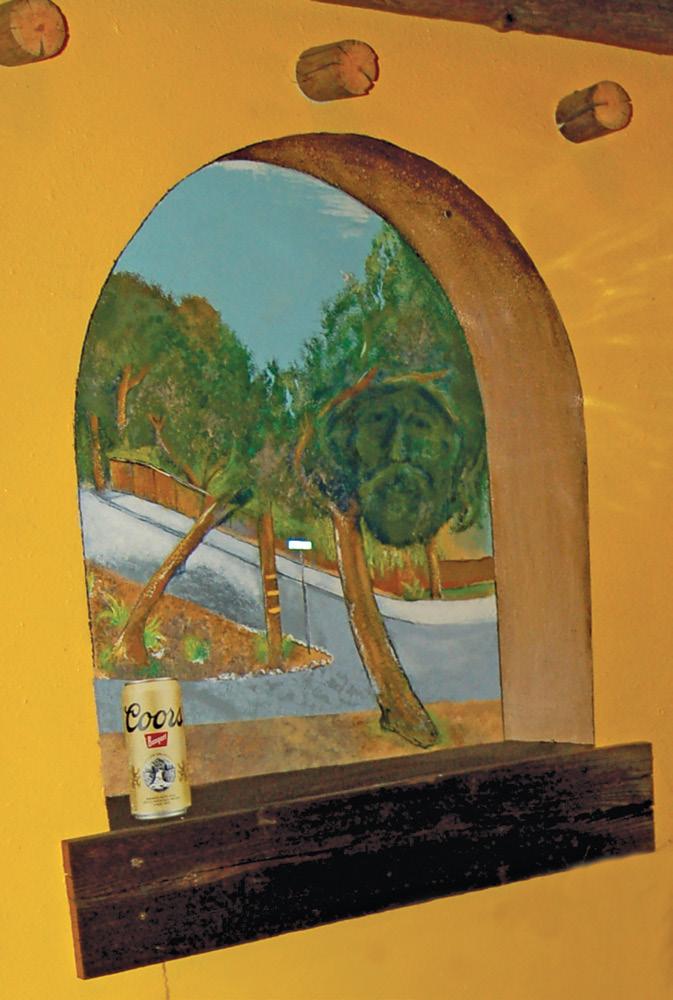
Billy Joel’s “We Didn’t Start the Fire”) and “Saving Water Is an Art” (to the tune of “If I Only Had a Brain” from The Wizard of Oz), dealt with serious wildfire and drought conditions Clear observed at the time in Santa Barbara. “It’s all part-and-parcel to this experience we call life,” he says. “You have to bear with it and make the best of it.”
There’s no use in our denying
That Lake Cachuma’s dying
It’s time to do your part
Keep the faith, set the trend
Take your shower, with your friend Saving water is an art
“Saving Water Is an Art”
An inventive set designer, Clear built and operated the 50-seat Starry Night Theatre in downtown Santa Barbara.
But his run there was cut short by a move back to Minnesota to care for his ailing father.
To pay the bills, he worked at the Jennie-O turkey processing plant before relocating with a girlfriend to Laughlin, Nevada. Right away he got a job at Don Laughlin’s Riverside Resort.
In Laughlin, Clear worked as a maintenance man for casino mogul Steve Wynn at the Golden Nugget, where his artistic talents were soon discovered and he was tasked with creating and producing props for special events and tournaments.
“Among his many props was an Eiffel Tower displayed in our hotel lobby for a French theme event and an actual-size pink Cadillac with Elvis in the driver’s seat that floated in the pool for a ’50s poker tournament,” said the Golden Nugget’s Carol Verdugo. “Each was an extraordinary work of art.”
He also created a 14-by-7-foot island that went in the pool, complete with a working volcano outfitted with lights and, for sound effects, a loop recording of an amplified Mr. Coffee as it brewed a pot.
Then there was Oscar, an exact, large-scale replica of the statues handed to winners at the Academy Awards that Clear sculpted in 1987. “I figured they may never give me one,” he says.
Clear cites as his biggest influences Walt Disney, MAD Magazine illustrator and Ojai resident Sergio Aragonés, Norman Rockwell, Michelangelo, and Leonardo da Vinci. One of his favorite quotes comes from entrepreneur Paul J. Meyer: “Whatever you vividly imagine, ardently desire, sincerely believe and enthusiastically act upon must invariably come to pass.”
After moving from Laughlin to Ojai in the late ’90s, Clear worked various odd jobs and made numerous signs for local businesses. But it was in Las Vegas that Clear saw a photo in a magazine that inspired his newest creation. It was a picture of The Rolling Stones, who were appearing at Caesars Palace. “They were all lined up, and the first thing that popped into my head, of course, was Mount Rushmore,” he says, “so I ran with that 23 years ago and started it.”
He finally completed the sculpture in Ojai in 2023.
The 4-foot-long, 2-foot-wide, 2 1/2-foot-tall sculpture is made of what Clear calls “absolute mixed media.” It depicts singer Mick Jagger, guitarists Keith Richards and Ron Wood, and late drummer Charlie Watts, and its completion was especially timely given the Oct. 20 release of Hackney Diamonds, the band’s first album of original material in 18 years, along with Jagger’s 80th birthday in July. Now, Clear is taking offers on his latest masterpiece. Are you listening, World’s Greatest Rock ’n’ Roll Band?
“One of those jokers might want it,” he says. “Maybe Mick or Keith would buy it. And I thought, ‘Nah, they wouldn’t, but you know what? I bet Ron Wood!’”
Clear says he’s enjoyed everything he’s done during his career and has no regrets. He’s made a lot of money, and spent most of it, but his art in its many forms has brought a lot of joy to people, and that’s what’s important. “All I care about is entertaining, and if people like it, I like it,” Clear says. “If you can make people happy, that’s really what it’s all about.”
Every corner of Clear’s home is a work of art, including a painted window that shows the view one would see if it were an actual window.
97 OJAI MAGAZINE | SPRING ‘24



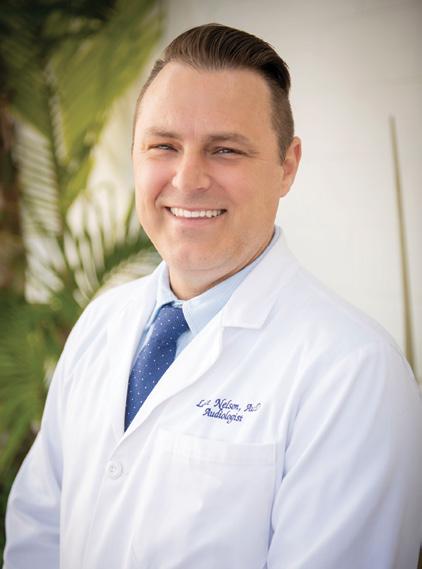

98 OJAI MAGAZINE | SPRING ‘24 NELSON AUDIOLOGY INC An audiology clinic dedicated to providing comprehensive hearing health care to improve quality of life for those su ering from hearing impairment DR LANCE NELSON is a compassionate, highly experienced, Board Certified Audiologist who has been practicing in Ventura County for over 10 years. He is excited for the opportunity to serve the community of Ojai. State-of-the-art facilities, diagnosis and treatment • Hearing Test • Hearing Aid Evaluations • Hearing Aid Services • Sales • Extended wear hearing solutions, ear cleaning, ear molds OJAI : 1320 Maricopa Hwy Suite B Ojai, CA 93023 VENTURA : 2674 E. Main St. Suite I Ventura, CA 93003 www.nelsonaudiologyinc.com




100 OJAI MAGAZINE | SPRING ‘24 To schedule an appointment with a licensed insurance agent, please call Lyn Thomas, CA License #0D96309 at 805-646-6409 Monday - Friday, 9:00am - 4:00pm Medicare Plan Informational Seminars Medicare 101 or Turning 65 and Still Working Go to www.LT-ins.com/seminars We help you with Medicare plans. Let us help at no cost to you. Lyndon Thomas Insurance is a California licensed insurance agency working with Medicare beneficiaries to explain Medicare Supplement, Prescription Drug Programs, and Medicare Advantage Plan options. We do not offer every plan available in your area. Any information we provide is limited to those plans we do offer in your area. Please contact Medicare.gov or 1-800-MEDICARE to get information on all of your options. 1211 Maricopa Hwy, Ste 222, Ojai, CA 93023 www.LT-ins.com


101 OJAI MAGAZINE | SPRING ‘24
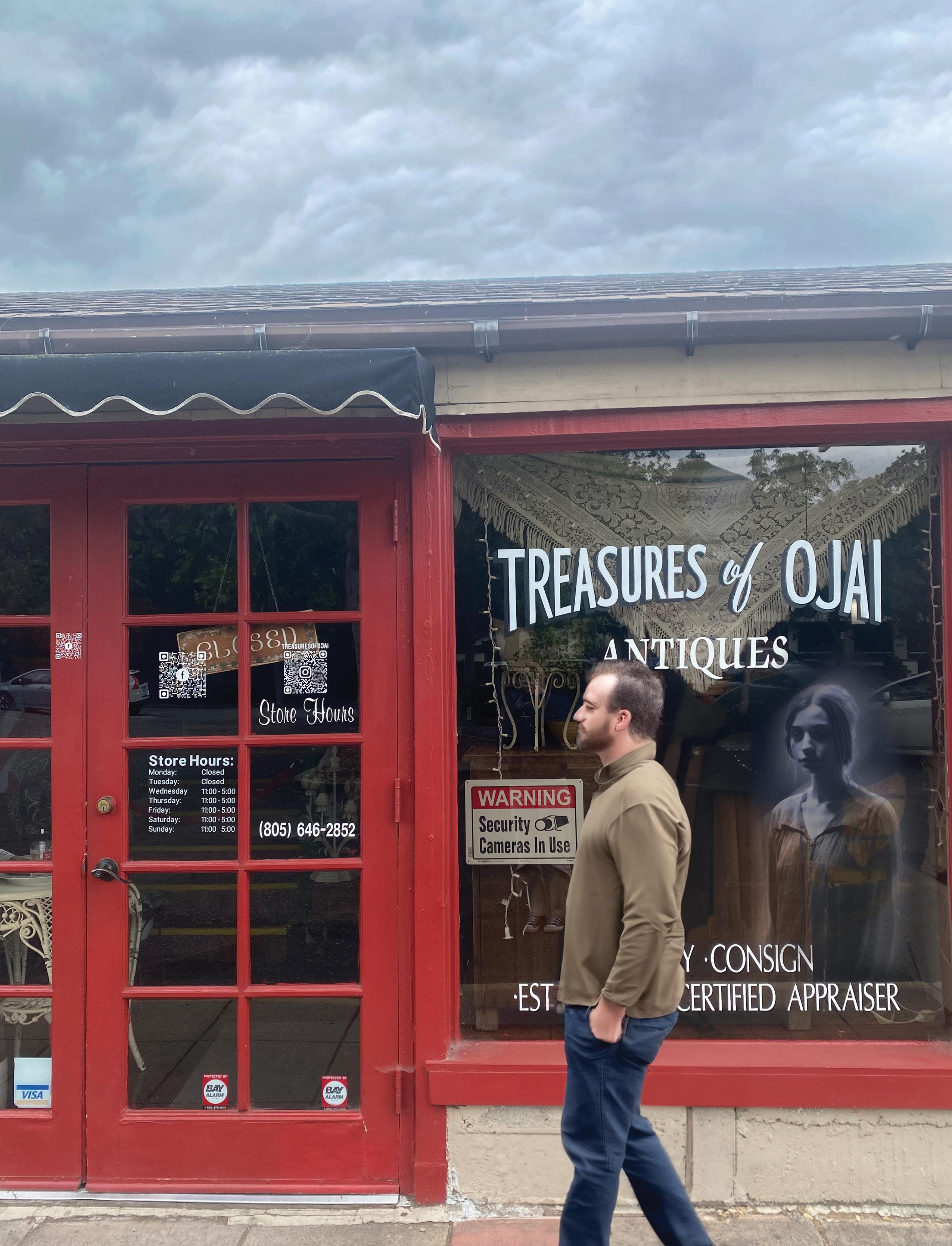
HAUNTED TREASURES?
102 OJAI MAGAZINE | SPRING ‘24
A series of bangs echoed from above. It wasn’t unusual for antique vendor Randy Painter to hear sounds of this sort while his colleagues tinkered in the workshop upstairs. But on this occasion, his heart began to mimic the hammering. Because there was no one upstairs.
This wasn’t the first time that Treasures of Ojai was the site of alleged paranormal activity.
Situated between the department store Rains and wine shop Pointe de Chêne, the store is filled with furniture, light fixtures, statues, clothing, knickknacks, and maybe also ghosts.
If ghosts do exist, wouldn’t an antique store, cluttered with belongings of the deceased, be their most obvious place of residence?
Some Treasures of Ojai staff certainly think so. They also believe that spirits could be tied to the property.
The Ojai Arcade, to which the store belongs, was built in 1917 by Edward Drummond Libbey. Before becoming an antique store in 1993, the building had been a livery, mechanics shop, garage, grocers, and even an underground venue for boxing and gambling.
At some point it was divided into two units, and Unit B — which would later become Pointe de Chêne — is believed to have held seances in the backrooms. Some locals have gone as far as to claim that the wall between the units is a sort of vortex, perhaps one that connects to the afterlife.
 by ALULA ALDERSON
by ALULA ALDERSON
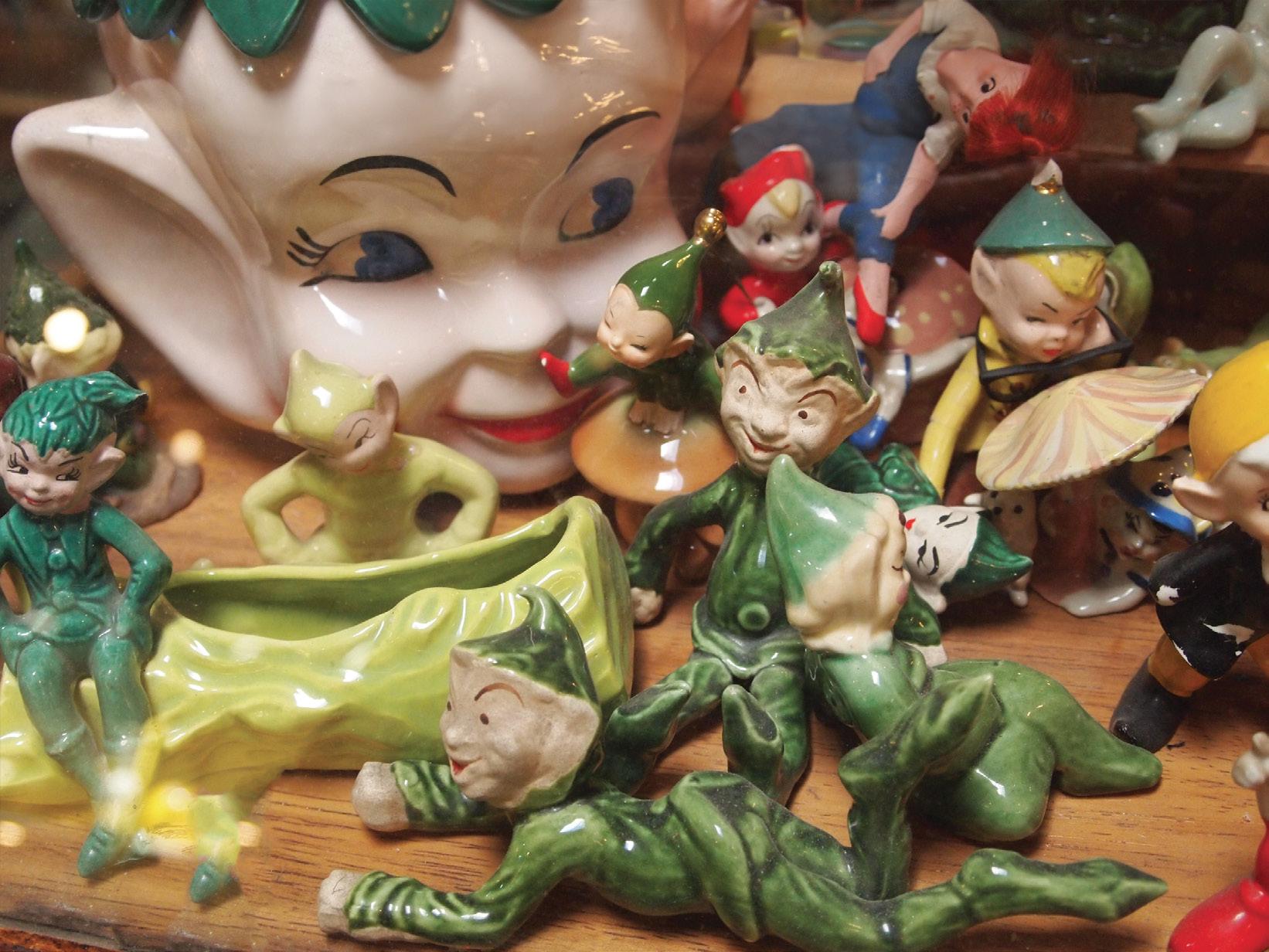
The staff aren’t aware of any vortex or portal, but they have their fair share of superstitions. “I always say ‘good morning, shop,’ and nine times out of 10, I hear a pop or a click or something, somewhere in response,” said Painter.
In one nook of the store sits a vast collection of jewelry. Bright lights deflect off chandeliers, mirrors, glass cabinets and the sparkling gemstones and silver that they contain. It’s here that Painter often catches a glimpse of movement out of the corner of his eye.
“I always think there’s a customer still in here after we close up,” he said.
If not a customer, who or what is creeping around?
One theory is that the deceased owner of the property when it was a mechanic shop, named Mac, still roams the building. This, Painter imagines, would also explain the eerie hammering.
Beside the register, 20 or so china pixies are kept in a glass display case, not to protect them from customers, Treasures of Ojai owner Katrina Sexton admitted, but to protect customers from them.
Before they were safely sealed away, the pixies reportedly disappeared and reappeared elsewhere, as if moved by an invisible hand or of their own accord. They were often found mysteriously smashed and had to be glued back together.
“Pixies not for sale,” a notice reads. “Sorry, they’re troublemakers!” Trapped within the glass prison, the figurines’ eyes follow visitors around the store and their grins convey something between mischief and malice.
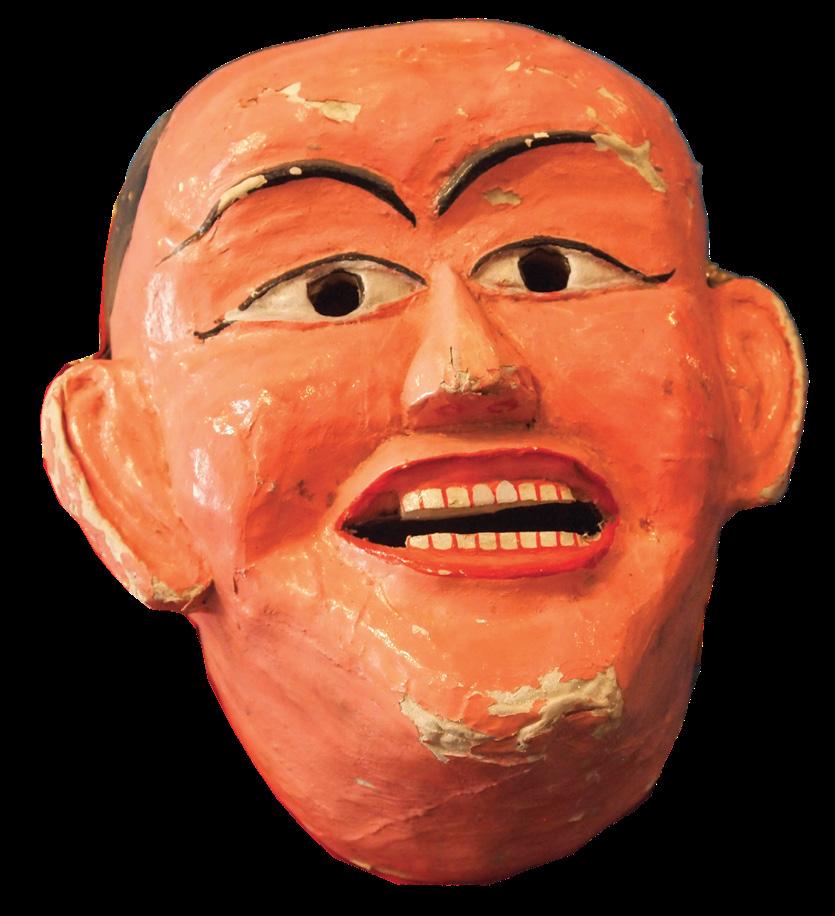
Painter’s tools also have a mind of their own, constantly shu ing around
“Pixies not for sale,” the notice reads
103 OJAI MAGAZINE | SPRING ‘24
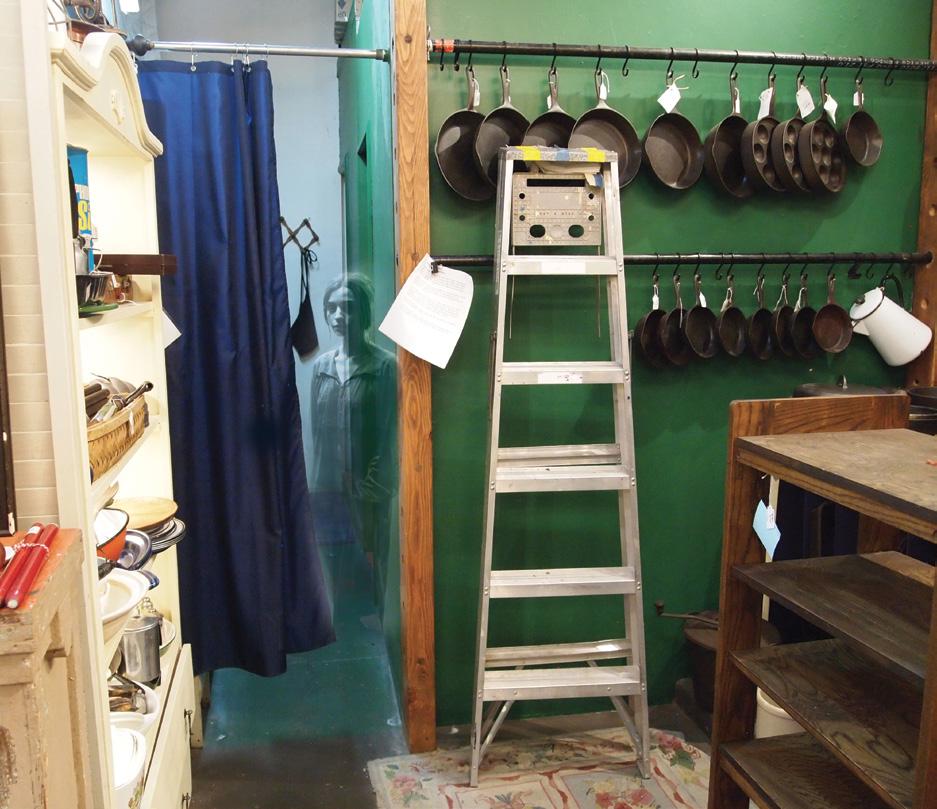
and being knocked off his workbench. But the staff are not the only ones who have had spooky experiences at Treasures of Ojai. Once, a photographer came in for a publicity shoot. She was heading to the back of the store, where the vinyls are located, when she was suddenly and aggressively pushed backward by invisible hands.
“She stopped, she turned on her heel, and she went right out,” Painter described. The photographer refused to step back inside the store, and all the pictures ended up being of the building’s exterior.
Thankfully, all the other phenomena has been fairly innocuous. Amanda Castro, a manager at Treasures of Ojai, believes that’s because the staff have a positive relationship with any spirits that might be present.
“When people bring something in, we look at it, we clean it, we repair it, we get it ready for sale, and then we find it a new home,” she said. “That sort of process, we’ve been told, releases a lot of attachment to spirits. It’s a form of purification because we are showing love and intent to an object and then getting it ready for its next life.”
In the same spot as where the photographer felt herself being pushed, stands an old wooden wardrobe. At 3 a.m. one night, security cameras caught it opening slowly and purposefully, as if someone were stepping out from the dark interior.
Painter considers this video footage proof that the haunting of Treasures of Ojai is not imagined. The wardrobe door doesn’t just swing open; one has to unlatch it and pull the handle.
Other tangible evidence was produced when a group called the Ojai Paranormal Investigators visited the antique store in 2011. They measured an EMF (electromagnetic field) of 22 milligauss near some sketches from the 1800s. For reference, the average electromagnetic field is only 0.1 to 4 milligauss. They also captured significant EVP (electronic voice phenomenon), which are recorded sounds that are interpreted as spirit voices.
But perhaps more than all this, it’s the feeling of presence that is convincing to the Treasures of Ojai sta . “It’s hard to describe the feeling,” said Sexton, pausing. “Like you know something’s around. It’s intuitive.”
Of course, skeptics will argue that the hammering was only a woodpecker, the lighting plays tricks on the eyes, the pixies fell from clumsy fingers, and Mr. Painter misplaces his tools. They will insist that the photographer was imagining things, the wardrobe managed to open itself, the EMF and the EVP were meaningless, and that this feeling Ms. Sexton describes is the product of paranoia.
It’s not hard to invent these rational
explanations for the happenings at 110 N. Signal St. — only there’s more. Just a few doors down from the antique store, the Ojai Village Pharmacy has also had strange occurrences.
A worker there casually let on that items fly o the shelves, but refused to comment further. Most notably, a woman in period clothing has been spotted by several witnesses. Even the previous owner, who was described as down-to-earth and not the type to believe in ghosts, attested to having seen her.
Castro suspects the seances could have invited this spirit to the area because her Victorian attire is out of place in Southern California.
Directly neighboring Treasures of Ojai, Pointe De Chêne has also borne witness to flying objects.
“Occasionally, a bottle will just eject itself out of a cubby and … it’s always when I’m not paying attention or talking to somebody,” said owner Bob Huey. It’s impossible to say for certain that these businesses are experiencing hauntings, but maybe the next time you step into Treasures of Ojai, you, too, will sense a blur in the line between the realms of the living and dead.

104 OJAI MAGAZINE | SPRING ‘24
If not a customer, who or what is creeping around?
A woman in period clothing has been spotted by several witnesses.





105 OJAI MAGAZINE | SPRING ‘24


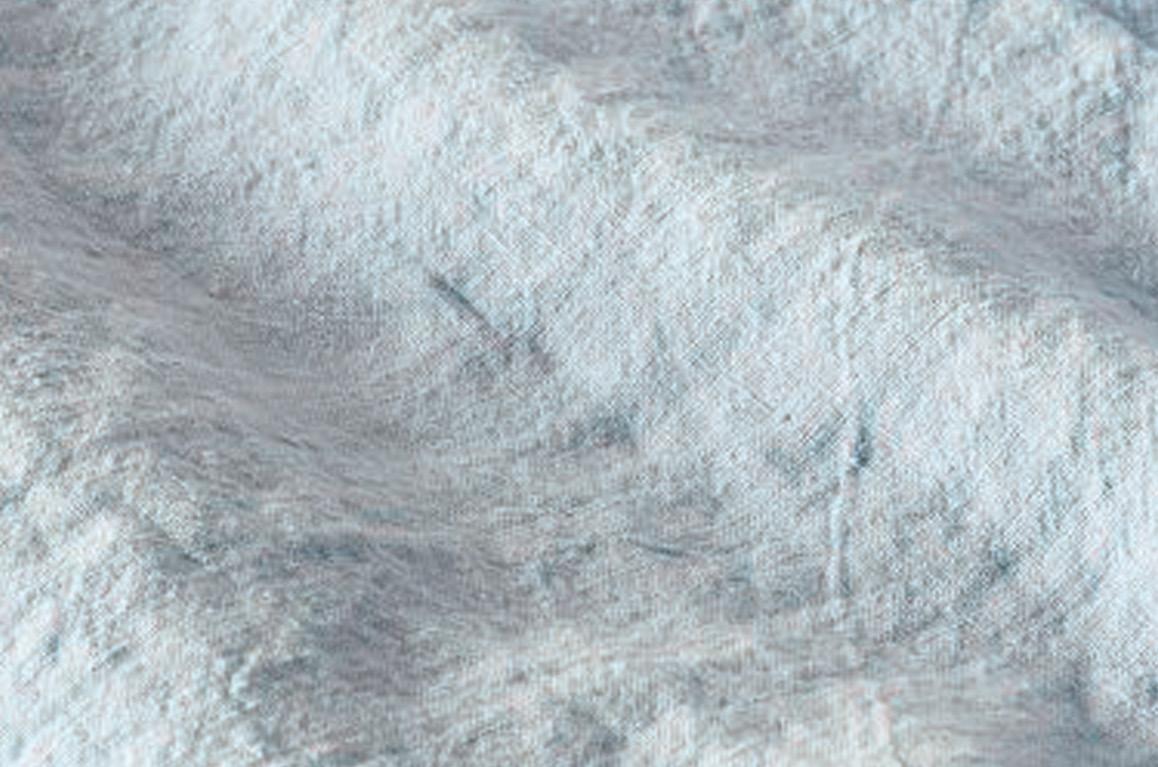
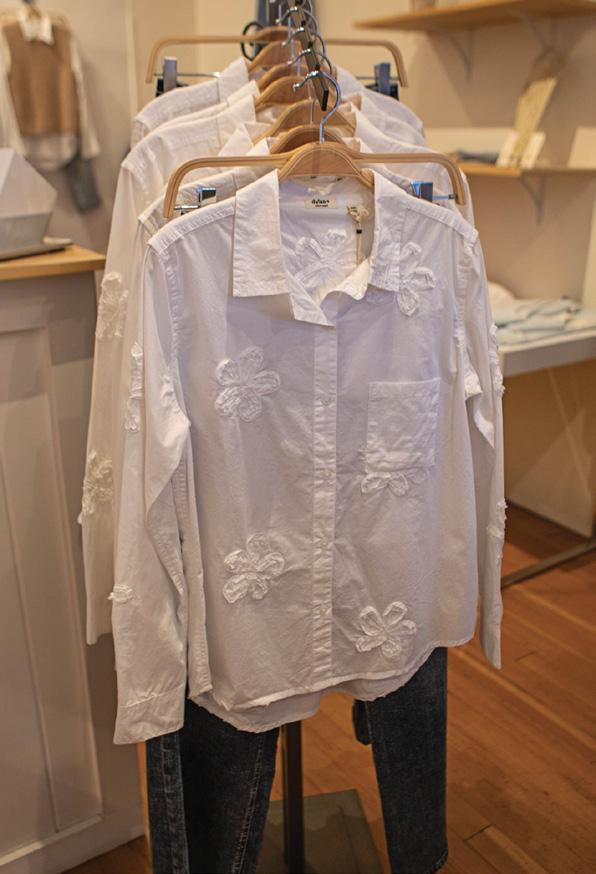


106 OJAI MAGAZINE | SPRING ‘24 Stationery Cards Gifts noted. 423 E.Ojai Ave. Suite 102 notedojai.com @noted.ojai Open Daily Wednesday - Saturday 11am - 5pm | Sunday 12pm - 4pm | Monday 11am - 5pmClosed on Tuesday 805-633-9097 Instagram: @miloplusmimi | Facebook: facebook/Milo+Mimi 318 East Ojai Avenue Ojai, CA 93023 Women’s & Men’s Contemporary Apparel


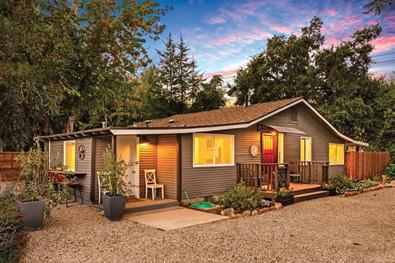



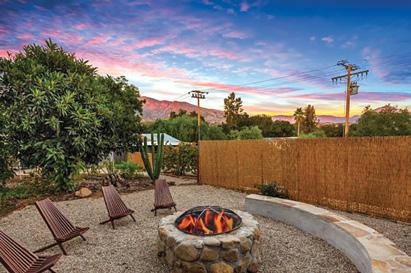
SUNFLOWER COTTAGE. sunnydaysvacationrentals.com
“We really enjoyed our stay. e beds were super comfy, linens were fresh, no dog smell for a place allowing pets. Lots of sun coming thru windows, bright and airy. Loved the cute kitchen, cooked most of our meals, co ee on the porch, breakfast outside, plenty of room the little pups to run around the yard! Amazing heat and water pressure too! Met the neighbor behind us, she recommended a farmers market, everything close by:) We did not want to leave!”
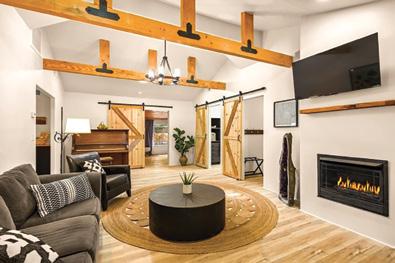

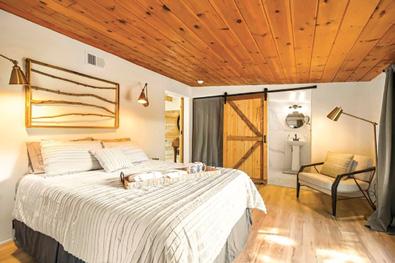
FARMHOUSE. sunnydaysvacationrentals.com
“Beautiful, newly remodeled house - rustic chic, just like the pics. Had everything we needed and beds were super comfy. Probably even better in warm weather when you could enjoy the lovely side cards and outside dining, but very comfy and cozy in the winter too. Well located about halfway between Ojai and Santa Paula with easy access to both. We had a great stay and recommend!”



107 OJAI MAGAZINE | SPRING ‘24
10% OFF YOUR BOOKING HCCOVN10


108 OJAI MAGAZINE | SPRING ‘24



At Totem Ranch, Reynolds Fleming is using regenerative-farming methods to create a new version of an operational citrus farm.
Modern farming has undeniably changed the world. Bringing about a bounty of agriculture, it’s helped to increase food production, decrease food costs, and boost job opportunities across the world. But it’s also wreaked havoc on the earth. Intensive farming practices have inflicted severe damage to our planet’s “digestive system,” the roughly 10 inches of topsoil where the majority of our food is grown. Just last year, the United Nations warned that up to 40% of available soil worldwide is now classed as “degraded,” and the mainstream answer to that problem — synthetic nitrogen fertilizer — accelerates global warming and pollutes waterways.
Biodynamic farmer Reynolds Fleming wants to be part of the solution. At Totem Ranch, his 60-acre regenerative citrus farm nestled in Ojai’s East End, he aims to help redefine the farming culture not only in the Ojai Valley, but also throughout California. Founded in 2015 and situated on land that was established as the Lismore Ranch more than a century ago, Totem Ranch embodies the agricultural legacy of its past, and at the same time, embraces a progressive vision for the future.
As a certified biodynamic farm, Totem Ranch operates — in a nutshell — on a level above organic farming, functioning as a self-sustaining ecosystem minimally dependent on external materials.
According to Demeter, the nonprofit certifier of biodynamic farms and consumer products in the U.S., one of the fundamental aspects of biodynamic farming is understanding that the health of soil is paramount, with emphasis on its
 by KERSTIN KÜHN photos courtesy Totem Ranch
by KERSTIN KÜHN photos courtesy Totem Ranch
vitality through composting, integrating animals, cover cropping, and rotating crops.
So, without the use of synthetic fertilizers, herbicides, or pesticides, Fleming cultivates four citrus varieties: Valencia and navel oranges, lemons, and Pixie tangerines. While he acknowledges the complexities of navigating an industry still entangled in conventional practices, he is committed to effecting change.
Walking among the orchards at Totem Ranch, it’s plain to see that the soil is a healthy, natural growing environment.
In addition to the citrus trees, around 50 diversified fruit trees are scattered throughout the orchards, while nutrientrestoring cover crops thrive all over the place.
There’s wildlife, too: Bees are buzzing about, pollinating, and owls help to control rodents, while livestock — chickens, ducks, pigs, and sheep — consume plant waste and produce manure to compost the soil, bringing it all full circle. Totem Ranch

is, quite simply, a little piece of paradise and a testament to the harmony between agriculture and nature. But as anyone who’s watched The Biggest Little Farm will appreciate, running a biodynamic farm isn’t always easy.
“The more I get into it, the deeper the wormhole becomes,” admits Fleming, who at 34 became a farmer after graduating from university in Los Angeles less than a decade ago. “I studied renewable energy and thought to myself, ‘What’s a better way to harvest the sun than by growing trees?’ Since then, it’s become allconsuming, yet I still feel like I’ve only just scratched the surface of it all.”
As we continue to wander through the orchards, with Fleming’s Great Pyrenees, Kazu, in tow, we taste wild blackberries, observe honeybees nested inside ancient oak trees, return a rogue hen to her coop, and pet his passel of kunekune pigs who snort in appreciation. “My inspiration comes from witnessing the difference in

111 OJAI MAGAZINE | SPRING ‘24
quality and the experiential value of this farm compared to places solely focused on the final product,” Fleming enthuses. Yet he acknowledges the slippery slope he treads, adding that the commerce-centric approach and the ecosystem-driven function of his farm constantly pull him in different directions: “We’re trying to create a product while also preserving the natural integrity of the system. Unfortunately, those two things are oftentimes in complete contradiction to each other.”
Undoubtedly, profitability stands as one of the greatest challenges for any farmer. The U.S. Department of Agriculture reported in 2020 that the average net funds generated by farm operators had been negative for nine out of the previous 10 years. And things aren’t looking like they’re going to improve either, with U.S. net farm income in 2023 projected to decline by 16%. However, Fleming argues that a broader issue is at stake, and biodynamic and organic agriculture offers more than just solutions for soil regeneration.
After eight years, Fleming acknowledges that Totem Ranch is an ongoing experiment, a microcosm striving to integrate into a larger system. The farm’s role within the economy of scale remains a puzzle he has yet to solve. But as a farmer, he understands that perseverance is the name of the game. “I pride myself on being a host to a multitude of different spirits to create and secure permanence in this space,” he says.
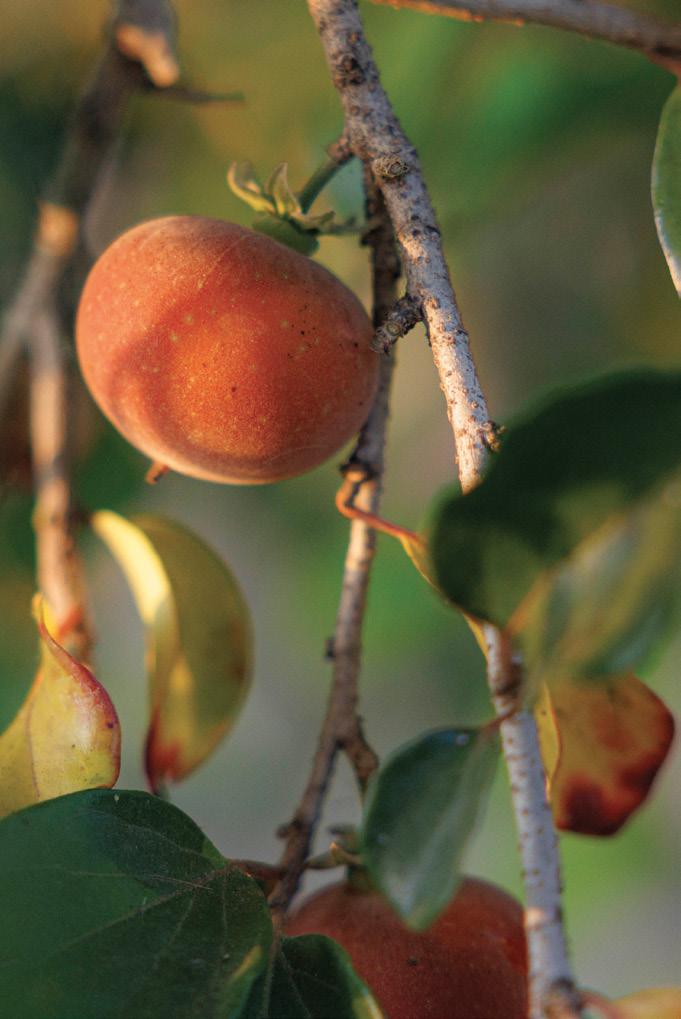

112 OJAI MAGAZINE | SPRING ‘24



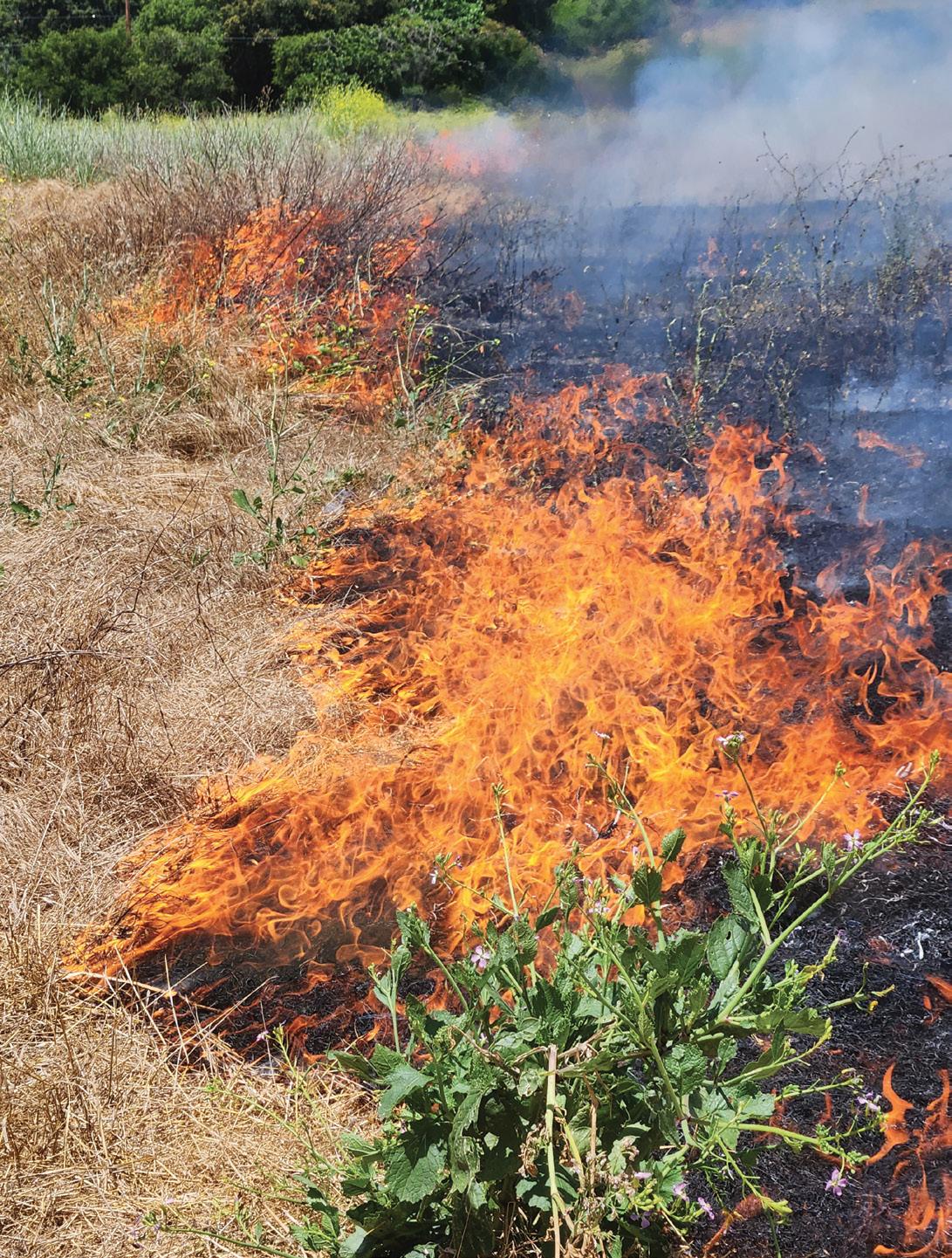



114 OJAI MAGAZINE | SPRING ‘24 The Home and Range crew offers professional vegetation management, hiking and horse trail maintenance, rattlesnake exclusion, wildfire resiliency consulting and more. Professional vegetation and land management homeandrangellc.com Instagram @homeandrange 805.358.1841 or 203.437.5059






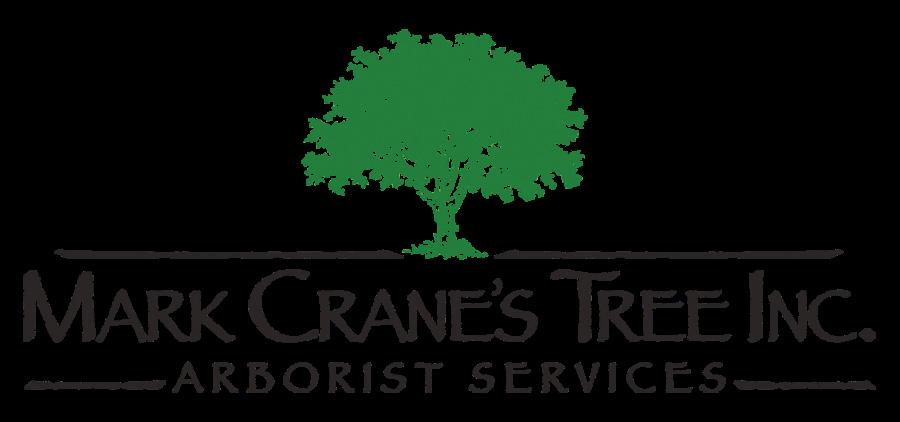

115 OJAI MAGAZINE | SPRING ‘24 We care About the Health, Safety & Beauty of Your Trees Owner Mark Crane, member of the American Society of Consulting Arborists, and his team of certified arborists, have been meticulously caring for trees in Ojai, Ventura, Carpinteria, Santa Barbara and Goleta since 1995. • Tree care planting & trimming • Drought services & fire safety • Emergency tree services • Tree evaluation • Hazardous tree & stump removal • Tree pruning & maintenance www.markcranestree.com (805) 646-9484 MON-FRI: 8:00 AM-5:00 PM 24-Hour Emergency Service RCA#592 2023

116 OJAI MAGAZINE | SPRING ‘24
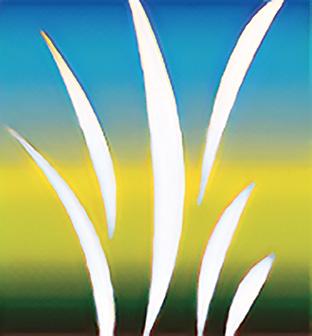




117 OJAI MAGAZINE | SPRING ‘24 SACRED GROUNDS landscape design sacredgroundsdesign.com Design + Consult + Installation Creating your beautiful, waterwise, outdoor retreat.
For Olivia Chase, the chef at Farmer and the Cook in Meiners Oaks, vegetables are a source of magic, and her newest, self-published endeavor is a compilation of recipes that share the avorsome results of using veggies as the root of one’s creativity.
In Farmer and the Cook’s Book: Recipes and Farm Stories from Ojai, California, mushrooms are transmogrified into crispy “bacon” with a rich depth of umami in the “MLT” sandwich with homemade aioli.
Savory-sweet sesame cookies are drizzled with hibiscus-rose glaze, running the gamut of flavor profiles for gluten-free dessert lovers. Jalapeño goat cheese poppers are crafted with game day in mind, tempered by a creamy sweet red pepper sauce; vegans can also enjoy a version of poblano pepper poppers that uses a silken cashew cream filling. The recipes in Farmer and the Cook’s Book are divided into two sections: selections served at the restaurant, and a broader base of globally inspired farm-to-table dishes. The book is a lactovegetarian love letter not only to Chase’s roots, but also to the workers and diners who have offered
Cook history with the community that has appreciated our quirkiness and our good intentions over these past 23 years.”
Of Farmer and the Cook’s evolution, Chase said: “We opened with a ONE Special a Day menu and a salad bar. I was hoping to keep it small and simple, unlike my previous restaurant, City Bakery & Cafe (in Ventura). Small and simple was not enough to support us, so we started adding anything and everything our customers asked for. Let me just say, we knew everyone. In about 2006, a family of five came in and said they wanted to stay and eat, but did not all want to eat the same ‘special’ dish. A lightbulb went off and I quite impulsively switched to a Mexican menu. The backbone of the kitchen had always been Mexican moms from the neighborhood, and a large menu could be created with different combinations of basic ingredients.
“On a deeper note, we had just heard the ethnobotanist Gary Nabhan speak at the EcoFarm Conference” in Pacific Grove, California. “He talked of a ‘sense of place,’ and given that I come from a Colombian American family, and California’s culture is so influenced by Mexico, I was convinced that it was a go.”
Farmer and the Cook staples in the book include Swiss chard and zucchini enchiladas, tangy “Mexi-kraut,” crunchy cashew “cheez” taquitos with Lupe’s mole sauce, and the classic bean and cheese burrito with
empanadas. The recipe connects me with my mom and one of my favorite travel destinations.”
Steve Sprinkel, Chase’s husband and literal other half — the farmer of Farmer and the Cook — contributed “Farm Stories” to the book. “Steve and I are both huge believers in organic agriculture, and for that, 99% of the ingredients on our menu are grown by us or other organic farmers,”

Farmer and the Farmer and the
invaluable input and contributed to the restaurant’s success since its inception in 2001.
“I am proud that we bootstrapped the business,” Chase said. “We started with two credit cards and about $4,000. … It is a challenge to run a restaurant when, for most of our employees, this is their first job out of high school. Saying that, the book is a tribute to those same employees that have become family. They are a spirited bunch and there is pride in what we have done, together. We also wanted to document our shared Farmer and the
fresh salsa roja. The dessert section features “some of our bakery favorites, including the iconic chocolate raspberry beet cake that Jasmine Wallet makes every Friday,” Chase said. “The easiest recipe might be Sarah’s Southwestern zucchini fritters. Fritters are quick to put together and great because they can be made with almost any vegetable.”
One recipe in particular is close to Chase’s heart. “I loved including a recipe for Colombian empanadas,” she said. “There is a great photo (of) our extended family around a giant table scarfing potato
 Top: Chile Rellenos
Above: Roasted cauliflower tostada
Top: Chile Rellenos
Above: Roasted cauliflower tostada
118 OJAI MAGAZINE | SPRING ‘24
Photos: by Ian Hughes
Chase said. She described one example of Sprinkel’s stories as “a middle-of-thenight return to the farm to see if, in fact, he turned the water off, to be met with the eyes of a mountain lion staring back at him. His brilliant writing describes the improvisational life of a self-taught farmer/ storekeeper.”
Chase has been cooking since she was 16 years old. Her food philosophy is influenced not only by family, but also by a host of cultures all over the world. “I am personally inspired by the Blue Zones, the geographical pockets in the world where people live the healthiest and longest lives,” Chase said “They include Costa Rica, Okinawa (Japan) and Loma Linda (California) … folks there are not eating a ketogenic diet or running marathons or eating croissants. I think that eating a highfiber diet with lots of vegetables, whole grains, and beans, is the way to go.”
Farmer and the Cook’s Book “took three years to make right on my kitchen table,” Chase shared. “The challenge with firsttime self-publishing is learning what the publishers already know. The structure, the style, the chaos on your computer, the proofing and the orchestrating of all of the parts. It sounds a bit like organizing your dinner prep, doesn’t it?” All the same, “The advantage of self-publishing is the DIY satisfaction, which dovetails with our whole attitude about cooking and being the bosses of our lives,” Chase said.
Cookbook
Chase always loves when people take an interest in her recipes. She hopes “the beautiful photos by local photographers Ian Hughes and Justin Bastien will motivate the urge to cook.
“Seeing a photo of a dish is so inspiring that I absolutely cannot help but cook whatever it is that caught my attention. Cooking well requires motivation, planning, skill, patience, and time. The result, I hope, is pleasure and pride in having prepared a healthy and delicious meal.”


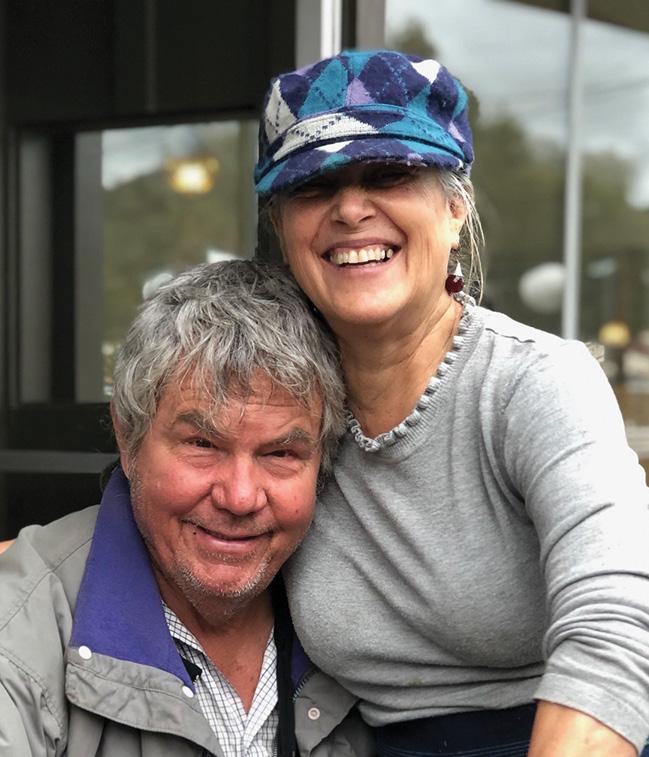
 by MIMI WALKER
by MIMI WALKER
Farmer and the Cook’s Book: Recipes and Farm
Stories from Ojai, California, printed by Jostens Commercial Printing, is available for purchase at the following Ojai Valley locations:
Farmer and the Cook, 339 W. El Roblar Drive
Bart’s Books, 302 W. Matilija St.
Sunday’s, 307 E. Ojai Ave.
Photo: Lina Tirado Mesa
Farmers Chris Everett, Shawn Westlake and Jean Zeibak
119 OJAI MAGAZINE | SPRING ‘24
Photo by Justin Bastien



Open Daily for Breakfast & Lunch 8am - 2pm Closed Tuesday & Wednesday Best Breakfast Best Customer Service Best Brunch 2023 2023 2023 328 East Ojai Ave. • 805-646-0207 120 OJAI MAGAZINE | SPRING ‘24
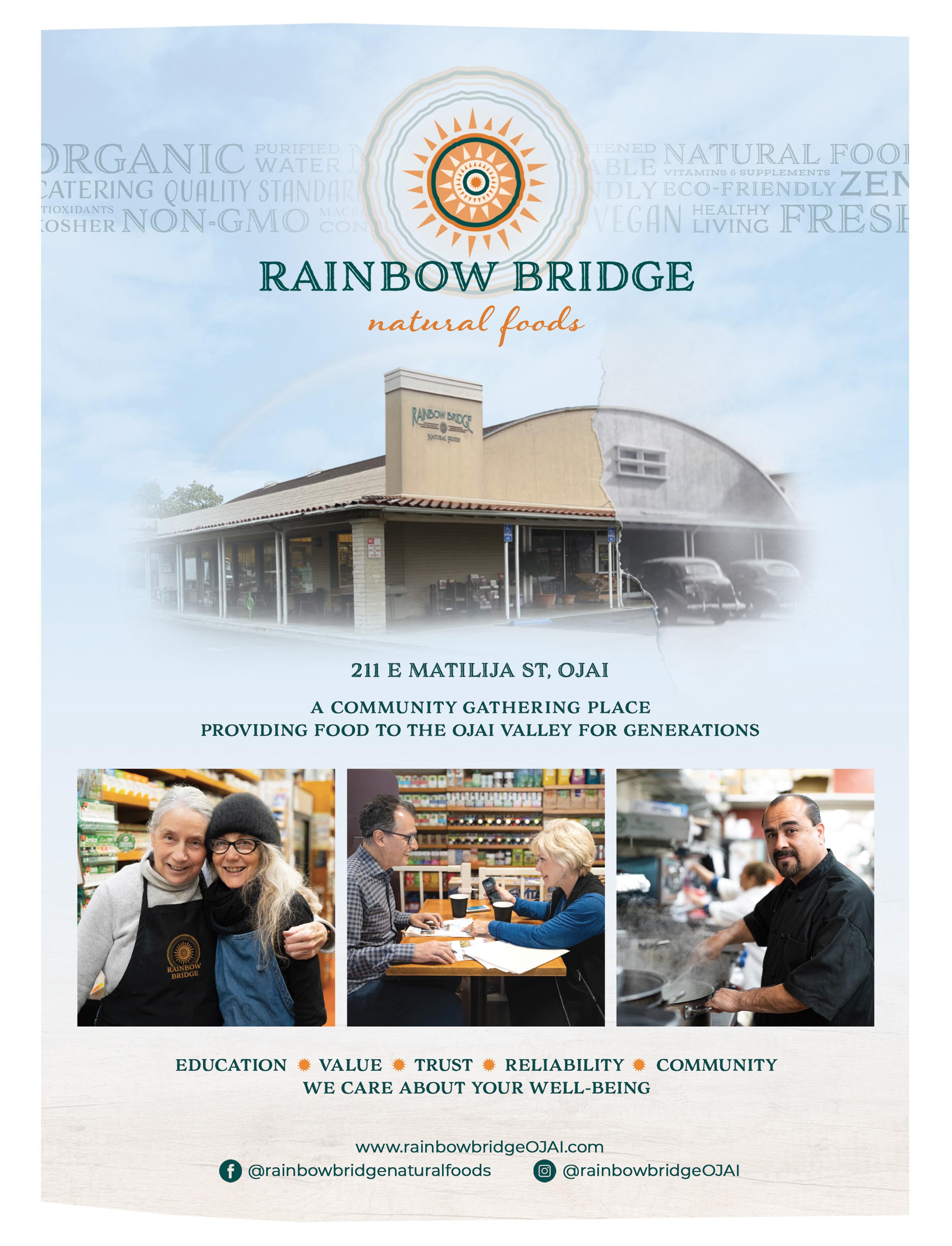
121 OJAI MAGAZINE | SPRING ‘24

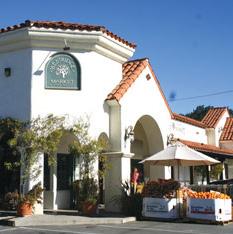
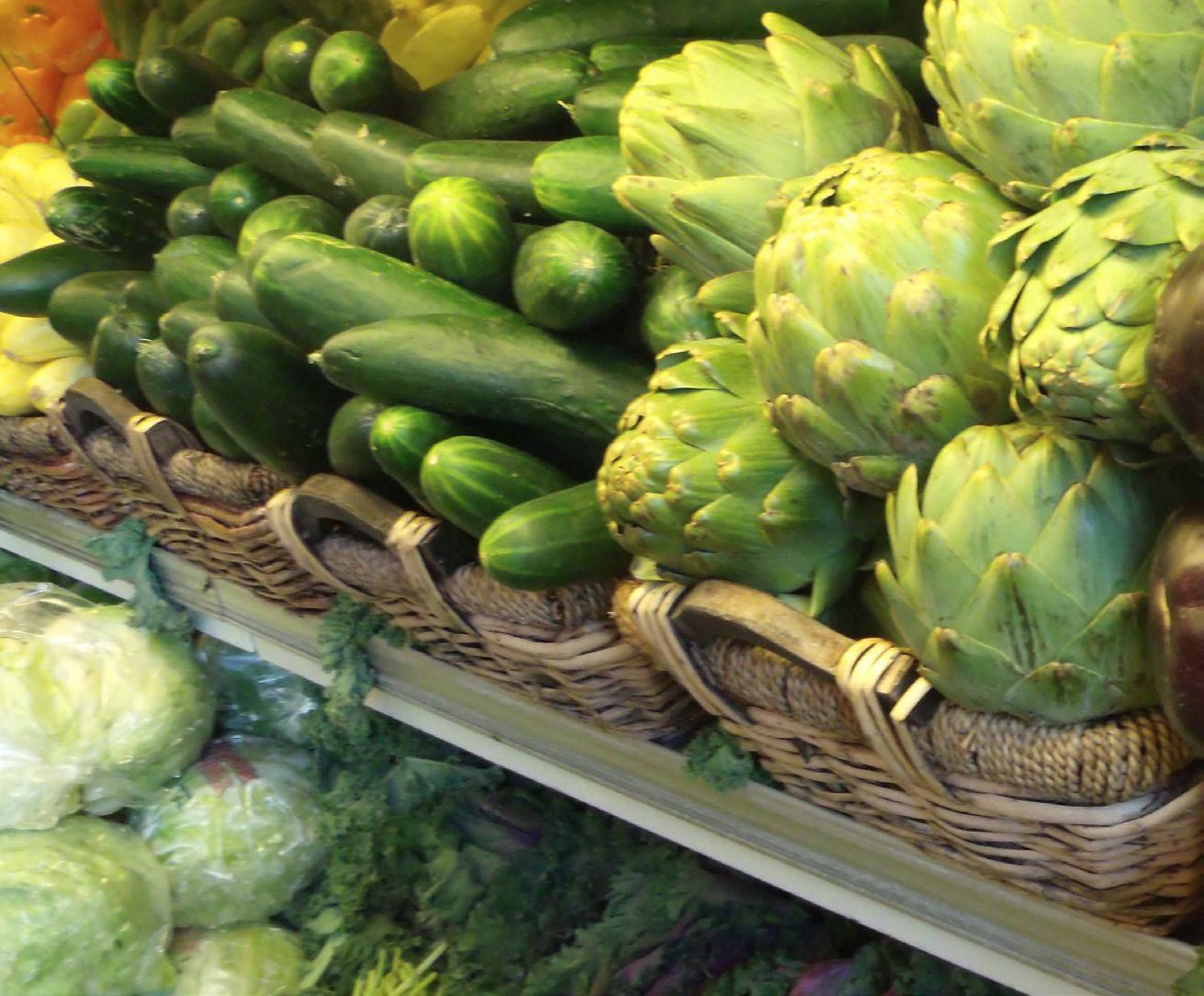


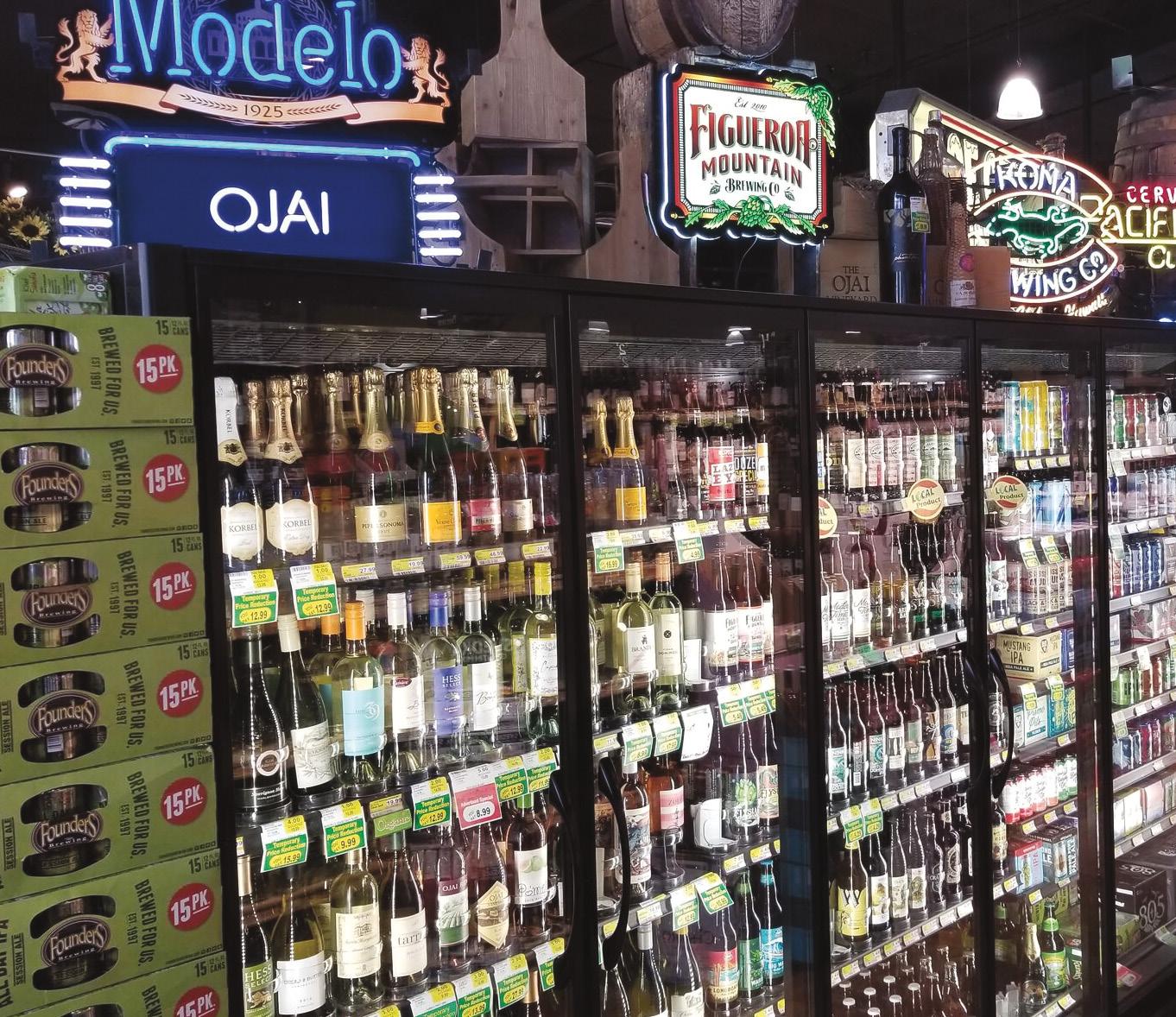

131 W. Ojai Ave • Open Daily 7am - 9pm • Phone 805-646-4082 802 E. Ojai Ave • Open Daily 8am - 8pm • Phone 805-646-2762 westridgemarket.com Westridge Midtown Market Westridge Market

123 OJAI MAGAZINE | SPRING ‘24
UNCORKING THE Naturalist Organic Winery
In the sun-kissed hills of California, where vineyards cascade endlessly, a quiet revolution is unfolding in the world of winemaking.
Enter Samuel Tulberg, the visionary vintner behind The Naturalist, a certified organic winery nested in the Ojai Valley.
More and more Americans seek to eat organic food, but what about drinking organic wine? Over 80% of the nation’s wine comes from California, making it the world’s fourth-largest wine-producing region. The demand for organic wine is growing, yet less than 2% of U.S. wine is currently labeled organic.
As the steward of The Naturalist, Sam (as he’s known) and his journey are not just a testament to the art of winemaking, but also to dedication, sustainability, and a relentless pursuit of purity. Sam traveled and worked for many wineries before making his way back to Ojai, where he’s originally from. In 2018 Sam became owner of Casa Barranca, a label started in 1999 where he was the winemaker for six years. Sam now creates under the new name The Naturalist, featuring wines made locally in Ojai.
 by TIFFANY PAIGE
photos by SAMUEL TULBERG
by TIFFANY PAIGE
photos by SAMUEL TULBERG

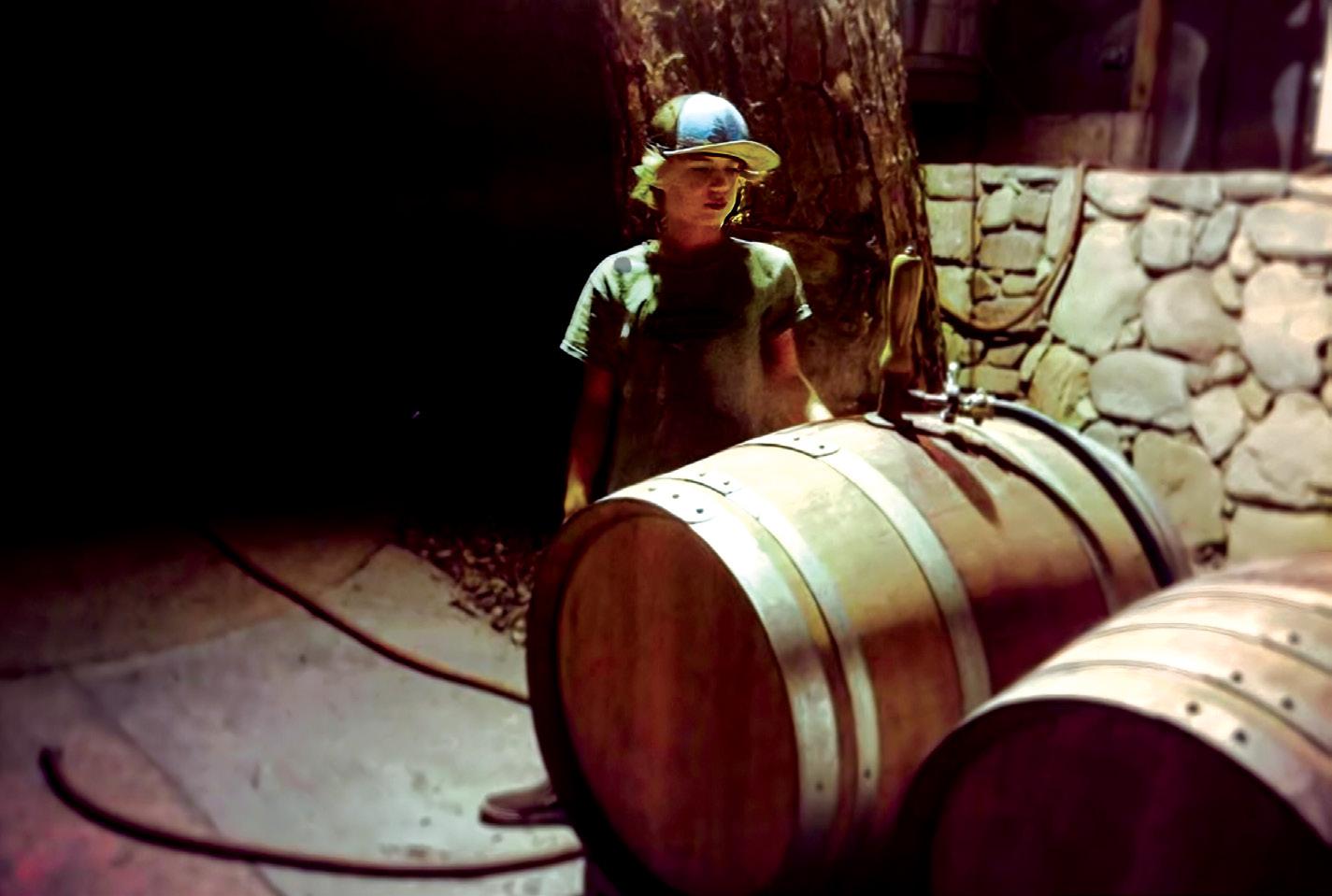

The concept of The Naturalist comes from the winemaker’s love of natural history — the spirit of exploration and discovery in every sip. “It’s you and the wine in a sensory study,” Sam says.
The roots of this vinous venture trace back to 2011, when Sam’s passion set him on a mission to redefine the essence of winemaking. Over the past decade, he not only honed his craft, but also emerged as a changemaker for organic viticulture.
“Wine is a luxury,” Sam believes. “It doesn’t need to be mass-produced and saturated with pesticides. It’s supposed to be relaxing, something that brings people together. I want my wine to be something that people can enjoy without worrying about how it’s going to affect them.”
At the heart of The Naturalist’s philosophy lies an unwavering commitment to authenticity. Each bottle tells a story of a meticulous process — no additives, all wild-fermented, and made using a groundbreaking method to eliminate the histamines that can cause inflammatory reactions in the body. In a landscape where grapes bear
124 OJAI MAGAZINE | SPRING ‘24
Harvest is an-all-hands-on-deck situation. Young man enlisted (conscripted is the word he used) to steam barrels for wine being pressed at 10:00p.m.
the burden of pesticide use, Sam stands firm, carefully vetting every vineyard he collaborates with.
Grapes, the eighth most pesticideladen crop, find sweet refuge in Sam’s conscientious approach. Grapes are an antioxidant, with many healing properties, but when sprayed with chemicals that don’t wash off and have been found to alter hormones and cause other harmful effects, the drawbacks can outweigh the benefits.
“Natural wine isn’t always organic. Organic is always natural,” says Aaron Singer, general manager of The Naturalist Tasting Room, located in the heart of downtown Ojai.
The Naturalist adheres to the true meaning of the word, but there is a difference between natural vs. organic in today’s marketplace. The lack of regulation around the term “natural” can lead to confusion. Many big brands use the word “natural” with no real basis. It’s a delicate dance between staying true to the essence of natural wine and navigating the marketing landscape.
The Naturalist label launched in late 2023 with a collection of eight wines, marrying tradition and innovation. They started with a Sangiovese and cabernet franc. Sam describes the cab franc as a fun variety to work with, “even more expressive and more interesting than cabernet sauvignon, with more rustic flavors.”
The winery’s ethos revolves around crafting natural, pure, and organic wines — free from preservatives and nurtured within a family-run farming environment.
What sets The Naturalist apart is not just its dedication to organic principles, but also its rigorous commitment to quality assurance. Everything is lab-tested to ensure the absence of toxic chemicals, pesticides, and the herbicide glyphosate. Glyphosate, used heavily to kill weeds and grasses, is a big concern for Sam. “It’s in wine in a big way,” he says.
The winery bears the USDAcertified organic stamp — a symbol of uncompromising standards. Many certification programs are available, from biodynamic, to organic (one of the more
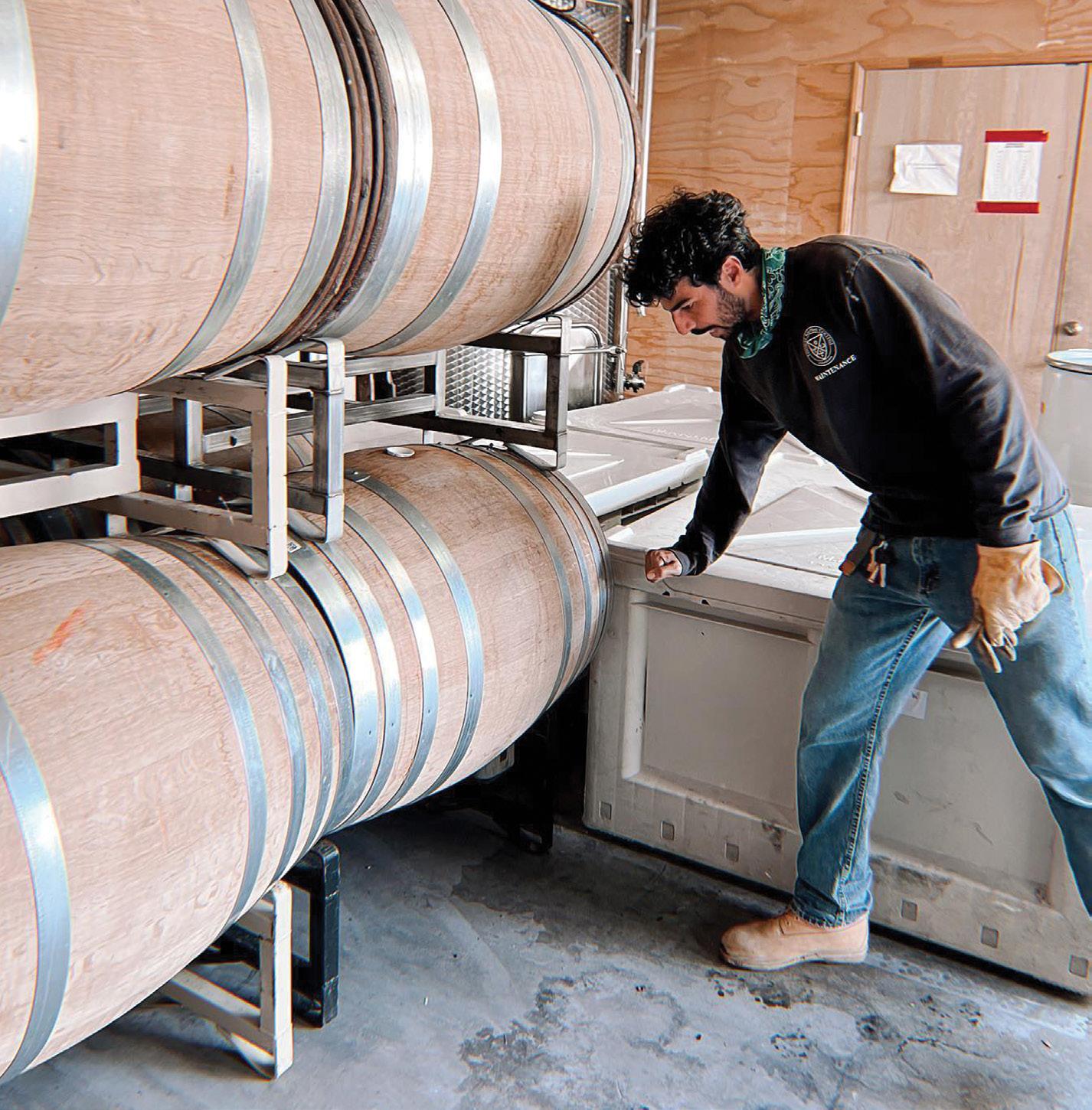
tightly regulated), to SIP (Sustainability In Practice), which is a five-tier certification program for winegrowers and winemakers who use sustainable practices verified by a third party.
Aaron, the Tasting Room manager, says one level of certification could be about organic grapes, another about the winemaking process. With all wine, however, the only requirement on a label is whether it contains sulfites (sulfurcontaining chemicals that help prevent oxidation and preserve freshness and flavor). Winemakers don’t have to indicate many other additives and preservatives on their labels.
A conventional vineyard that converts to organic practices might still have contaminants in the soil, including longlasting “forever” chemicals, aka PFAS. So even though they’re considered “organic,” Sam won’t work with them. Also, chemicals can “drift” from neighboring non-organic vineyards without high standards. The Naturalist makes the wine once, tests it for 400 different agrichemicals, then sees what comes through in the final product.
“It’s not an easy process,” Sam says. “And it’s really contemplative, in a lot of
ways. You have to get it right, every single detail. It takes so long to make a wine: a year of farming, a year of fermentation and aging, and then a year in bottle, is at least three years. So, at any time, you can mess that up. Organic can be tricky because you also can’t use conventional, ammonia-based fertilizers. So instead, we do cover-cropping with legumes in the offseason that produce a lot of nitrogen, and compost tea can be helpful to improve soil and vine health.”
Sam’s methods reach back to certain traditional practices, meaning handmade, handcrafted. Everybody asks him: What are you doing differently?
Sam’s response is that it’s the same process. “We’re using all of the same techniques; we’re just doing it to a really high degree of scrutiny.” And although techniques are available that would be considered organic — such as new processing equipment and ways to preserve wine, pasteurization, and flash fermentation — Sam’s focus is “nothing unconventional. If you’re not using any preservatives, you have way more risk of spoilage. So every single movement of the wine, every single operation has to be perfect. Which is more manageable to do on a small scale like ours.”
125
Barrel sampling for blending trials.
Some wine drinkers don’t equate good wine with organic wine, but Sam says this is a quantity-over-quality issue: The Naturalist produces about 100 barrels a year, making the wine somewhat exclusive due to its limited production.
Everything is hand-picked and sorted at the winery, then fermented in small lots. If you think more deeply about where your wine comes from, and how it’s made, you’ll likely have much more respect for those involved, especially the people who pick your grapes. Everything is at waist level, so you’re crouching down or in a big deep squat as you walk all night picking. Some compare it to the I Love Lucy episode where Lucy squashes grapes with her feet in a big vat. Sam, however, likens the process more to the episode where Lucy and Ethel make chocolate in a factory and everything is moving very fast down a conveyor belt.
“People just think I’m wearing an ascot and swirling a glass,” Sam tells me. “The harvest is the busiest time and it’s a grind. It’s 24/7 for almost three months. The fruits are coming in. It’s extremely physical. You’re moving things around on a forklift; you’re scrubbing out fermenters; and you’re hoisting barrels that can weigh up to 150
pounds. It takes a toll on the body. And you have to keep a sharp mind during that time frame, but it’s really fun.”
“The most stressful part is the bottling. You have years of work in a tank ready to go into bottle and everything is happening so quickly.”
Extended aging for natural wines is not favorable due to no added sulfur in the wines. “It’s nine to 12 months of aging for both red and whites,” says Sam. Once it’s done, it’s done. You can’t do anything more. And now you wait … The good news is organic wine lovers don’t have to wait. Although the winery isn’t open to the public, the tasting room is open year-round. Anyone can stop in for a tasting, whether or not you’re a wine club member. Members can choose a four- or eight-bottle membership, with the wine either delivered, or picked up four times a year at a discounted rate. Other member perks include free tastings with a guest, invitations to private events, and first dibs on new releases.
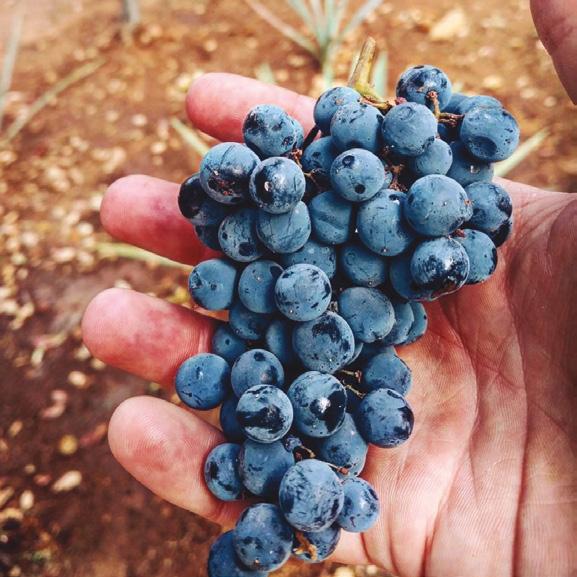
rosé, a sauvignon blanc, a Malbec, a cabernet sauvignon, and a petite sirah that’s the strongest and darkest, rich and high tannin in profile, with very dry, dark chocolate, mulberry, and blackberry notes.
The wines rotate a little each season, along with local artwork on the walls. You can always check the event calendar to come by for a tasting with a live music performance. Although no food is served, you are welcome to bring your own and nosh while tasting a glass or more, or a flight. Your pup is welcome as well. Sam says his favorite part of winemaking is “pouring my wine for people. And when they enjoy it, especially for what I do, because so many people have their own particular relationship with wine. … That’s really special, to give somebody a product that they can trust and enjoy.” Cheers.
Visit The Naturalist Organic Wine Tasting Room at 208 E. Ojai Ave. For more information, call 805-640-1255 or visit naturalistwine.com
In addition to the Sangiovese and cab franc, The Naturalist offers a Mourvèdre

126 OJAI MAGAZINE | SPRING ‘24

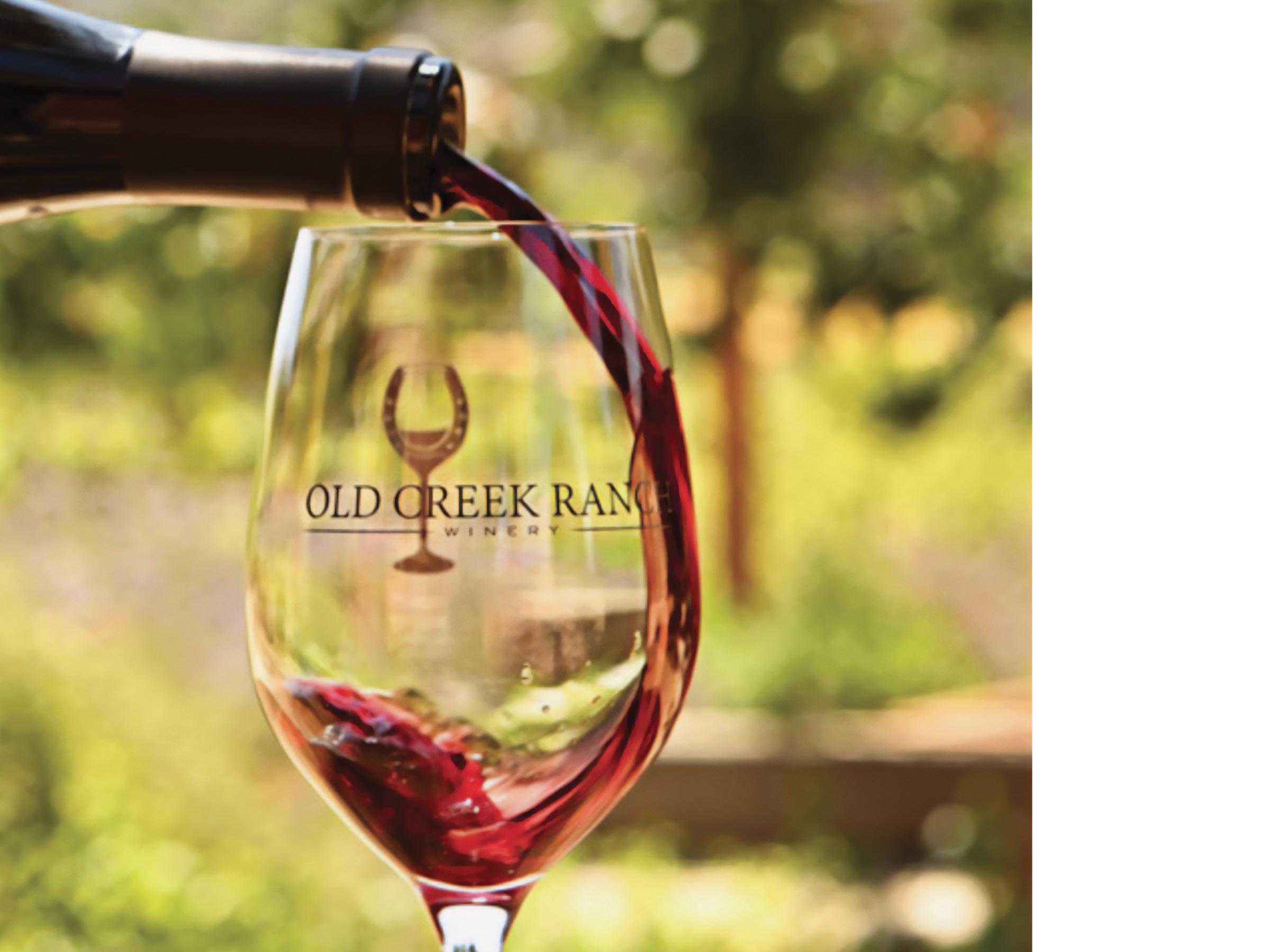


127 OJAI MAGAZINE | SPRING ‘24 Wine Tasting OPEN THURSDAY THROUGH MONDAY 11AM - 5 PM WALK-INS WELCOME Pet Friendly — Kids Under 2 Yrs & Over 13 Yrs Welcome 10024 Old Creek Rd, Ventura | (805) 649-4132 | www.oldcreekranch.com 2023


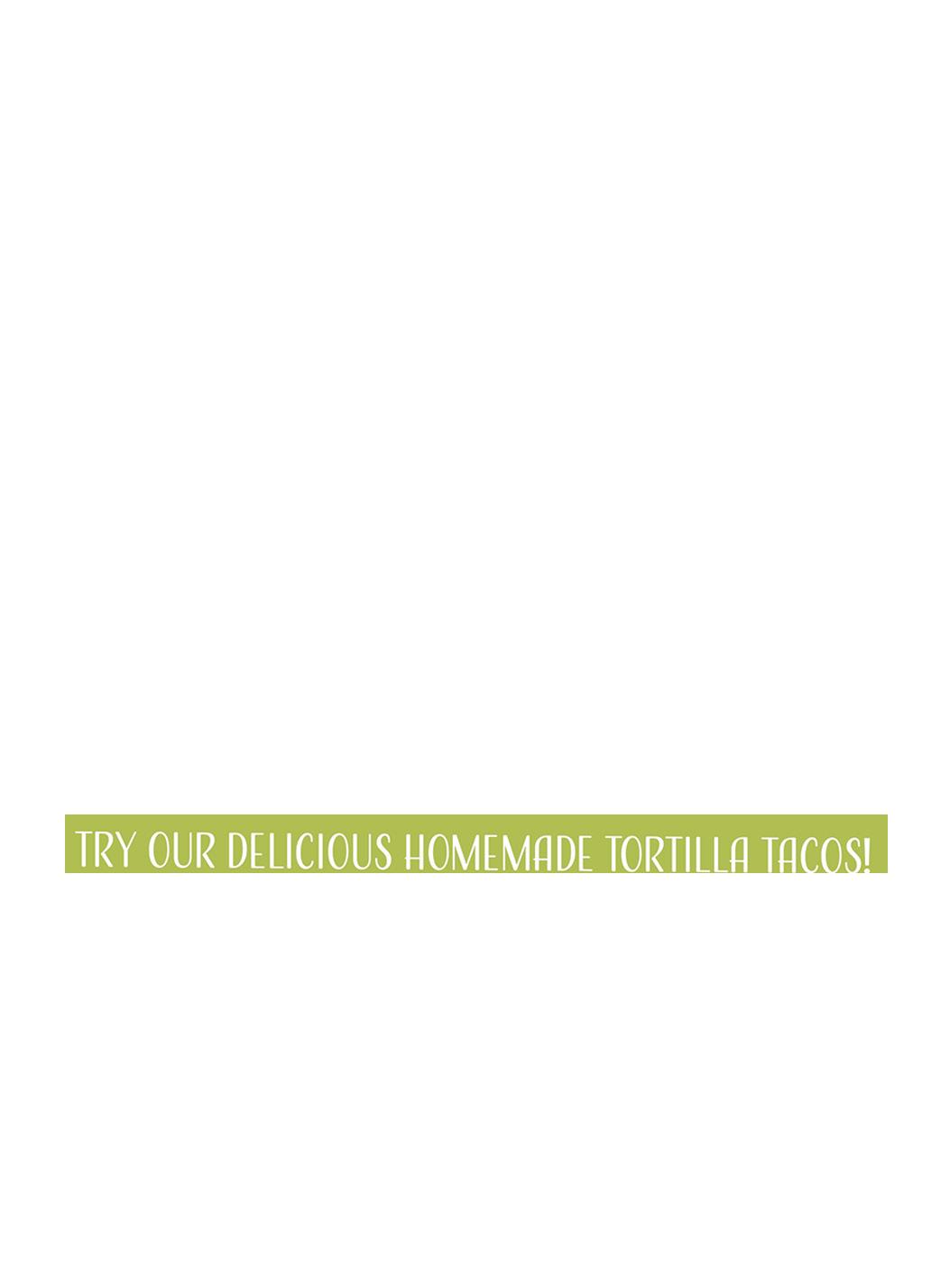
128 OJAI MAGAZINE | SPRING ‘24


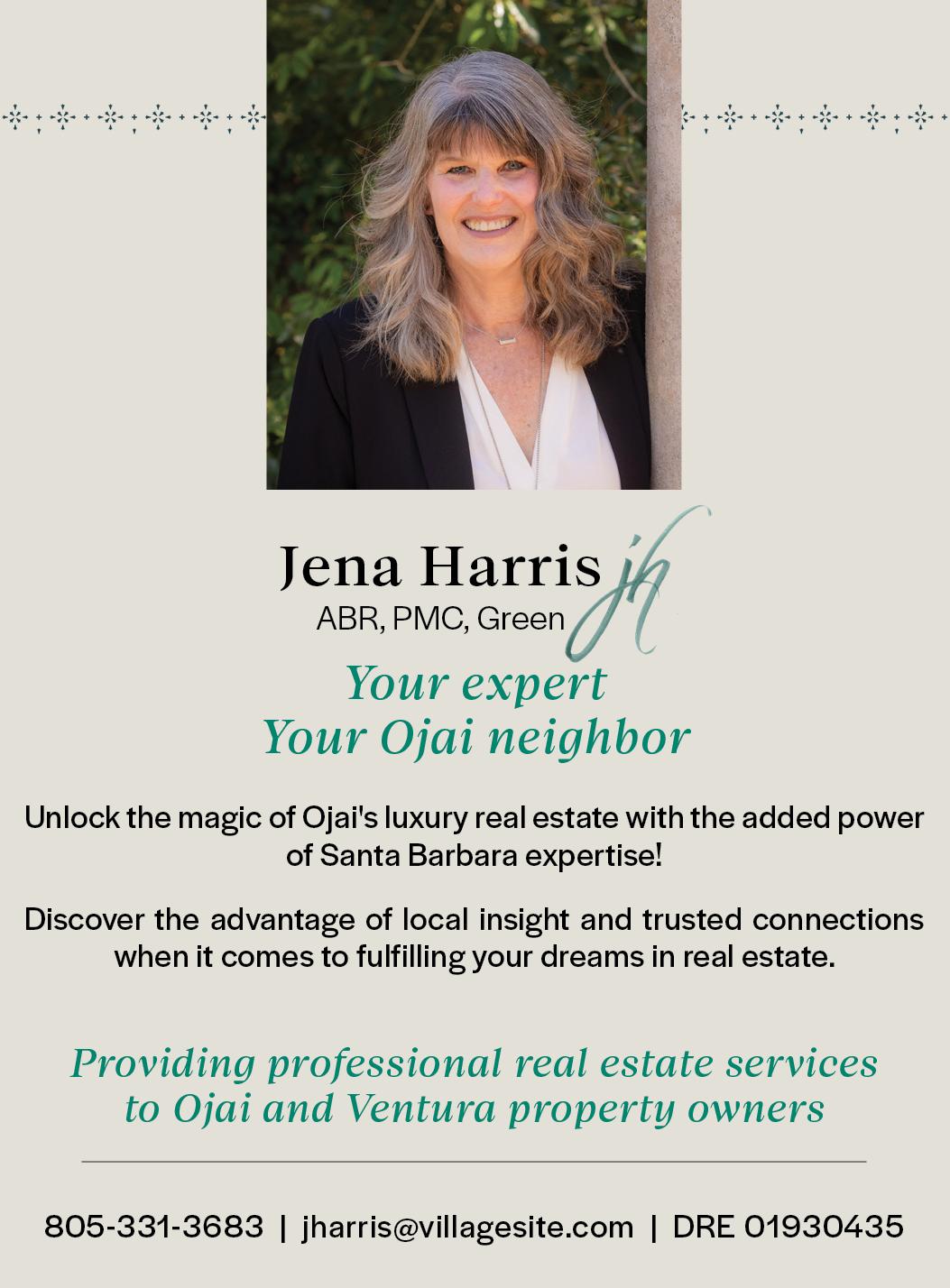
129 OJAI MAGAZINE | SPRING ‘24 Bryant Circle Mini Storage 412 Bryant Circle, Ojai 805.646.2354 • Free move-in truck • Moving and packing supplies • Security system with TV surveillance • On-site resident managers • Competitive rates • Convenient access hours 6am-10pm, seven days a week Visit our website bryantcircleministorage.com for more information 2023
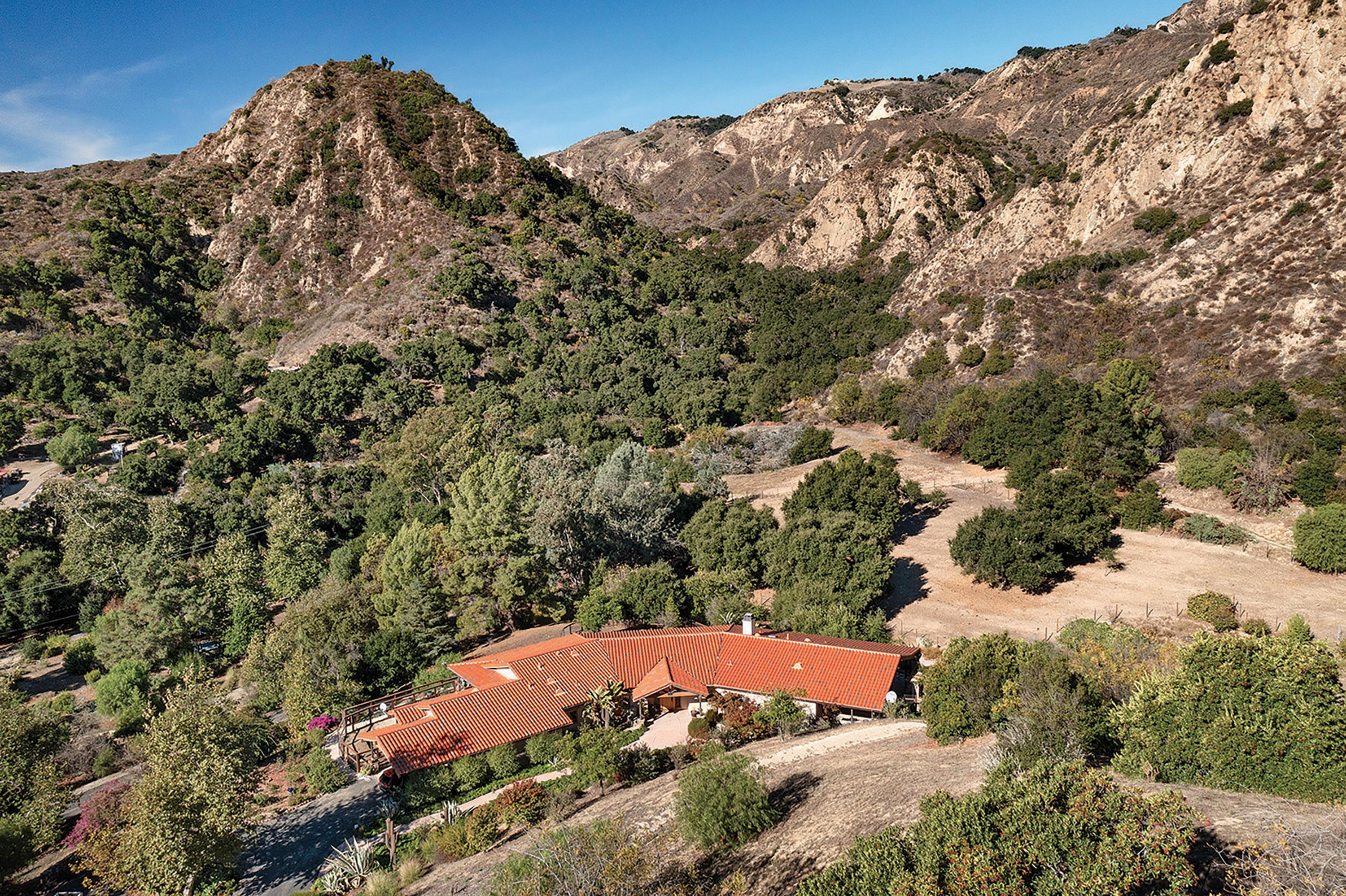


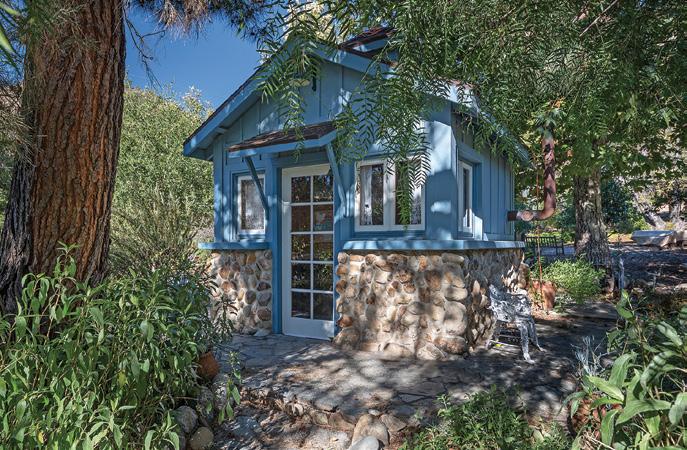
Little Orchard Farms is a once-in-a-lifetime property o ering privacy and location hidden up a private road, yet minutes from town. Two orchards and a fenced garden provide 40 varieties of fruits and vegetables grown without pesticides. There is also a chicken coop, fenced pasture, private pond, wells, hiking trails, and a separate studio. The one-story, ranch-style home features exposed-beam ceilings, remodeled kitchen and primary bath, infrared sauna, two copper bathtubs with mountain views on the patio, whole-house reverse osmosis system, and original tile work.
LittleOrchardFarms.com | $3,275,000
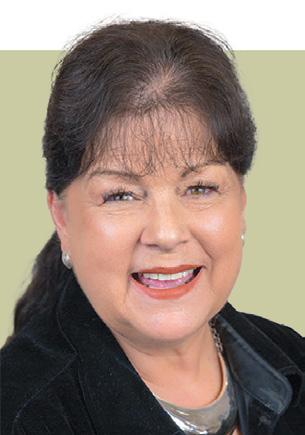
NORA DAVIS
The Davis Group
805.207.6177
nora@ojaivalleyestates.com
www.ojaivalleyestates.com
DRE 01046067
130 OJAI MAGAZINE | SPRING ‘24
LITTLE ORCHARD FARMS
©2024 LIV Sotheby’s International Realty. All rights reserved. All data, including all measurements and calculations are obtained from various sources and has not and will not be veri ed by Broker. All information shall be independently reviewed and veri ed for accuracy. LIV Sotheby’s International Realty is independently owned and operated and supports the principles of the Fair Housing Act.
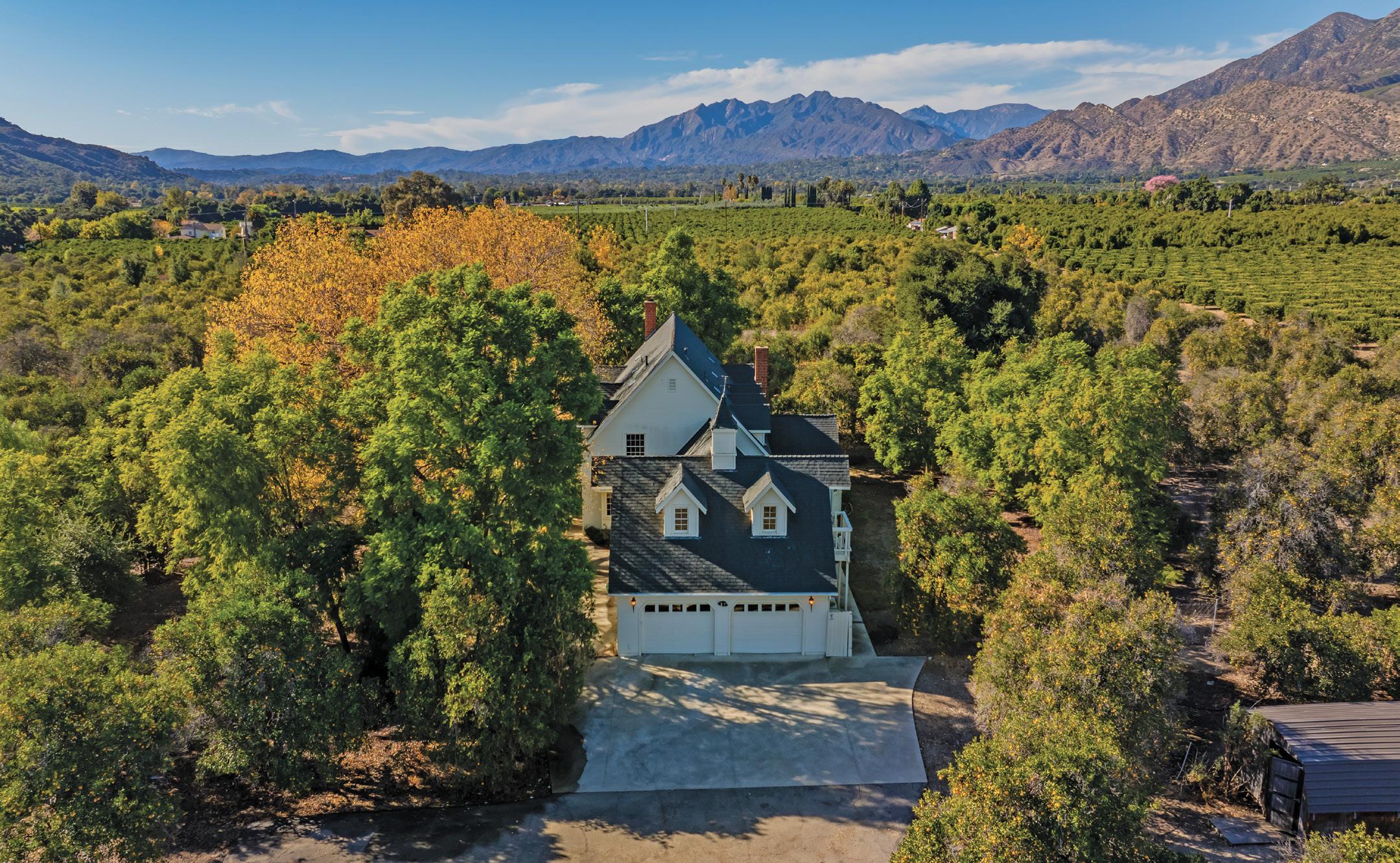

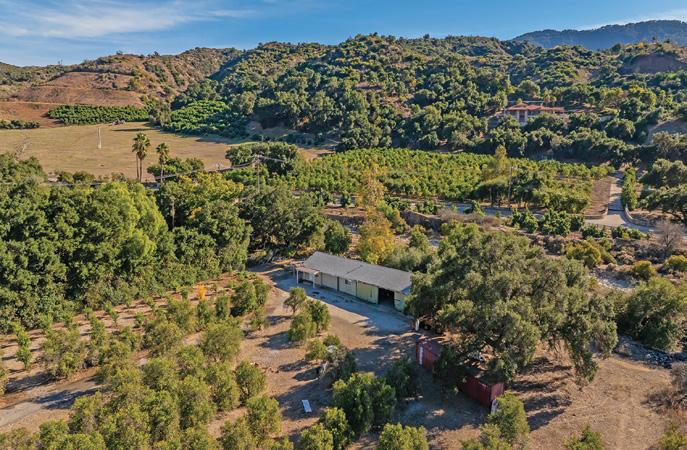
229 McNELL ROAD
First time on the market- A beautiful farmhouse with captivating views on approx. 43 acres. Set back from the road and hidden amongst an orange grove sits the main residence, an elegant farmhouse. The grandeur begins with the majestic entry leading to the great room with beamed ceilings and bar area, walls of windows and a brick replace anked by built-ins. The 3-bedroom, 3-bathroom home is a perfect blend of classic charm and modern amenities. Spread over 3,350 sq.ft. the well-appointed guest rooms o er a warm and inviting retreat for your guests. Oak ooring and co ered ceilings create a warm, inviting atmosphere. The spacious rustic brick kitchen is both functional and aesthetically pleasing which adjoins the formal dining room with vaulted wood beamed ceilings and a brick replace leading to the crafted dark-wood paneled study which could be used as a fourth bedroom. The spacious primary suite o ers comfort and tranquility showcasing impressive, exposed wood beams. This eco-conscious estate is equipped with solar panels, reducing energy costs and environmental impact including a backup generator system. The property includes two APN’s, a private water well and a 3-inch ag meter from casitas water. | $5,500,000
TYLER BROUSSEAU
Ojai Native
805.760.2213
tyler@ojaiforsale.com
www.OjaiForSale.com
DRE 01916136
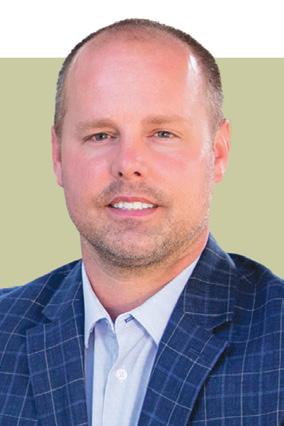
131 OJAI MAGAZINE | SPRING ‘24
LIV
©2024
LIV Sotheby’s International Realty. All rights reserved. All data, including all measurements and calculations are obtained from various sources and has not and will not be veri ed by Broker. All information shall be independently reviewed and veri ed for accuracy.
Sotheby’s International Realty is independently owned and operated and supports the principles of the Fair Housing Act.

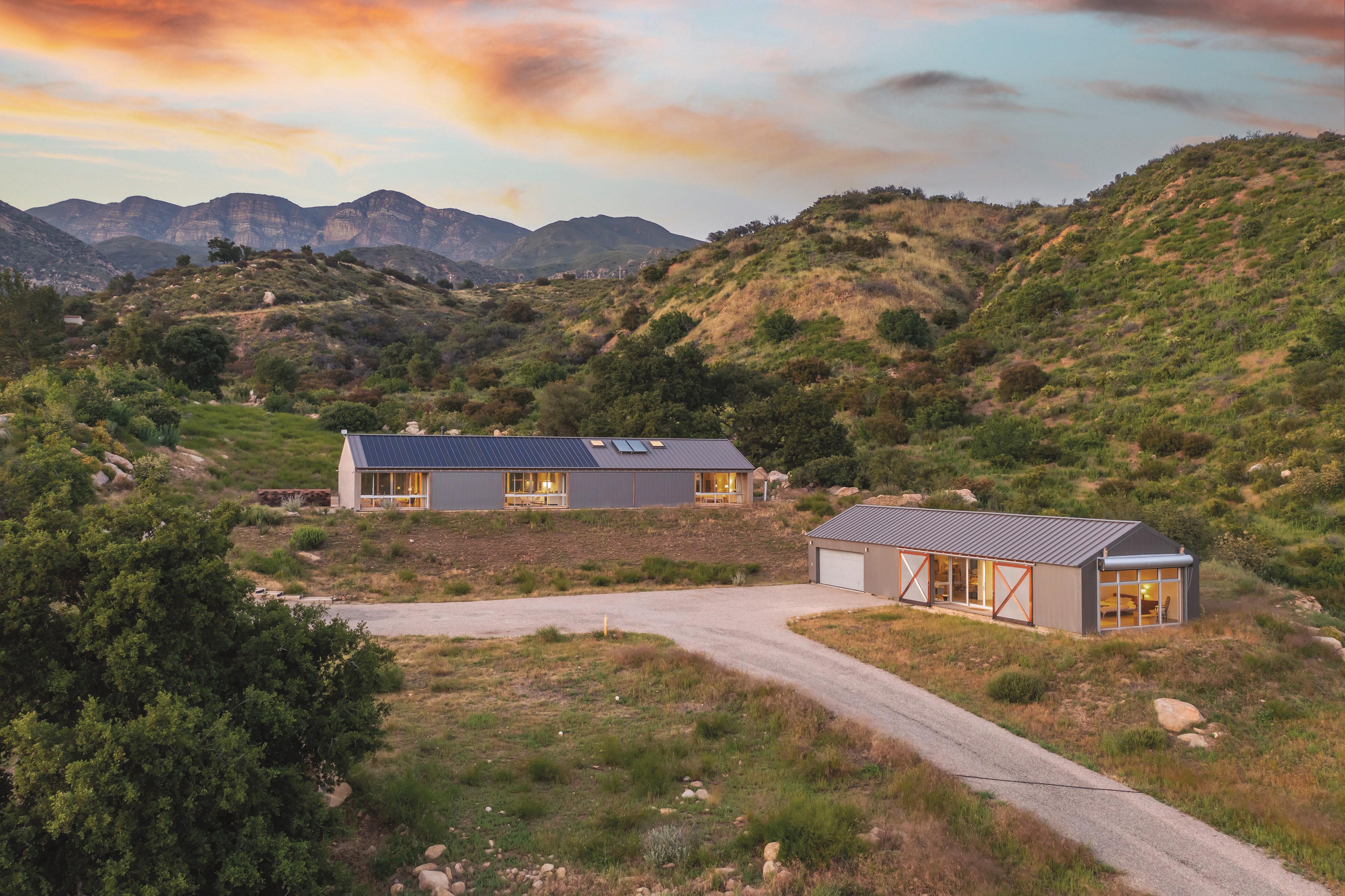
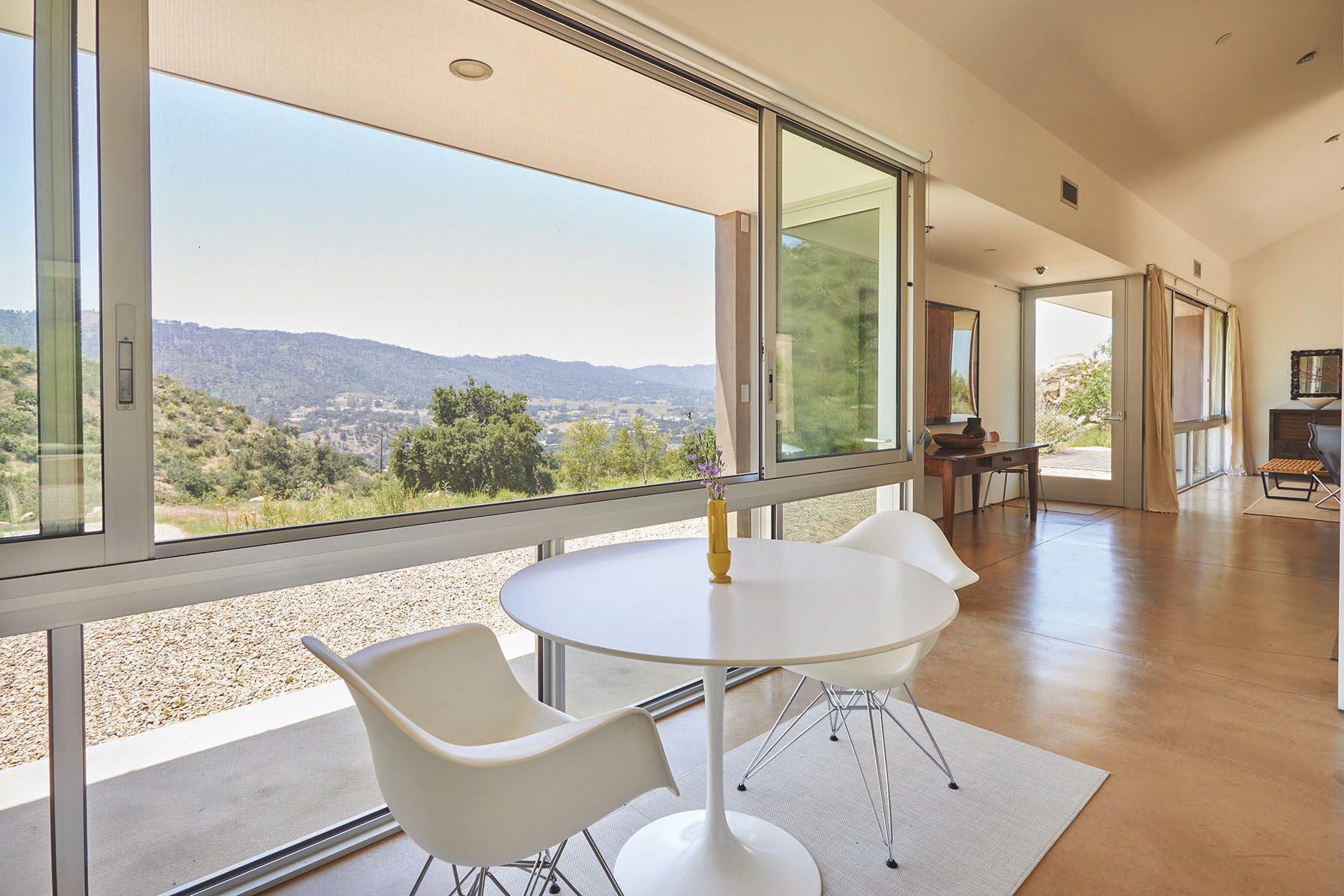




132 www.pattywaltcher.com pattywaltcher@mac.com (805) 340-3774 DRE# 01176473 I will help you discover the home that brings peace to your mind and heart © 2024 Berkshire Hathaway HomeServices California Properties (BHHSCP) is a member of the franchise system of BHH Affiliates LLC. BHHS and the BHHS symbol are registered service marks of Columbia Insurance Company, a Berkshire Hathaway affiliate. BHH Affiliates LLC and BHHSCP do not guarantee accuracy of all data including measurements, conditions, and features of property. Information is obtained from various sources and will not be verified by broker or MLS. Buyer is advised to independently verify the accuracy of that information. MINIMALIST WILDLAND SANCTUARY 12179KoenigsteinRdOjai.com On 44 pristine acres in Upper Ojai, this modern compound includes a 2700sf main house, a 900sf guest house, a pool and terraces with unparalleled privacy and magnificent views. Designed by its architect owners to be completely in harmony with the landscape, this property honors both nature and the fearless possibilities of contemporary design and construction. Offered at $5,250,000 Over 25 years of experience matching people and property in the Ojai Valley
























































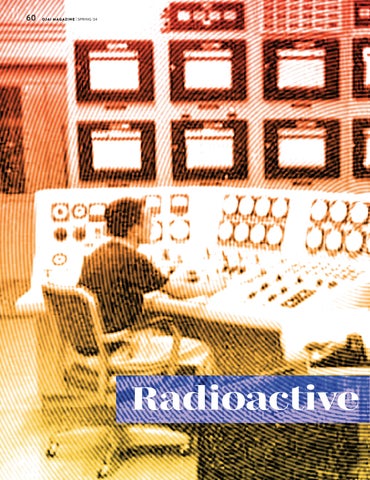
















 by HOLLY ROBERTS
Photo courtesy the Bryan family
by HOLLY ROBERTS
Photo courtesy the Bryan family
 At the 2011 Wimbledon Championships
At the 2011 Wimbledon Championships







 by KAREN LINDELL
by KAREN LINDELL






 Josh and Rebecca Tickell with their creative team (producer Eric Dillon, writer Johnny O’Hara, production supervisor Jason Martinez) and documentary film subjects, regenerative farmers Gabe Brown and Ray Archuleta, having a pre-protection creative brainstorming meeting.
Josh, Rebecca, Athena and Jedi Tickell at Big Picture Ranch in Ojai.
Photo: Mariana Schulze
Josh and Rebecca Tickell with their creative team (producer Eric Dillon, writer Johnny O’Hara, production supervisor Jason Martinez) and documentary film subjects, regenerative farmers Gabe Brown and Ray Archuleta, having a pre-protection creative brainstorming meeting.
Josh, Rebecca, Athena and Jedi Tickell at Big Picture Ranch in Ojai.
Photo: Mariana Schulze







 photos and story by
LAURA REARWIN WARD
photos and story by
LAURA REARWIN WARD
















 story and photos by DAVID LABELLE
story and photos by DAVID LABELLE

















 by KIT STOLZ
by KIT STOLZ












 by KAREN LINDELL
by KAREN LINDELL

 Mitsuko Uchida
Mitsuko Uchida





















 by ERIN LABELLE
by ERIN LABELLE



 Marcel Duchamp, Francis Picabia, and Beatrice Wood at the Broadway Photo Shop, NYC, 1917
Photo: Creative Commons
Marcel Duchamp, Francis Picabia, and Beatrice Wood at the Broadway Photo Shop, NYC, 1917
Photo: Creative Commons

















 by PERRY VAN HOUTEN
by PERRY VAN HOUTEN

















 by ALULA ALDERSON
by ALULA ALDERSON































 by KERSTIN KÜHN photos courtesy Totem Ranch
by KERSTIN KÜHN photos courtesy Totem Ranch

























 Top: Chile Rellenos
Above: Roasted cauliflower tostada
Top: Chile Rellenos
Above: Roasted cauliflower tostada



 by MIMI WALKER
by MIMI WALKER












 by TIFFANY PAIGE
photos by SAMUEL TULBERG
by TIFFANY PAIGE
photos by SAMUEL TULBERG



























